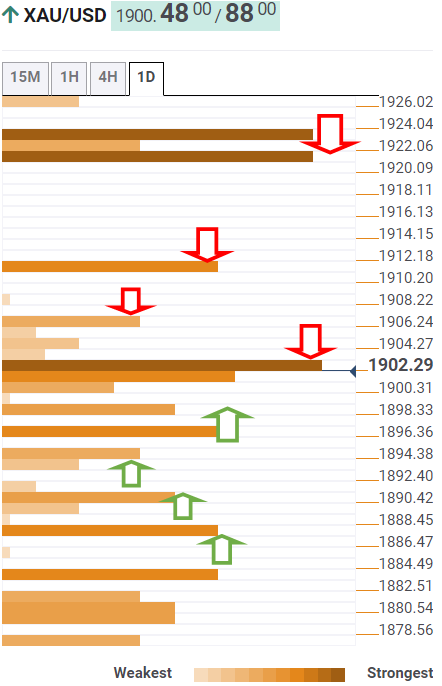- Analytics
- News and Tools
- Market News
CFD Markets News and Forecasts — 05-05-2022
- USD/CHF is experiencing a minor pullback at around 0.9850, upside remains favored.
- The DXY printed a fresh 19-year high at 103.94 on an extremely aggressive expected hawkish tone by the Fed.
- Investors are awaiting the release of the Swiss jobless rate and US NFP.
The USD/CHF pair is displaying back and forth moves in a narrow range of 0.9840-0.9854 in the Asian session after a minor correction. Earlier, the asset scaled higher strongly as the risk-on impulse faded and the US dollar index (DXY)’s appeal improved swiftly. The major is eyeing to reclaim weekly highs at 0.9890.
The Swiss franc didn’t find any action after the in-line release of the Swiss Consumer Price Index (CPI). The yearly Swiss CPI landed at 2.5%, similar to the expectations but a little higher than the prior print of 2.4%. The lower inflation figure is not compelling for any hawkish tone by Swiss National Bank (SNB)’s Governor Thomas J. Jordan going forward. For further guidance, investors will focus on the monthly Swiss Unemployment Rate, which is seen at 2.2%.
Meanwhile, the US dollar index (DXY) shrugged off the impact of the monetary policy announcement by the Federal Reserve (Fed) and printed a fresh 19-year high at 103.94. Now, investors are awaiting the release of Friday’s US Nonfarm Payrolls (NFP). A preliminary estimate indicates additions of 391k jobs in the labor market against the prior print of 431k. An outperformance from the expectations will bolster the odds of a 75 basis point (bps) rate hike by the Federal Reserve (Fed) in June as an extremely tight labor market will weigh inflationary pressures on the rising labor cost index.
- USD/CAD fades bounce off weekly low, pares the biggest daily gains in a fortnight.
- Oil prices remain firmer despite OPEC’s offer as geopolitical risks keep favoring energy bulls.
- BOE’s inflation, growth forecasts triggered a bout of risk-aversion and reversed post-Fed optimism the previous day.
- Fed’s expectations of slower NFP growth, BOC’s hawkish comments highlight jobs report for clear directions.
USD/CAD pares the latest gains around 1.2830 as traders turn cautious ahead of the key employment data from the US and Canada on Friday. The Loonie pair’s latest weakness could also be linked to the recently firmer prices of WTI crude oil, Canada’s key export, as well as the market’s consolidation amid a wait for full markets.
The quote refreshed the weekly low earlier on Thursday before the risk-off mood propelled prices towards posting the biggest daily gains in two weeks. The Bank of England’s (BOE) forecasts suggesting doubt-digit inflation and economic recession could be cited as the key catalysts for the latest risk-aversion that recalled the USD/CAD bulls.
While cheering the sour sentiment, the Loonie pair couldn’t justify the firmer oil prices, mainly favored the by Thursday’s verdict of the OPEC+ group, comprising the Organization of the Petroleum Exporting Countries (OPEC) countries and allies including Russia. The oil cartel announced to continue with the current policy of raising monthly output by 432K barrels per day (BPD).
Also supporting the oil prices, as well as weighing on the risk catalysts is the European Union’s (EU) oil embargo on Russian imports. That said, the WTI crude oil prices stay mildly bid around $107.70 by the press time after refreshing a six-week high the previous day.
While portraying the risk-aversion, Wall Street indices slumped more than 3.0% each while the US 10-year Treasury yields rallied 3.40% on a daily closing while rising to the fresh high in late 2018 beyond 3.00%. As a result, the US Dollar Index (DXY) also regained its strength and poked April’s multi-month high around 104.00.
The USD/CAD prices are likely to remain sluggish as traders await the key economics. The scheduled jobs report become even more important after the Bank of Canada’s (BOC) hawkish stand and the Fed’s forecasts assuming an absence of major employment growth going forward.
Forecasts suggest the headline US Nonfarm Payrolls (NFP) to ease to 391K from 431K whereas the Unemployment Rate may also decline to 3.5% from 3.6%. On the other hand, Canadian Unemployment Rate is expected to soften to 5.2% from 5.3% with the likely reduction in the Net Change in Employment to 55K, versus 72.5K prior.
Technical analysis
Although 21-day EMA puts a floor under short-term USD/CAD prices around 1.2730, the quote needs to stay beyond 1.2830, comprising nearby previous resistance, to aim for further upside.
- US dollar rallies to fresh cycle highs as markets turn risk-off.
- The start of the new month and rebalancing has seen a shuffle back into the safe haven US dollar.
The US dollar rallied on Thursdays as bulls picked up the currency at a discount figuring the risks associated with global stagflation and ongoing geopolitical tensions will keep the US dollar in favour. At 103.549, the DXY index is 1% higher ahead of the Tokyo open, a touch lower than the overnight bull cycle high of 103.942.
The initial move was illustrated as a prospective scenario in the prior day's post-Fed-analysis here: US dollar and yields sinking as Powell dials down market expectations of 75bp move. More on this below.
Meanwhile, global growth fears mount following a series of worrisome economic data and ongoing geopolitical risks. The Chinese PMIs remain in contraction territory and the COVID lockdowns are disrupting supply chains. Contagion of the Ukraine crisis in the commodity markets has left a dark cloud over global growth prospects and is subsequently damaging high beta currencies and the euro.
Then, the nail in the coffin came as the Bank of England warned of stagflation and weak German data that was showing that industrial orders in March suffered their biggest monthly drop since last October sent the euro below 1.05 the figure.
The greenback was subsequently boosted by safe-haven buying as global equities come back under pressure. The S&P 500 was down 3.6% and the Euro Stoxx 50 fell 0.8%. The yield on the US 10-year Treasury note surged, rising 9.8bps to 3.03% which also helped to propel the US dollar higher ahead of today's critical Nonfarm Payrolls.
NFP could be the clincher for US dollar bulls
The Nonfarm Payrolls is a major risk and could well set the tone for the following weeks ahead of the next Fed rate decision.
''A strong payrolls report could perversely push the market to price in more tightening as the Fed reduced its optionality at its most recent meeting,'' analysts at TD Securities said.
''That leaves a resilient USD vs EUR and yen very much the path of least resistance. A softer wages print should help to temporarily take the edge off but this will be short-lived until evidence of a peak/moderation in CPI emerges.''
Meanwhile, analysts at ANZ Bank explained, ''whilst the Fed is not currently considering a 75bps rate increase, that guidance is based on expectations that the trend increase in monthly Nonfarm payrolls will slow and core inflation is stabilising. But there are no guarantees at all that that will be the case.''
''Demand for labour in the US remains very strong and core services inflation is rising steadily. The April non-farm payroll and employment reports tomorrow night, therefore, carry a lot of significance,'' the analysts added.
DXY technical analysis
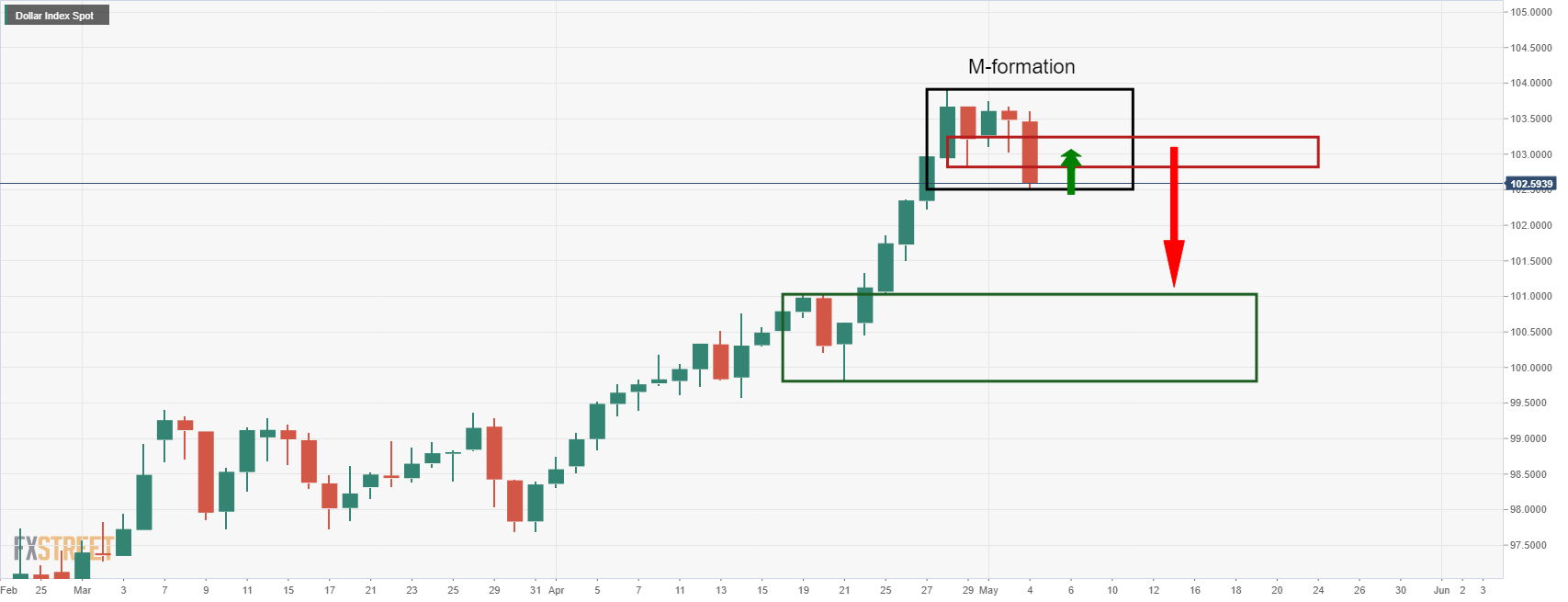
However, the bulls are staying the course at the moment and have cleared the resistance as follows:

Should the above price action play out, the inverse head & shoulders would be a bullish factor on the daily chart.
- USD/JPY is advancing towards 130.56 as higher US NFP forecasts bolstered 75 bps rate hike chances.
- More additions to the US job market will push the labor cost index higher.
- The Japanese yen will resume its downside move after a short-lived pullback.
The USD/JPY pair is looking to recapture weekly highs at 130.56 after a minor pullback as the profit-booking kicks in. The asset witnessed a strong upside move on Thursday after the risk-perceived currencies lost their aura as a rebound in the risk-on impulse after the announcement of the interest rate decision by the Federal Reserve (Fed) faded.
Fed’s monetary policy-based rally vanished after the odds of a 75 basis point (bps) rate hike in the June meeting bolstered. Although Fed Chair Jerome Powell stated while addressing the media that a 75 bps rate is not into consideration, investors still bet on a bumper rate hike figure amid soaring inflationary pressures. The US economy is enjoying a tight labor market. The Unemployment Rate is well below the targeted figure and job opportunities are scaling higher. Soaring additions in the labor market are indicating a higher labor cost index, which may ramp up price pressures and eventually higher inflation further.
Ongoing higher inflationary pressures have raised the importance of the US Nonfarm Payrolls (NFP), which will release on Friday. The additional jobs are seen at 391k against the prior print of 431k.
Meanwhile, the Japanese yen has started declining after a pause as mounting pressure on households’ real income is impacting the economy. Higher fuel bills and other commodity prices have dampened the real income of the household and have also widened their fiscal deficit. Apart from that, an ultra-loose monetary policy by the Bank of Japan (BOJ) will keep yen on the tenterhooks.
- Silver licks its wounds above short-term key support line after the biggest daily fall in two weeks.
- Steady RSI hints at continuation of bearish grind unless crossing $23.00 resistance confluence.
Silver (XAG/USD) stays defensive at around $22.50 during the sluggish Asian session on Friday. In doing so, the bright metal consolidates the latest losses while keeping the bounce off a one-week-old support line.
The XAG/USD prices took a U-turn from 50-SMA and a downward sloping trend line from April 26, currently around $23.00.
The pullback moves gain support from the steady RSI and the lower-high formation to keep sellers hopeful.
Though, a clear downside break of the immediate support line, near $22.30, becomes necessary for the bullion before challenging the weekly bottom of $22.12.
Following that, February’s low around the $22.00 threshold and the yearly trough of $21.95 will be crucial to watch.
Alternatively, recovery moves remain elusive until crossing the $23.00 resistance, a break of which will need validation from the latest swing high near $23.30.
In a case where silver prices remain firmer beyond $23.30, the $24.00 round figure and the 200-SMA level near $24.50 could challenge the buyers.
Silver: Four-hour chart
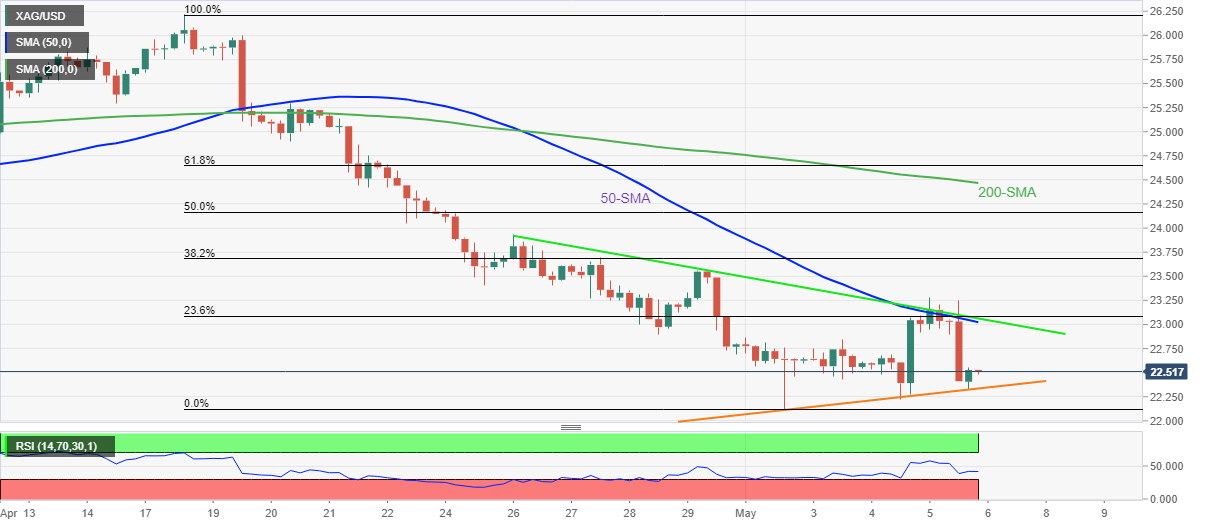
Trend: Further weakness expected
- The cable has printed a fresh yearly low at 1.2325.
- Momentum oscillator RSI (14) has shifted into a bearish range of 20.00-40.00.
- A pullback towards the 20-EMA will be an optimal sell for investors.
The GBP/USD pair is experiencing a weak rebound after printing a fresh yearly low of 1.2325 on Thursday. The cable witnessed sheer downside after slipping below the previous week’s low of 1.2411. The asset has surrendered its crucial support of 1.2400 and has been exposed to more downside risks.
A decisive downside move below the previous week’s low at 1.2411 is likely to be re-tested for more short buildups. The pound bulls lost their strength after a bear cross of 20- and 50-period Exponential Moving Averages (EMAs) at 1.2532.
The Relative Strength Index (RSI) (14) has shifted into the bearish range of 20.00-40.00, which signals a fresh leg of weakness ahead.
Should the asset test the 20-EMA at 1.2420, it will be an optimal bargain opportunity for the market participants to initiate short positions, which will drag the asset towards the fresh yearly lows and 29 June 2020 low at 1.2325 and 1.2252 respectively.
On the flip side, pound bulls may dominate the asset if it oversteps Wednesday’s high at 1.2638. This will send the asset towards the round level resistance at 1.2700, followed by April 26 high at 1.2773.
GBP/USD hourly chart
-637873878748405663.png)
US inflation expectations, as per the 10-year breakeven inflation rate per the St. Louis Federal Reserve (FRED) data, justify the market’s fresh fears of skyrocketing inflation ahead while rising for the third consecutive day by the end of Thursday’s US session.
In doing so, the inflation gauge extends the week-start bounce off the lowest levels since April 13 while flashing 2.87% at the latest. The same justifies the market’s risk-off mood and helps the US dollar to regain its charm, which in turn weighs on the riskier assets like commodities and Antipodeans.
Given the firming fears of inflation, traders will closely watch today’s US Nonfarm Payrolls (NFP) for April as the Fed’s latest rejection of 75 basis points (bps) of a rate hike may have assumed no further worsening of employment and price pressures.
“Whilst the Fed is not currently considering a 75bps rate increase, that guidance is based on expectations that the trend increase in monthly nonfarm payrolls will slow and core inflation is stabilizing. But there are no guarantees at all that that will be the case,” said the Australia and New Zealand Banking Group (ANZ).
Also read: US April Nonfarm Payrolls Preview: Analyzing gold's reaction to NFP surprises
- EUR/USD remains pressured after taking a U-turn from one-week high.
- Failures to stay beyond 50-SMA, receding bullish bias of MACD hint at further declines.
- Bears aim for the latest multi-month low unless crossing 100-SMA.
EUR/USD stays depressed at around 1.0540 during Friday’s initial Asian session, after the bear’s return to the table the previous day.
The major currency pair’s failures to keep the post-Fed rebound beyond the short-term key SMAs join the receding bullish bias of the MACD to favor sellers.
That said, the latest weakness aims for an upward sloping trend line from April 28, surrounding 1.0510, ahead of challenging the 1.0500 threshold.
In a case where the EUR/USD fails to rebound from the 1.0500, it can drop to the previous month’s bottom, also the lowest level since 2017, around 1.0470.
It should be noted, however, that the 61.8% Fibonacci Expansion (FE) of the pair’s moves between April 25 and May 05, around 1.0425, will challenge the EUR/USD bears afterward.
Meanwhile, recovery moves may initially aim for the 50-SMA and the recent swing high, respectively around 1.0560 and 1.0640.
However, EUR/USD bulls will remain cautious until witnessing a clear break of the 100-SMA, close to 1.0690 at the latest.
EUR/USD: Four-hour chart

Trend: Bearish
- GBP/JPY eyes more weakness as BOE has warned signs of recession.
- The UK corporate are failing to create more jobs and households are facing the heat of higher living costs.
- The Japanese yen is enjoying the pullback season but the downside is still intact.
The GBP/JPY pair is displaying back and forth moves in a tight range of 160.54-161.50, followed by a firmer downside move after the asset failed to overstep 164.00 on Thursday. The asset has turned into negative territory after the rate hike decision by the Bank of England (BOE) in the previous trading session.
The announcement of a rate hike came in line with the expectations of the market. The BOE elevated its interest rates by 25 basis points (bps) to 1%. This is the consecutive fourth rate hike by the BOE with a 6-3 majority for a quarter to a percent rate hike. The minority members advocated for a 50 bps rate hike. Despite an expected announcement, the sterling faced intense selling pressure after the BOE warned of signs of recession as households are facing the headwinds of higher living costs due to scaling oil prices and energy costs. Along with that, UK corporates are struggling to generate more job opportunities, which can affect the labor market and eventually the fifth largest economy in the world.
Meanwhile, the Japanese yen is enjoying a tad longer pullback season however, the downside is still intact. The ultra-loose monetary policy by the Bank of Japan (BOJ) will stay for longer. More stimulus into the economy will remain the major agenda of the BOJ, which will keep yen on the edge.
- AUD/USD remains sidelined around pre-Fed levels after the recent two-day zero-sum game.
- BOE-inspired inflation, growth fears join headlines from China, EU to reverse post-Fed gains.
- Equities slumped, yields rallied and the US dollar regained its charm during the risk-off US session.
- RBA Monetary Policy Statement, US jobs report will be important for immediate directions.
AUD/USD treads water around 0.7110, after losing nearly 150 pips the previous day, as traders await the key catalysts while taking a breather following the heavily volatile sessions. That said, the Aussie pair’s latest inaction could also be linked to the cautious mode ahead of full markets as Japan finally returns to trading, following China’s trading restart on Thursday, after a long break.
The Aussie pair witnessed a notable downside, reversing all the gains made during the post FOMC trading session, as global markets turned risk-off amid skyrocketing fears of growth and inflation.
The early Thursday’s optimism in the market couldn’t withstand the Bank of England’s (BOE) forecasts suggesting doubt-digit inflation and economic recession that rocked the boat in the US as well.
Not only the BOE but worsening covid conditions in China and the European Union’s (EU) readiness for more sanctions on Russia also weighed on the market sentiment and drowned the risk barometer AUD/USD pair. Additionally, the US Securities and Exchange Commission (SEC) added over 80 Chinese firms to the list of companies facing probable delisting from the US exchanges, which portrayed fresh Sino-American tussles and weighed on the risk appetite as well.
Following this, Wall Street indices slumped more than 3.0% each while the US 10-year Treasury yields rallied 3.40% on a daily closing while rising to the fresh high in late 2018 beyond 3.00%. As a result, the US Dollar Index (DXY) also regained its strength and poked April’s multi-month high around 104.00.
Looking forward, the Reserve Bank of Australia’s (RBA) justification of the larger-than-expected rate hike, via the Monetary Policy Statement (MPS), will be crucial for the AUD/USD traders, especially after the latest inflation and growth fears, which in turn could favor sellers if perceived negative. Also important will be the monthly employment report from the US as the Fed’s 50 bps rate hike hoped no major challenges from the jobs and inflation front.
Read: Nonfarm Payrolls Preview: Could employment become a new headache for the Fed?
Technical analysis
AUD/USD pair’s pullback from 100-DMA, around 0.7265 by the press time, eyes to retest the weekly bottom near 0.7030. Also acting as an upside filter is the confluence of a downward sloping trend line from early April and the 200-DMA, near 0.7285.
- The EUR/JPY remains trapped in the 136.50-137.50 range.
- Sentiment remains negative amidst central bank tightening and China’s Covid-19 lockdowns, which threaten to derail the post-pandemic economic recovery.
- EUR/JPY Price Forecast: The head-and-shoulders clouds the prospects of a higher EUR.
The EUR/JPY remains in choppy trading amidst a dismal market sentiment, courtesy of central bank tightening, alongside China’s weak service and composite PMIs, and also the acknowledgment of its coronavirus crisis by the Fed and the Bank of England. As the Asian Pacific session begins, the EUR/JPY prints minimal gains of 0.10% and is trading at 137.24.
US equities finished Thursday’s session with hefty losses, between 3.12% and 4.99%. Interest rate hikes in the week by the Federal Reserve and the Bank of England spurred appetite for safe-haven peers. Additionally, ongoing China lockdowns caused by the Covid-19 crisis were acknowledged by both central banks, which said it might disrupt supply chains and spur high inflationary pressures.
EUR/JPY Price Forecast: Technical outlook
The EUR/JPY is upward biased, though a head-and-shoulders chart pattern keeps the pair downward pressured. Nevertheless, the price action of the last four days shows the cross consolidating around the 136.50-137.50 range. If the EUR/JPY breaks upwards and achieves a daily close above 138.00, that would open the door for further upside, which could invalidate the head-and-shoulders.
If the EUR/JPY breaks on top of the abovementioned range, the first resistance would be 138.00. Once cleared, the following resistance would be the April 25 daily high at 139.20. A breach of the latter would expose the YTD high at 140.00.
On the other hand, the EUR/JPY first support would be the 137.00 mark. If EUR/JPY bears break that level, that will expose the 136.00 figure, followed by the head-and-shoulders neckline around 135.00-20.
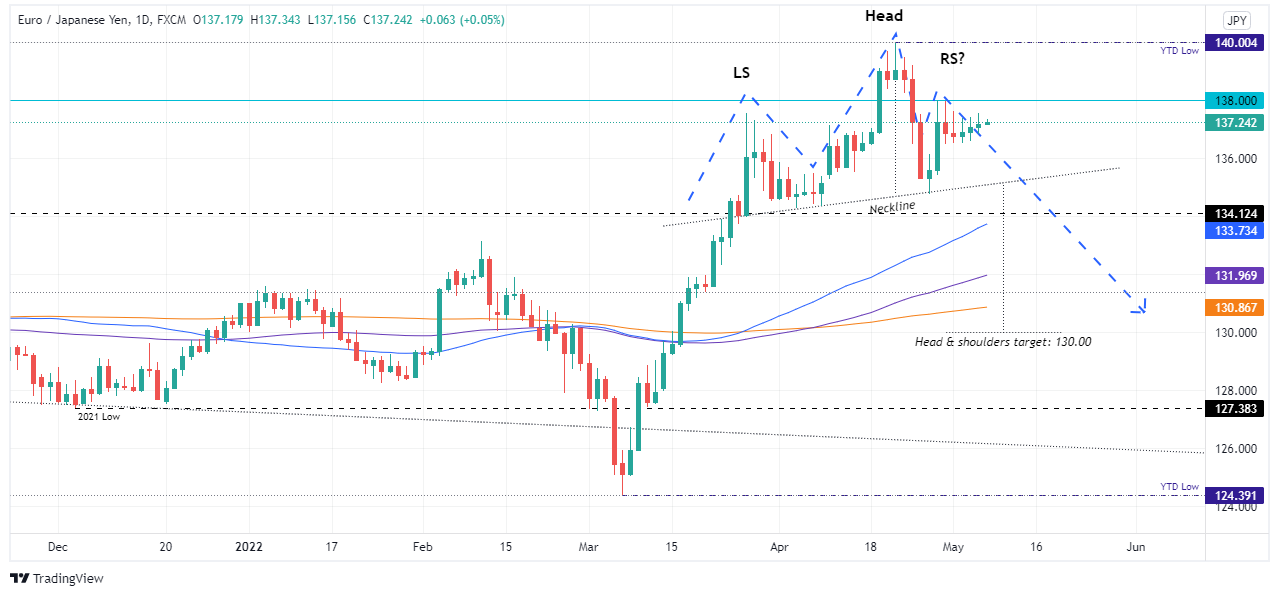
- Gold price is declining lower to near $1,860.00 as uncertainty over the US NFP release looms.
- An extremely tight labor market could add inflationary pressures.
- The formation of an Inverted Flag chart pattern could weigh pressure on gold prices.
Gold Price (XAU/USD) is oscillating in a narrow range of $1,872.95-1,881.46 as investors are awaiting the release of the US Nonfarm Payrolls (NFP), which are due on Friday. The asset witnessed a steep fall after testing the barricade of $1,910.00 and is aiming to slip further to near $1,860.00 amid uncertainty over the US employment data.
The announcement of the monetary policy by the Federal Reserve (Fed) resulted in a firmer rebound in the gold prices but most of them have been surrendered as the uncertainty of the interest rate decision has been carry-forwarded by the US NFP. The additions in the US labor market are expected t land at 391k against the prior print of 431k.
Despite the solid hangover of multi-decade inflation, the US economy is experiencing a tight labor market, which clears that the growth has not vanished and the economy is far from recession fears. However, a tight labor market could also fuel inflationary pressures as more job openings will result in higher wages, which eventually will add up price pressures and an extremely tight labor market would raise the odds of a 75 basis point (bps) by the Fed.
Gold technical analysis
The precious metal is forming an Inverted Flag chart pattern on a smaller timeframe. The formation of the above-mentioned chart pattern indicates a consolidation after a sheer downside, which will be followed by a further downside move. The 50-period Exponential Moving Average (EMA) at $1,883.86 is declining, which adds to the downside filters while the 20-EMA at $1,879.15 is acting as a major resistance for the gold prices. Meanwhile, the Relative Strength Index (RSI) (14) is oscillating in the 40.00-60.00 range but is likely to attract volatility after slipping below 40.00 decisively.
Gold 15-minute chart
-637873844908153750.png)
- West Texas Intermediate (WTI) crude oil is higher.
- Markets weigh OPEC and EU proposal to ban Russian oil.
At 108.60, West Texas Intermediate (WTI) crude oil is higher on the day by some 1% as the market continued to react to the European Union's proposal to ban imports of Russian oil. Additionally, OPEC+ has ratified their planned 432k bpd quota increase.
The EU's move to ban imports of Russian crude oil and refined products has helped to underpin the upside in the oil prices while several countries worry about the impact of cutting off Russian oil imports stood in the way of agreement.
The European Commission President Ursula von der Leyen announced the oil embargo on Wednesday and also other punishments that have included sanctions on Russia's top bank and a ban on Russian broadcasters from European airwaves. However, the proposal has not yet been approved by member countries. With all being said, still, some speculated that the ban was not the reason for the price increase since Russia has been able to find other buyers for its crude exports.
"The proposal provides for a transitional period of up to eight months, and had already been reported in gazettes for several days. It is therefore hard to see why yesterday's price response should have been so dramatic,'' Commerzbank analyst Carsten Fritsch said.
- The AUD/JPY paired Wednesday’s gains and retreated from weekly highs amidst a 1.14% loss.
- The central bank’s tightening and China’s lockdowns could slow down the global economy.
- AUD/JPY Price Forecast: Upward biased, though a wall of solid resistance lies around 94.00.
The AUD/JPY slumps from weekly highs after the US central bank decided to lift rates on Wednesday, triggering a risk-on market mood, which boosted risk-sensitive currencies like the AUD, the NZD, and the CAD. Nevertheless, on Thursday, a violent shift in sentiment witnessed flows towards safe-haven peers, ultimately favoring the Japanese yen. At the time of writing, the AUD/JPY is trading at 92.58.
US equities finished Thursday’s session with huge losses, between 3.12% and 4.99%. Rate increases by the Federal Reserve on Wednesday, and the Bank of England on Thursday, dented appetite for riskier assets. At the same time, both central banks acknowledged China’s lockdowns, adding that it might disrupt supply chains and spur high inflationary pressures.
On Thursday, the AUD/JPY opened around Wednesday highs around 93.70, and in the Asian session, it probed the 94.00 mark. Nevertheless, as sentiment shifted, the AUD/JPY broke the market structure lows around 93.33 in the hourly chart and accelerated towards Wednesday’s daily lows around 92.26.
AUD/JPY Price Forecast: Technical outlook
The AUD/JPY daily chart shows the pair is in an uptrend. The daily moving averages (DMAs) below the spot price aim high. However, it is worth noting that the 50-DMA confluences with the April 27 swing low, each around 90.25 and 90.43 respectively, meaning that a negative shift in sentiment could send the AUD/JPY tumbling towards the 50-DMA. Nevertheless, unless that scenario plays out, the AUD/JPY is upward biased.
That said, the AUD/JPY first resistance would be 93.00. A breach of the latter would expose the May 4 daily high at 93.82, followed by the March 28 daily high at 94.32 and then the YTD high at 95.74.

Analysts at ANZ Bank have revised their farmgate milk price forecast for the 2021-22 season down 40c to $9.30/kg milksolid (MS). This is the bottom end of Fonterra’s current forecast range of $9.30-$9.90/kg MS.
''Our forecast for the 2022-23 season has dropped 80c to $8.50/kg MS as commodity prices are anticipated to keep falling in the coming months.''
''The NZD is assumed to appreciate steadily across our forecast period to reach USD0.69 by the end of the 2022 calendar year.''
- NZD/USD bears pile in again as the US dollar attracts a safe-haven bid.
- DXY rallies to fresh bull cycle highs, sinking the bird ahead of NFP.
At 0.6421, NZD/USD is down some 1.88% after falling from a high of 0.6568 to a low of 0.6393 as investors move back into the US dollar as a discount. The greenback rallied to a fresh bull cycle high as per the DXY index that measures the US dollar vs. six major rivals.
''The Kiwi is significantly lower this morning, having slid around 1½ cents from yesterday’s peak as post-Fed optimism faded, the USD regained its erstwhile solid footing, equity indices sank and bond yields surged,'' analysts at ANZ Bank explained.
''There wasn’t really anything Kiwi-specific in the mix; rather it was just a global tornado of risk capitulation. Readers will be aware that we had been expecting a post-Fed risk rally, and there were always question marks about how long-lived it would be, but few likely would have picked this quick a turnaround.''
The catalyst today came from a bearish rate hike from the Bank of England, warning of price pressures and wage deflation, and ultimately putting the fear of stagflation into the markets. Additionally, the economic data from outside of the US continues to disappoint with Chinese PMI's sinking deeper within already contracting territory.
Weak German data that was showing that industrial orders in March suffered their biggest monthly drop since last October hammered down the coffin for the euro on Thursday. Consequently, the greenback was boosted by safe-haven buying as global equities come back under pressure.
''Price action of this sort will likely leave a sour taste in many people’s mouths, and in the wake of it, one has to consider the possibility that the typical early-cycle USD fade gets hijacked by volatility (and not just the Ukraine crisis and BoJ policy),'' analysts at ANZ Bank warned
Eyes turn to NFP
It is now all about the Nonfarm Payrolls.
''Whilst the Fed is not currently considering a 75bps rate increase, that guidance is based on expectations that the trend increase in monthly Nonfarm payrolls will slow and core inflation is stabilising. But there are no guarantees at all that that will be the case,'' analysts at ANZ Bank explained.
''Demand for labour in the US remains very strong and core services inflation is rising steadily. The April non-farm payroll and employment reports tomorrow night, therefore, carry a lot of significance.''
- The USD/CHF recovered all the ground shed post-Fed and is gaining 1.32%.
- A dismal market mood, spurred by the central bank’s tightening, and China’s covid crisis, threatens to disrupt the global economic recovery.
- USD/CHF Price Forecast: If USD/CHF bulls reclaim 0.9900, a move towards parity is on the cards.
The Swiss franc is losing ground against the buck, and the USD/CHF continues to reach a new YTD high after each of the last seven trading sessions amidst a dismal market mood. At 0.9852, the USD/CHF is rallying in the day, though retreated from early daily and current YTD highs around 0.9890.
Wall Street is in a middle of a stock blood bath, as reflected by the market sentiment. Central bank “aggressive” tightening, elevated US Treasury yields and a possible economic slowdown in China, spurred by the zero-tolerance Covid-19 policy, keep investors on their toes.
In the case of the USD/CHF, the pair reversed Wednesday’s profits after dipping to weekly lows reached on May 2 at around 0.9713 but staged a comeback and at the time of writing, is probing May 4 daily high at 0.9852.
USD/CHF Price Forecast: Technical outlook
The USD/CHF is upward biased from a daily chart perspective, as shown by the daily moving averages (DMAs) sitting below the exchange rate. However, the Relative Strength Index (RSI), well within the overbought territory at 79.01, might suggest that the pair is about to peak, nevertheless, it is aiming higher.
With that said, the USD/CHF’s first resistance would be March’s 23 daily high at 0.9901. Once cleared, the next step would be the parity at 1.000.
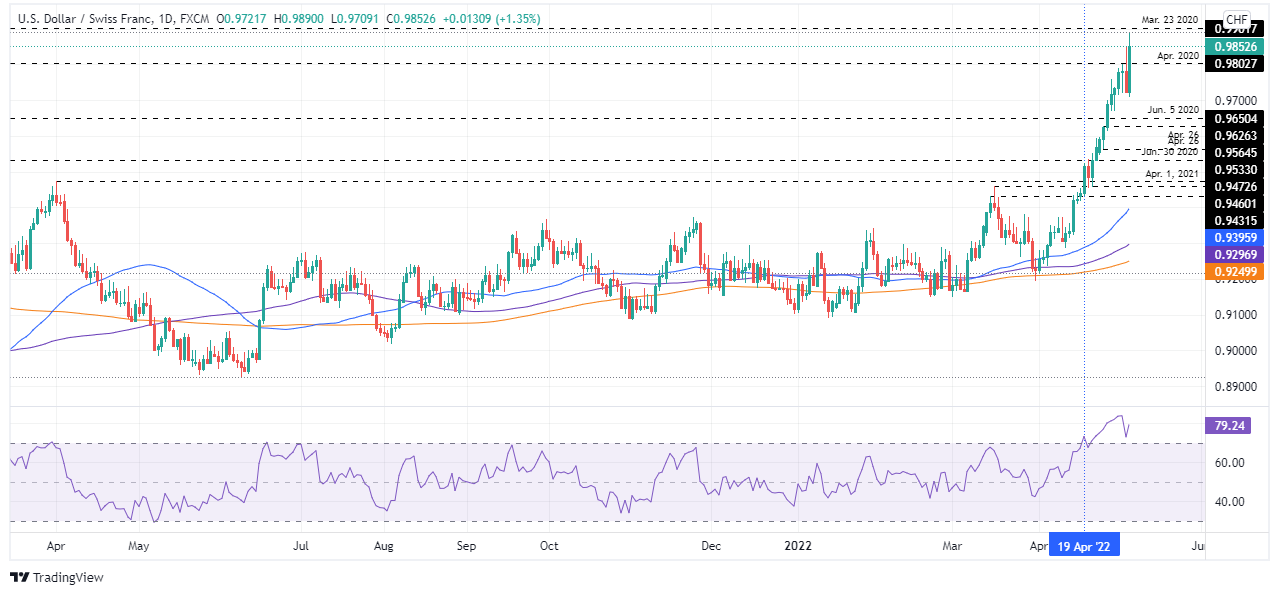
- EUR/USD bears are moving in for the kill to break 1.05 the figure.
- Eyes are on the monthly support that guards the risk of a break below parity.
- The NFP data will be key in this regard as the US dollar bulls look for a reason to stay the course.
At 1.0520, EUR/USD is down some 0.9% in late trade on Wall Street. The price dropped from a high of 1.0641 to a low of 1.0492 on the day with the US dollar soaring at the start of the North American shift. The euro was sold off in the wake of damaging data from the eurozone and ongoing concerns over the Ukraine crisis.
Investors are looking ahead at the prospect of a summer of discontent as global growth fears mount following a series of worrisome economic data and ongoing geopolitical risks. Chinese PMIs remain in contraction territory and the COVID lockdowns disrupting supply chains combined with the contagion of the Ukraine crisis in commodity markets has left a dark cloud over global growth prospects.
Then, the Bank of England warning of stagflation and weak German data that was showing that industrial orders in March suffered their biggest monthly drop since last October hammered down the coffin for the euro on Thursday. The greenback was subsequently boosted by safe-haven buying as global equities come back under pressure.
DXY, an index that measures the greenback vs. six rivals, is currently trading at 103.59 and is 1.06% higher on the day after rallying from a low of 102.352 to a new cycle high of 103.942. The move comes following the Federal Reserve the prior day affirming that it would take aggressive steps to combat soaring inflation.
The greenback was initially sold off as markets sold the fact yesterday when the Fed hiked by 50bps, as expected. However, there was a cohort of investors expecting a more aggressive move and guidance from the Fed's chairman, Jerome Powell, during the press conference. Instead, the dollar dropped sharply when the Fed chairman, dialled back on prospects of 75bps hikes.
Looking ahead, a lower appetite for emerging markets combined with the Fed's focus on fighting inflation are all factors that would be expected to underpin the greenback. Friday's Nonfarm Payrolls are going to be important in this regard.
The moves in the markets come ahead of Friday's showdown event in the US jobs market. The Nonfarm Payrolls (NFP) is a major risk and could well set the tone for the following weeks ahead of the next Fed rate decision.
''A strong payrolls report could perversely push the market to price in more tightening as the Fed reduced its optionality at its most recent meeting,'' analysts at TD Securities said.
''That leaves a resilient USD vs EUR and yen very much the path of least resistance. A softer wages print should help to temporarily take the edge off but this will be short-lived until evidence of a peak/moderation in CPI emerges.''
Should the jobs data come in strong, it could exacerbate the fall in the euro that is already testing the bull's commitments around 1.05 the figure:
EUR/USD technical analysis
As per the prior day's post-Fed analysis in both the DXY and euro, the price indeed reverted to test and penetrate the neckline of the W-formation.
Prior analysis:
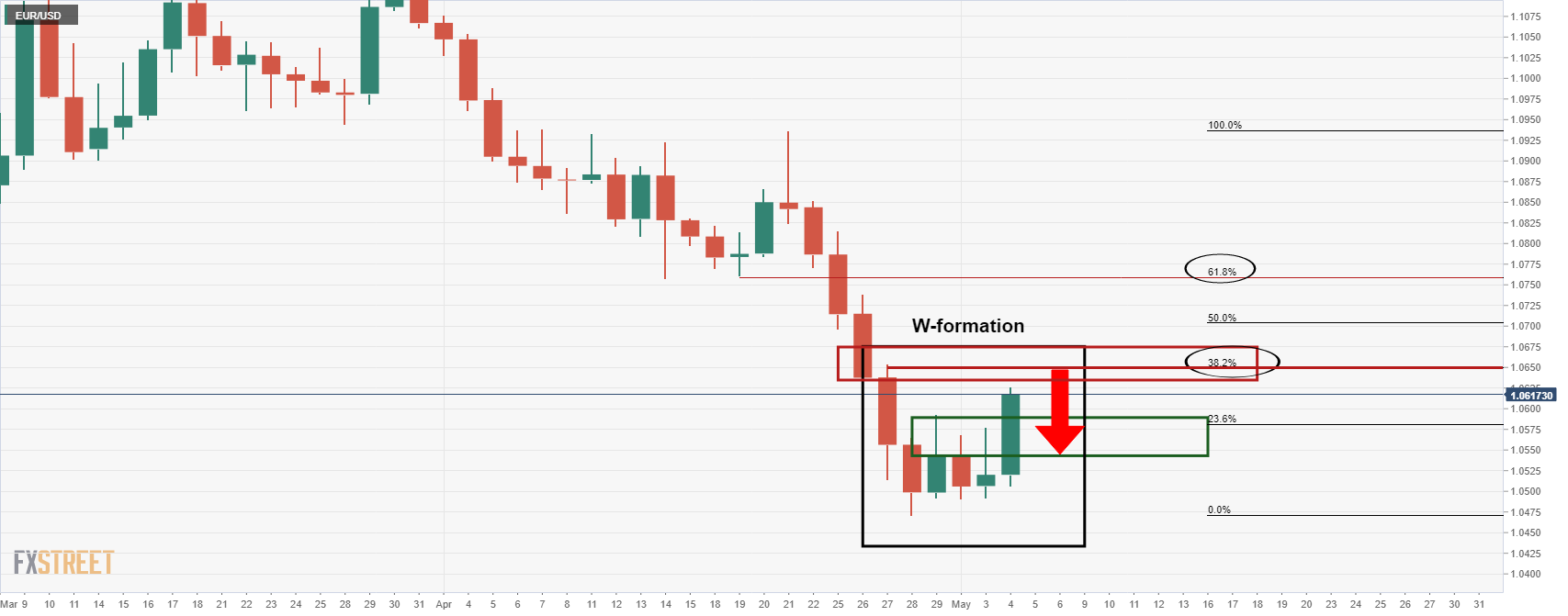
The price came into a handful of pips from the 38.2% Fibonacci retracement level of the prior bearish impulse. The market has sunk to challenge the neckline of the W-formation, penetrating to print below 1.05 the figure on the day:

A break of the neckline followed by a bearish close will open the door for further downside ahead, as per the monthly chart:
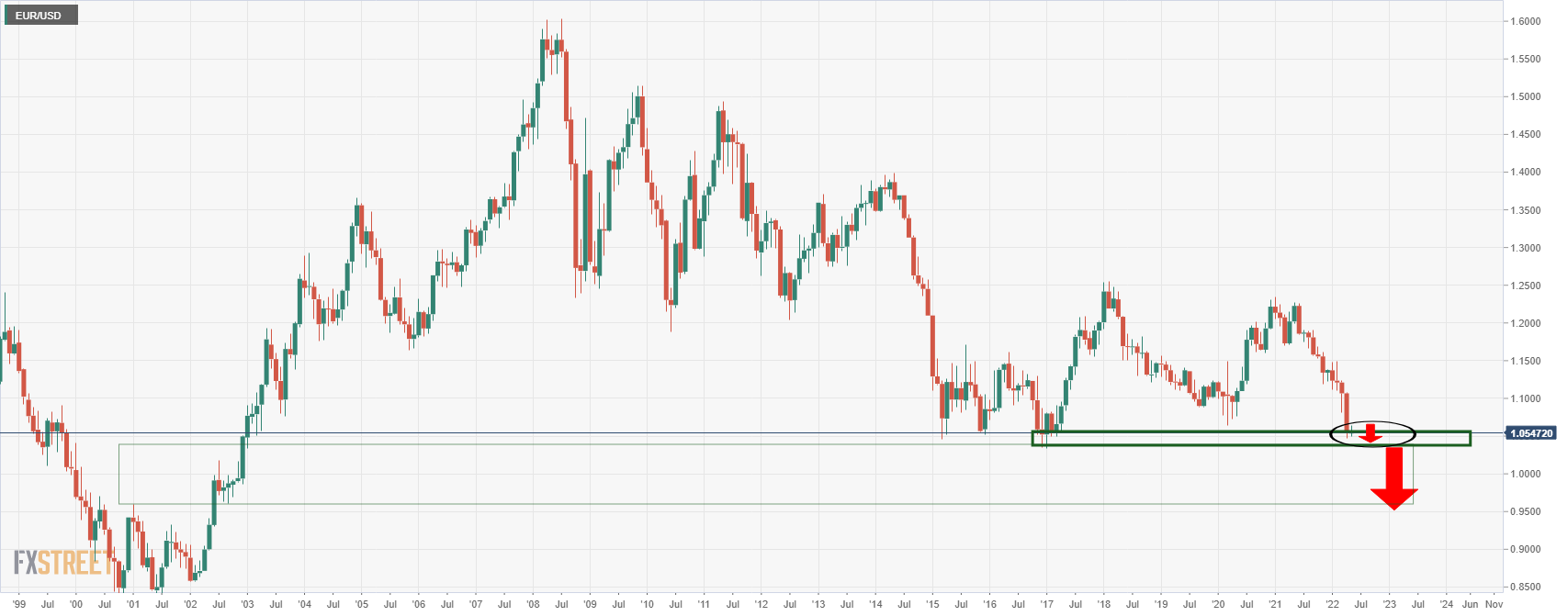
What you need to take care of on Friday, May 6:
The American dollar recovered all the ground shed post-Fed and even reached fresh weekly highs against some of its major rivals as financial markets entered panic mode.
The catalyst came from the Bank of England monetary policy meeting. The central bank raised interest rates by 25 bps to 1.0%, agreed by all voting members. However, the central bank downwardly revised its growth estimates for this year and the next one, warning the UK will fall into recession before the year-end, adding that inflation will likely have two digits by the same time. As a result, the GBP/USD pair fell to 1.2324, its lowest since June 2020.
Stagflation-related fears hit US trading desks, with Wall Street collapsing and government bond yields soaring to their highest in four years. The yield on the 10-year Treasury note hit an intraday high of 3.10%, stabilizing in the American afternoon just below such a high.
Ahead of the close, the Dow Jones Industrial Average is down over 1,300 points, the Nasdaq Composite sheds roughly 6%, while the S&P 500 is down 4.20%.
The EUR/USD pair returned to the 1.0500 area after touching a weekly high of 1.0641. The shared currency is among the weakest USD rivals, as the Union is struggling to replace Russian energy while the ECB stands well beyond the curve, likely to discuss a rate hike not early than July.
Meanwhile, the OPEC+ agreed to increase oil supply by 432K bpd in June to cool down overheating prices. The barrel of WTI is currently trading at $108.30 a barrel, up for the day.
On the other hand, Gold Price collapsed. The bright metal surged beyond the $1,900 threshold at the beginning of the day but ended it at around $1,870, unable to resist the greenback’s strength.
Commodity-linked currencies were sharply down, with AUD/USD now trading below 0.7100 and the USD/CAD at around 1.2850.
The greenback advanced against safe-haven currencies, with USD/CHF reaching 0.9889, its highest since March 2020. USD/JPY trades a handful of pips above 130.00.
The focus now shifts to US employment figures, as the country will publish on Friday the April Nonfarm Payrolls report.
Like this article? Help us with some feedback by answering this survey:
- The AUD/USD is making a U-turn and is losing 2.33% during the day.
- The central bank’s tightening and China’s Covid-19 lockdowns cloud the global economic outlook.
- AUD/USD Price Forecast: Failure at the 100-DMA exacerbated the 160-pip fall, as bears eye 0.7000.
The Australian dollar losses ground and gave back Wednesday’s gains amidst a risk-off market mood, courtesy of central bank tightening, alongside China’s weak service and composite PMIs, and also the acknowledgment of its coronavirus crisis by the Fed and the Bank of England. At the time of writing, the AUD/USD is trading at 0.7093.
Central bank tightening and China’s Covid-19 lockdowns dampened the market mood
The market sentiment dampened as the Bank of England’s press conference was undergoing in the middle of the European session. The BoE hiked rates by 25-bps in line with expectations and expressed its concerns about China’s ongoing Covid-19 crisis, which according to the BoE, threatens to hit supply chains again and add to inflation pressures. Adding to the abovementioned, the Fed mentioned in the FOMC statement that “… COVID-related lockdowns in China are likely to exacerbate supply chain disruptions.”
In a note to clients, analysts at Brown Brothers Harriman (BBH) wrote that the Chinese economy “is clearly staggering from Xi’s COVID Zero policy. While policymakers have pledged more stimulus, it is unlikely to be very effective until the hard lockdowns have ended.”
Reflection of the previous mentioned are US equities, which are plunging as the New York session winds down. Contrarily, US Treasury yields are soaring, with the US 10-year Treasury yield, reaching 3.10% for the first time since 2018, underpinning the greenback. The US Dollar Index, a gauge of the buck’s value against a basket of peers, records gains of 1.24% and sits at 103.782.
Meanwhile, on Wednesday, the Fed continued taking measures to tame inflation. The US central bank lifted rates by 0.50%, up to the 1% threshold, and announced the beginning of Quantitative Tightening (QT) by $47.5 billion in the first three months. Later, Fed Chair Jerome Powell said that 75-bps hikes were not discussed in the meeting, though it opened the door for at least a “couple” of 50-bps increases. Nevertheless, money market futures show 71% odds of a 75-bps rate hike by the June meeting while fully pricing a 50-bps raise.
Data-wise, the US Department of Labour reported the Initial Jobless Claims for the last week of April, showing an increase in unemployment claims of 200K, higher than the 182K estimated.
The Australian economic docket displayed mixed data, with the Balance Trade printing a surplus of A$ 9.314 billion. On the negative side, Building Permits and Private House Approvals disappointed market players, weighing on the AUD/USD.
In the week ahead, the Australian docket will feature the Statement on Monetary Policy. Across the pond, the US Nonfarm Payrolls report for April estimates the creation of 391K of jobs in the US economy. Regarding the Unemployment Rate is expected to dip to 3.5%.
AUD/USD Price Forecast: Technical outlook
AUD/USD price action in the last two trading sessions is forming a tweezers-top pattern, which, once confirmed, means that further downside pressure lies ahead. The AUD/USD faced solid resistance around the 100-day moving average (DMA) at 0.7259, a level that AUD bulls could not reclaim, leaving the AUD/USD vulnerable to heavy selling pressure IF market sentiment shifted. Therefore, the AUD/USD remains downward biased.
With that said, the AUD/USD’s first support would be February’s 4 daily low at 0.7051. Break below would expose May’s 2 swing low at 0.7029, followed by the YTD low at 0.6967.

- USD/JPY bulls taking control as the US dollar soars.
- The prior series of bullish flags are encouraging for the current price action.
USD/JPY is on the verge of a bullish breakout according to the daily and hourly chart's structures and price action. The following illustrate the bullish bias across the aforementioned time frames:
USD/JPY daily charts
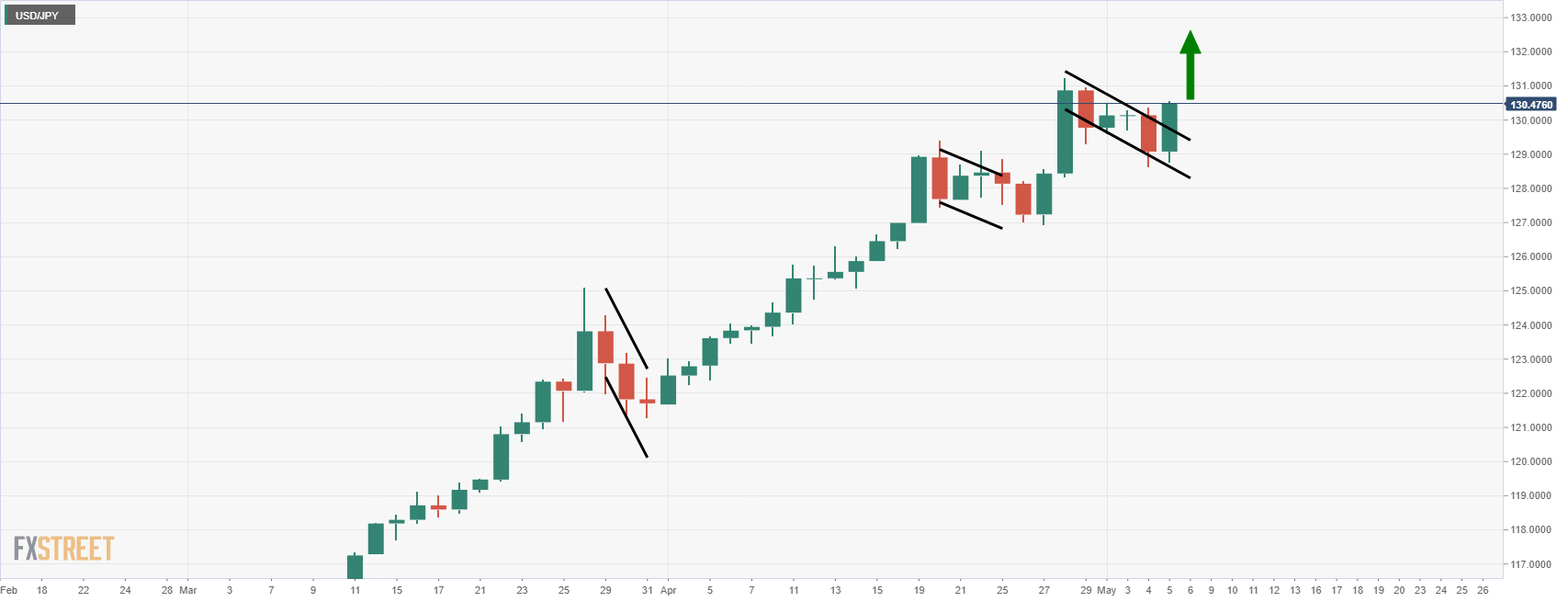
The price has been making a series of higher highs following a bull flag breakout within the bullish US dollar cycle as illustrated above.
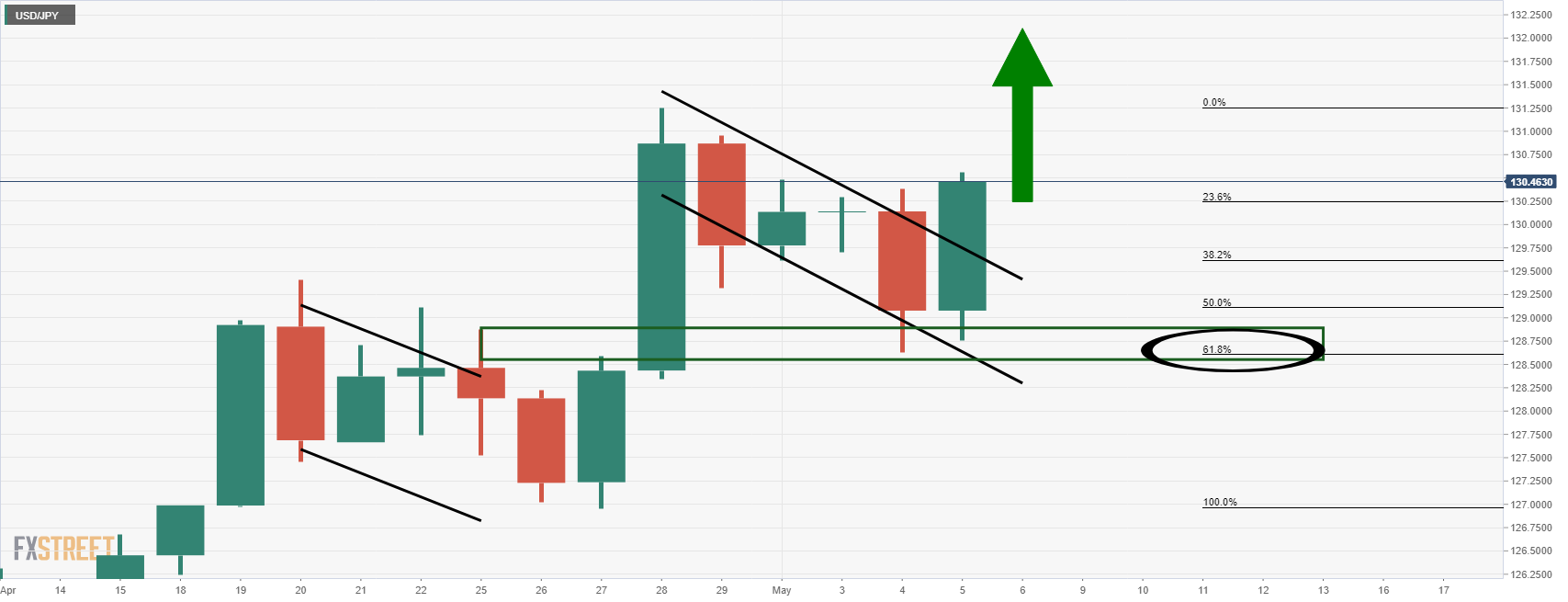
In the current bull flag breakout, we can see that the price corrected to as far as 61.8% Fibonacci ratio and has rallied from prior resistance. This offers conviction to the breakout.
However, the bulls now need to clear hourly resistance:
USD/JPY H1 chart
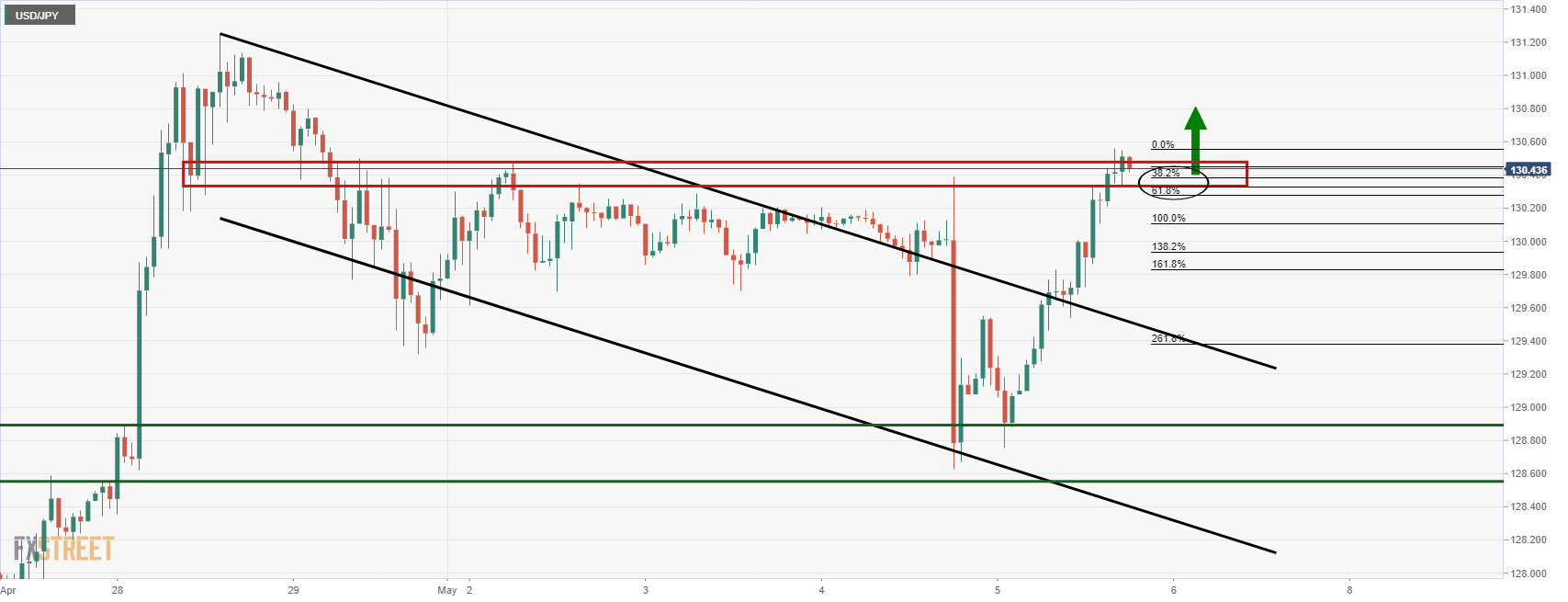
The price is attempting to break clear of the bear's commitments at resistance. The 38.2%, 50% and 61.8% ratios align with the prior resistances on the hourly time frame that could act as support and lead to a surge higher in order to challenge the daily highs for the sessions ahead:

- Gold prices are back in the hands of the US dollar ahead of NFP.
- A break of daily support at $1,850 opens the door to a test of $1,800 should US dollar strength prevail.
At $1,875, the gold price has been pressured and is trading not far from the lows of the day down at $1,872.54, losing some 0.34% at the time of writing. Gold fell from a high of $1,909.82 as the US dollar rebounded on Thursday, moving in on the 20-year highs reached last week, as per the DXY index.
DXY, an index that measures the greenback vs. six rivals, is currently trading at 103.84 and is 1.3% higher on the day after rallying from a low of 102.352 to a new cycle high of 103.942. The move comes following the Federal Reserve the prior day affirming that it would take aggressive steps to combat soaring inflation. Markets initially sold the fact yesterday but the dollar dropped sharply when the Fed chairman, Jerome Powell, dialled back on prospects of 75bps hikes.
However, the traders have now sold the euro which has propelled the greenback higher again. Weak German data showing that industrial orders in March suffered their biggest monthly drop since last October and the Ukraine crisis tensions are weighing on risk sentiment in the eurozone. The greenback was subsequently boosted by safe-haven buying as global equities come back under pressure.
All eyes on NFP
The moves in the markets come ahead of Friday's showdown event in the US jobs market. The Nonfarm Payrolls (NFP) is a major risk and could well set the tone for the following weeks ahead of the next Fed rate decision.
''A strong payrolls report could perversely push the market to price in more tightening as the Fed reduced its optionality at its most recent meeting,'' analysts at TD Securities said.
''That leaves a resilient USD vs EUR and yen very much the path of least resistance. A softer wages print should help to temporarily take the edge off but this will be short-lived until evidence of a peak/moderation in CPI emerges.''
Should the jobs data come in strong, it could exacerbate the fall in gold prices, especially considering that the breadth of traders' short positions remains near their lowest levels on record. Shorts that have been squeezed between $1,890 and $1,910 in this week's rally in the gold price will likely be looking to reinvest any dry powder on further signs that the US dollar bulls are moving in again.
Gold technical analysis
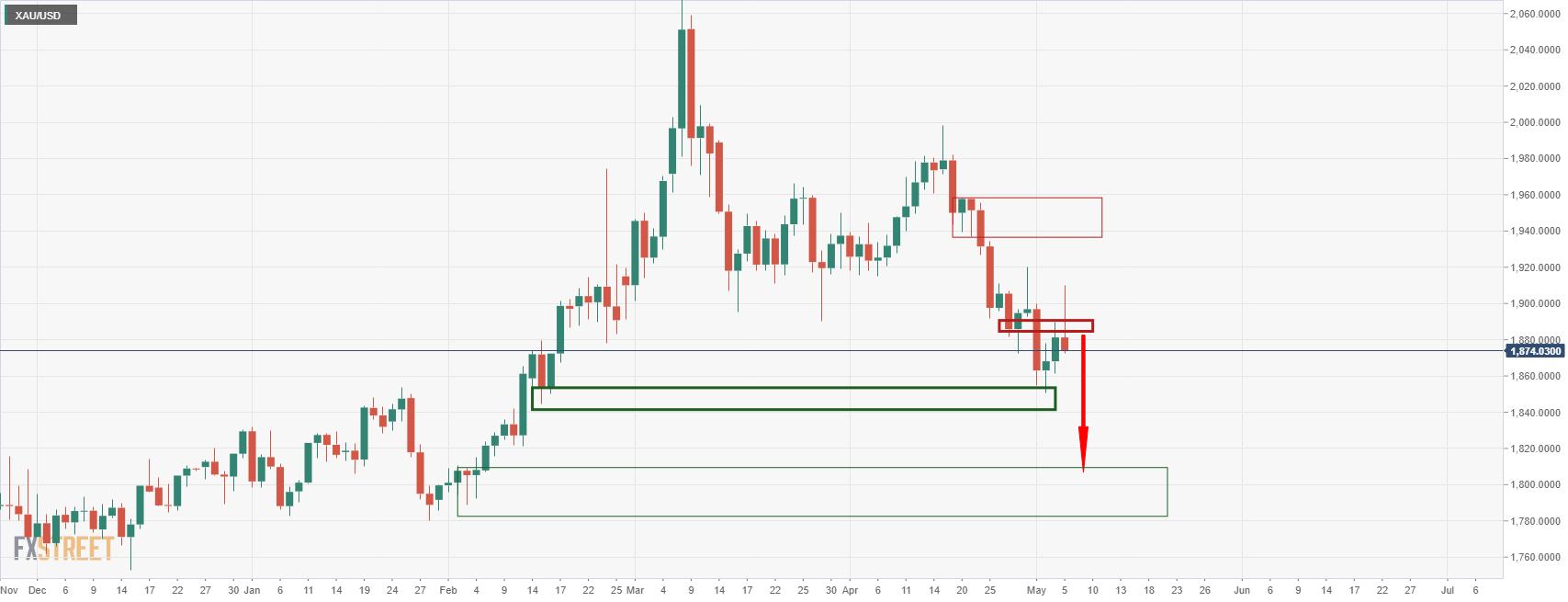
The price is carving out a case for a significant downside continuation with the resistance near $1,890 holding up for the most part bar a clearing in the short-lived spike to $1,910. A break of daily support at $1,850 opens the door to a test of $1,800 should US dollar strength prevail.
- Risk-aversion keeps the greenback buoyant, recovering Wednesday’s losses.
- Fed’s Chair Powell pushed back against 75-bps raises but kept 50-bps “on the table.”
- USD/CAD Price Forecast: Remains upward biased, as USD/CAD bears failed to reclaim 1.2800.
The USD/CAD trims Wednesday’s losses and is approaching March’s 15 daily highs around 1.2871 after the Federal Reserve raised interest rates by 0.50% for the first time in 22 years. At the time of writing, the USD/CAD is trading at 1.2859.
The market sentiment is dismal, as US equities are trading in the red, posting losses between 2.65% and 4.46%. The greenback is poised to test the 104.000 mark, up 1.21% during the day, while the US 10-year Treasury yield rose to 3.086%, gaining 14 basis points, underpinning the USD/CAD pair.
The Federal Reserve May meeting left traders with a 50-bps increase in the Federal Funds Rate (FFR). Also, the US central bank announced that it would reduce its $8.9 trillion balance sheet on June 1 by $47.5 billion, $30 billion of US Treasuries, and $17.5 billion of mortgage-backed securities (MBS).
Meanwhile, in his press conference, Fed Chair Jerome Powell pushed back against 75-bps increases but would not discount 50-bps hikes in a couple of more meetings. Money market futures odds of another 50-bps raise in June are 100%. However, the chances of a 75-bps hike lie at 71%, reflected by the jump on the US 10-year benchmark note.
On Thursday, the US economic docket featured Initial Jobless Claims for the week ending on April 29, which increased to 200K from 182K foreseen by analysts. The report notes that labor costs surged to 11.6%, showing the tightness of the job market.
In the week ahead, the Canadian docket will feature Canadian employment figures. Analysts at TD Securities wrote in a note that they expect another 40K jobs to be added to the economy. Furthermore, they noted that “services should account for the bulk of newly created jobs, alongside a mixed performance for the goods-producing sector. We also look for wage growth to hold at 3.7% y/y as tight labor market conditions help offset a large base-effect.”
On the US front, the US Nonfarm Payrolls report for April is estimated that 391K jobs were added to the economy, though lower than the previous 431K reached.
USD/CAD Price Forecast: Technical outlook
The USD/CAD dipped towards April’s 29 swing lows around 1.2718 post-Federal Reserve decision on Wednesday. However, a shift in market sentiment, alongside technical support in the level mentioned above, spurred a jump from weekly lows towards the March 15 swing high around 1.2871. Additionally, the Relative Strength Index (RSI) shifted gears and is aiming higher, at 60.99, with enough room if the USD/CAD prints another leg-up.
With that said, the USD/CAD first resistance would be 1.2871. Break above would expose 1.2900, followed by the YTD high at 1.2913 and then the December 20 cycle high at 1.2964.
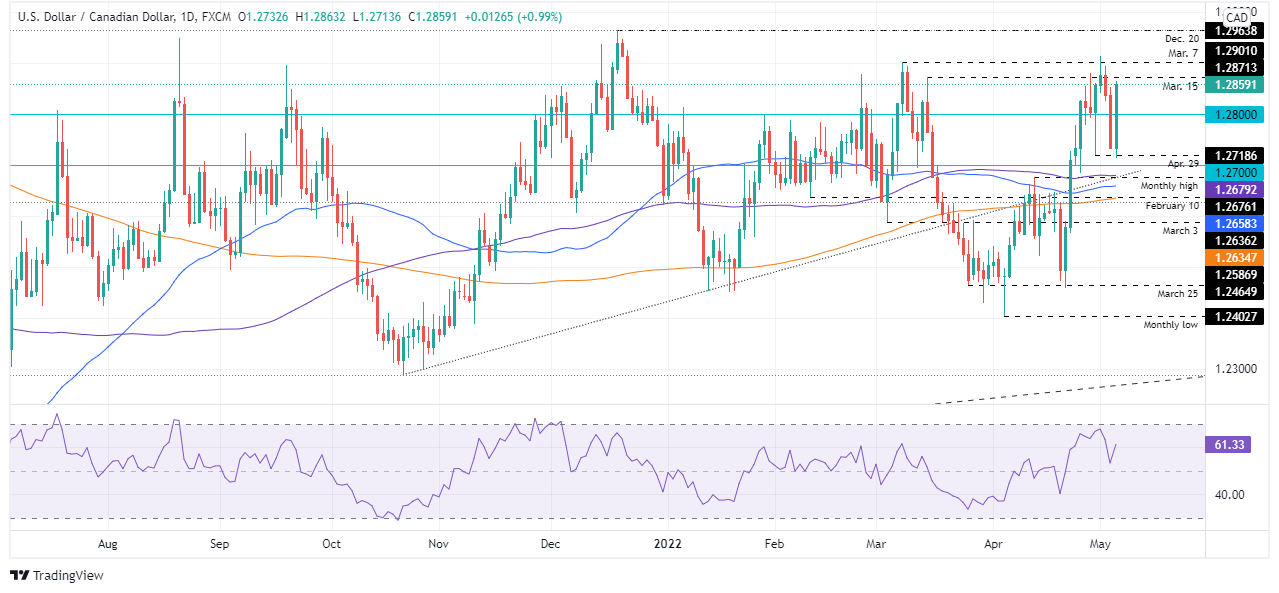
- The Bank of England hiked rates to 1%, though slashed UK’s economic growth in 2023.
- The US and UK central bank’s expressed concerns about China’s Covid-19 crisis, which threatens to disrupt supply chains, consequently triggering high inflation.
- GBP/USD Price Forecast: To fall towards June 2020 swing lows around 1.2251.
The British pound plummets on Thursday after the Bank of England (BoE) hiked 25-bps interest rates in a 6-3 split decision. However, the bank’s projections of a probable UK recession in 2023 shifted sentiment negatively, spurring a 280-pip drop from near weekly highs from 1.2630s to below 1.2350. At around 1.2330s, the GBP/USD reflects the scenario post-BoE decision.
As previously mentioned, the BoE lifted rates to the 1% threshold. Albeit widely expected, what dented the market sentiment is that the “old lady” slashed its growth forecasts, with 2023 showing a contraction of 0.25% vs. 1.2% on its previous projections. That, alongside the central bank’s worries about China’s renewed lockdowns, added to the Fed’s concerns on the same issue.
On Wednesday, in its monetary policy statement, the Fed mentioned that “… COVID-related lockdowns in China are likely to exacerbate supply chain disruptions,” while the Bank of England said that it was “worried” about renewed Covid-19 lockdowns and added that threatens to hit supply chains again and add to inflation pressures.
Additionally, in the Asian session, China’s Caixin Services PMIs printed a dismal figure, at 36.2 vs. 42.1 expectation, portraying the effects of April’s lockdowns in Shanghai.
Meantime, the US Dollar Index, a gauge of the greenback’s value, is trimming Wednesday’s losses and reached a new YTD high at around 103.942, though at the time of writing is sitting around 103.855, gaining 1.31%. Also, the US 10-year Treasury yield reclaimed the 3% threshold and is rallying 15 basis points, currently at 3.090%, underpinning the greenback.
On Thursday, the US economic docket featured Initial Jobless Claims for the week ending on April 29, which increased to 200K from 182K foreseen by analysts. The report notes that labor costs surged to 11.6%, showing the tightness of the job market.
GBP/USD Price Forecast: Technical outlook
The GBP/USD is under heavy selling pressure, and once it broke below July’s 2020 cycle lows around 1.2479, it opened the door for further losses. The MACD indicator shows that the MACD-line is aiming downwards, signaling that the downtrend is accelerating. With no immediate support nearby, the GBP/USD’s following line of defense would be the June 2020 swing lows around 1.2251.
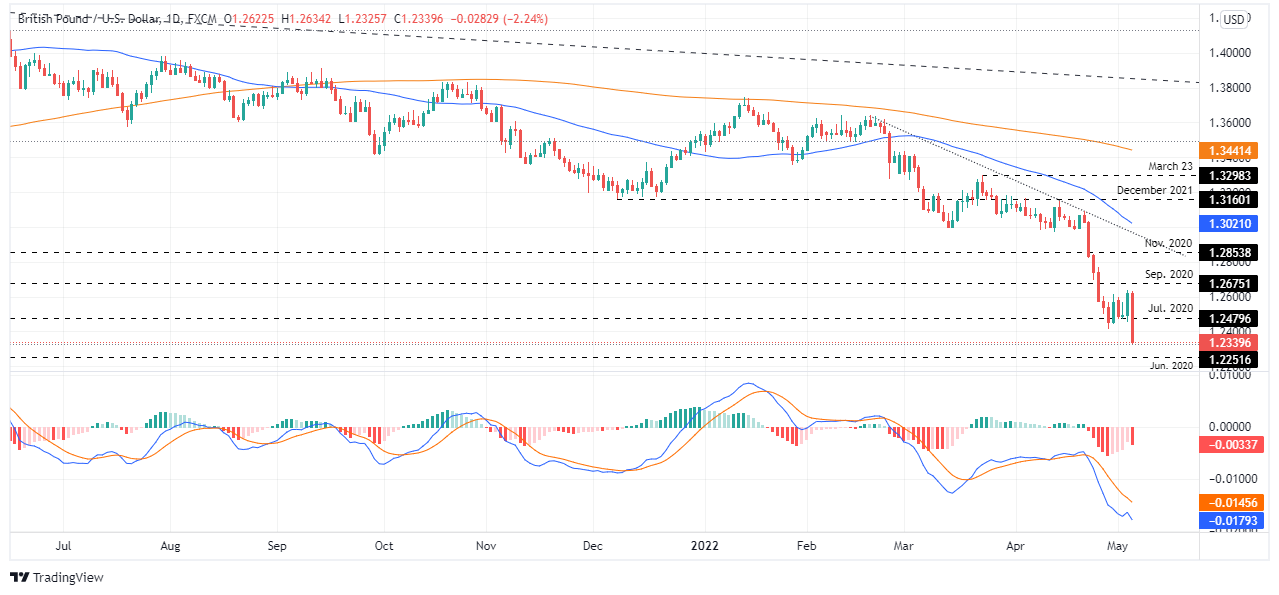
- Wall Street is falling sharply, volatility soars as US yields hit multi-year highs.
- Emerging market currencies are under pressure on risk aversion.
- USD/MXN erases losses and looks at 20.50.
The USD/MXN is rising sharply on Thursday, erasing Wednesday’s losses and so far, recovering 20.30. During the last two hours, the pair rose more than 1.20% amid a rally of the US dollar across the board.
US stocks give back Fed gains and more
The greenback gained momentum amid a selloff in Treasuries. The US 10-year yield stands at 3.09% and the 30-year at 3.18%, both at the highest level since Q4 2018. Higher yields and risk aversion are boosting the dollar. The DXY is about to test the 2022 high as it trades at 103.82.
Fears about higher rates hit market sentiment. Stocks in Wall Street had on Wednesday the best day since 2020. On Thursday, they are given back all those gains and even more. The Dow Jones tumbles 3.30%, and the Nasdaq plummets 5.02%.
The negative environment weakened emerging market currencies. The worst performer is the South African rand (USD/ZAR up 3.90%) and the Brazilian real USD/BRL +2.58%).
Key levels
The USD/MXN is back at the 20.30 level after hitting earlier the lowest level in two weeks under 20.00. The reversal put upside risks back to the table. If it holds above 20.30, the dollar could rise to test the critical short-term resistance area of 20.50. Above the next resistance stands at 20.70.
If USD/MXN failed to hold above 20.30 and slips back under 20.20, the Mexican peso could regain control, looking for a new test of 20.00.
Technical levels
- US dollar rises across the board on risk aversion and higher US yields.
- S&P 500 drops 3.40%, erases Fed’s rally.
- USD/JPY tests weekly highs after sharp reversal.
The USD/JPY rose further climbing above the level it had before the FOMC meeting. It is testing the weekly high near 130.40 after rising from than 150 pips from the daily lows boosted by higher US yields.
The sell-off in Treasuries resumed after a two-day pause and the day after the FOMC meeting. The dollar started to decline after the release of the Fed statement announcing a 50bps rate hike. The comments from Powell discarding a 75bps rate hike triggered mores losses for the greenback that bottomed on Thursday during Asian hours. Back then, USD/JPY was trading near 128.70.
The dollar started to recover and recently it gained more speed to the upside. It erased all losses from the Fed meeting and is back near the recent top. The DXY is up by 1.20% at 103.70. At the same time, US yields jumped. The US 10-year stands at 3.09% and the 30-year at 3.18%, the highest level since the fourth quarter of 2018.
Risk aversion is not preventing the selloff in Treasuries and it keeps the yen limited. The Japanese currency remains neutral across the board even as the Dow Jones tumbles 2.57%, the S&P 3.00% and the Nasdaq 4.19%.
The USD/JPY is testing the 130.40/50 area. Above the next resistance is seen at 130.75, and then comes the 2022 top at 131.25. If the pair fails to break 130.40 it could pull back initially to 130.30 and then to 129.70.
Technical levels
- Gold extends its losses below solid resistance around $1,890.
- The Federal Reserve and the BoE expressed concerns about China’s covid crisis.
- Gold Price Forecast (XAU/USD): Retreated below $1,890, opening the door for further losses.
Gold spot (XAU/USD) is recording losses in the North American session, retreating from daily highs around $1,909.66, amidst a risk-off market sentiment, as two-central banks expressed worries about China, while the Bank of England (BoE) foresees a GDP contraction on 2023 for the UK. At $1,878.51 a troy ounce, XAU/USD is down 0.14% but below March’s 2022 lows at $1,890.
On Wednesday, the Federal Reserve hiked rates by 50 bps, lifting the Federal Funds Rates by 1%. The market’s initial reaction was a “buy the rumor, sell the fact” event, partly because massive greenback long positions took profits. In the same monetary policy decision, the US central bank announced that it would reduce its $8.9 trillion balance sheet on June 1 by $47.5 billion, $30 billion of US Treasuries, and $17.5 billion of mortgage-backed securities (MBS).
In his press conference, Fed’s Chief Jerome Powell pushed back against 75 bps hikes but would not rule 50 bps increases in a couple of meetings.
Across the pond, the Bank of England (BoE) hiked rates by 25 bps, though the vote was split 6-3. In its opening statement, the BoE Governor Andrew Bailey said that inflationary pressures intensified since the Ukraine-Russia war and added that inflation is well above the target. He said that risks for UK’s growth are skewed to the downside, and it is expected to slow sharply.
The Fed and the BoE worried about China’s Covid crisis
The US and the UK central banks portrayed some warnings about the ongoing Covid-19 crisis in China. The Fed mentioned that “In addition, COVID-related lockdowns in China are likely to exacerbate supply chain disruptions,” while the Bank of England said that it was “worried” about renewed Covid-19 lockdowns and added that these threaten to hit supply chains again and add to inflation pressures.
Aside from this, the US economic docket featured Initial Jobless Claims for the week ending on April 29, which increased to 200K from 182K foreseen by analysts. The report notes that labor costs surged to 11.6%, showing the tightness of the job market.
Gold Price Forecast (XAU/USD): Technical outlook
Gold remains neutral-downward biased, retracing the previous jump to weekly highs around $1,909.66 one day after the Fed’s decision. As of writing, XAU/USD price is below the 50 and the 100-day moving averages (DMAs), a sign of the yellow-metal weakness. Also, on its way north lies a solid resistance area around March’s lows, previous support-turned-resistance at $1,890, which in the event of XAU/USD prices shooting higher, would be difficult to overcome on its way north.
Upwards, XAU/USD traders would face solid resistance at the 100-DMA at $1,882.31, followed by March’s lows at $1,890 and the $1,900 mark. On the other hand, XAU/USD’s first support would be May 3 daily low at $1,850.34, closely followed by the 200-DMA at $1,835.41, and then January’s 28 YTD low $1,780.18.
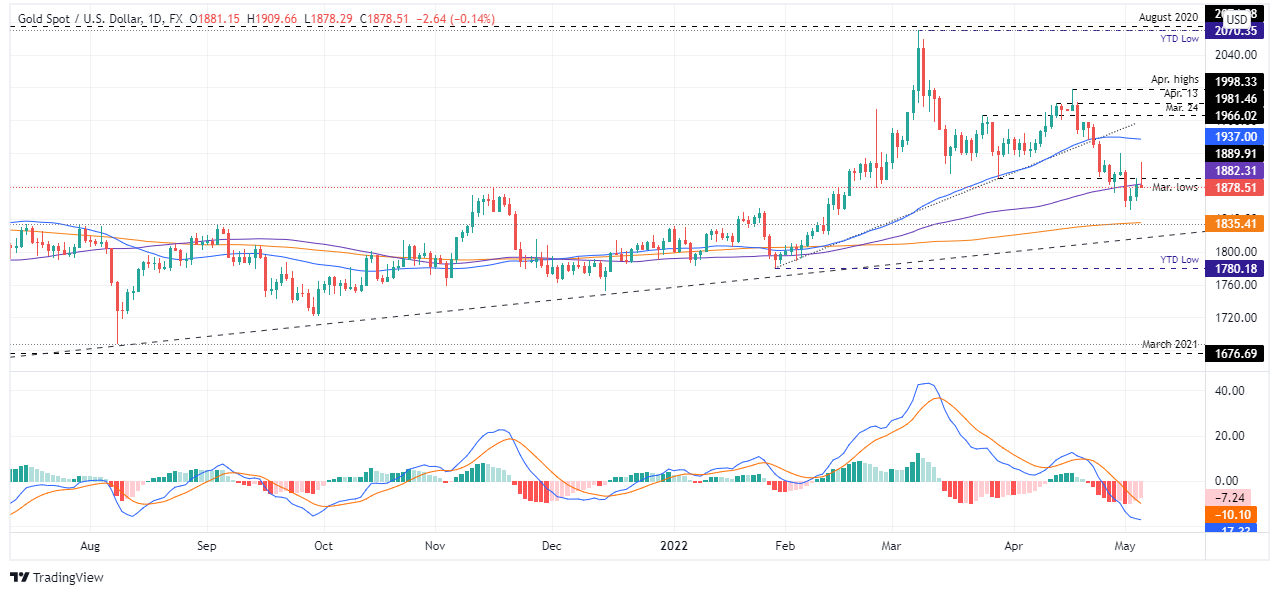
- US stocks tumble, VIX jumps and dollar soars.
- US yields rise to the highest level in years.
- EUR/USD looks to 1.0500 and the cycle low.
The EUR/USD is falling sharply and is about to test the 1.0500 area, weakened by a rally of the US dollar. The pair bottomed at 1.0503, more than 125 pips below the daily high it reached on Asian hours.
What comes fast goes away fast
A stronger US dollar across the board accelerated the decline of the EUR/USD. The greenback benefit as US stocks tumble. The Dow Jones is falling 2.85% and the Nasdaq 4.60%, erasing Wednesday’s gains.
At the same time, US yields are rising sharply to multi-year highs the day after the Federal Reserve rose the key interest rate by 50 basis points. The US 10-year yield stands at 3.07%, up more than 4% and the 30-year at 3.17%, the highest level since December 2018.
Economic data from the US showed Initial Jobless Claims rose unexpectedly to 200K, the highest level in eleven weeks while Continuing Claims printed a fresh historic low. On Friday, the April US official employment report is due.
A test of 1.0465 seems likely
The technical outlook deteriorated significantly for the euro with the recent reversal. A break under 1.0500 would initially expose the weekly low at 1.0487 and then the 2022 low at 1.0486.
A recovery above 1.0560 should alleviate the current bearish pressure of EUR/USD. Above the next resistance stands at 1.0600.
Technical levels
- US equities have largely reversed Wednesday’s post-Fed rally, with big tech names leading the decline as yields surge.
- The S&P 500 recently fell back below the 4,200 level, taking its losses to more than 2.5% or 100 points.
Wednesday’s post-Fed jubilation has proven short-lived, with all three of the major US equity indices having already given back the lion’s share of Wednesday’s gains not even two hours into the US trading session. Yes, Fed Chair Jerome Powell did rule out 75 bps rate hikes at upcoming meetings, easing some of the most acute fears about rapid near-term Fed tightening and, yes, this has knocked short-end US yields back from highs.
But the long end of the US yield curve is telling a hawkish story. The 10-year rallied more than 10 bps on Thursday to break above the 3.0% level for the first time since December 2018, while the 30-year yield was last up an even heftier 14 bps. Clearly, bond markets have interpreted Wednesday’s message from Powell as meaning signaling the risks are tilted towards a higher Fed terminal rate and equity markets are taking note.
The tech-heavy, highly long-term bond yield sensitive Nasdaq 100 index was last trading lower by close to 4.0% on the day near the 13,000 level, a sharp reversal back from Wednesday’s close above 13,500. The S&P 500, meanwhile, recently dipped back under 4,200 amid a 2.5% on the day decline and was last trading down over 100 points from Wednesday’s close bang on the 4,300 level. The Dow was last trading down a little under 2.0% in the 33,400 area, having reversed lower from a test of its 21 and 50-Day Moving Averages in the 34,070 area on Wednesday.
As markets continue to digest the implications of Wednesday’s Fed meeting, focus will begin shifting to the release of the official April US labour market report on Friday at 1330BST. With inflation risks in focus and a key driver of market sentiment right now (as higher inflation means a more hawkish Fed), traders will be closely scrutinising the report for signs of wage growth acceleration. If the data is interpreted as having any hawkish read across to the Fed, it could be an ugly end to the week for US equities.
- WTI rallied above $110 to hit its highest levels in over a month on Thursday, though has since dropped back.
- Traders are citing the EU’s Russia oil embargo plan and OPEC+’s decision to stick to their usual ouput hike policy as supportive.
Oil prices rallied for a second straight session on Thursday, with front-month WTI futures briefly hitting their highest levels in more than one month above the $110 ber barrel mark before more recently pulling back closer to $109.00. At current levels, WTI is still more than $1.50 higher on the day. Market commentators cited concerns about a further drop in Russian output in the months ahead as the EU nears agreement on a plan that would phase out all Russian oil imports within six months.
A French official on Thursday said they were confident a deal would be reached by the end of the week, with the EU proposal facing pushback from the likes of Hungary, Slovakia and Bulgaria. Market commentators also cited OPEC+’s decision on Thursday to continue their current policy of raising output quotas by 432K barrels per day each month as supportive for the crude oil complex. OPEC+ has been under pressure by major oil-consuming nations to increase output at a faster pace.
Even before Russia’s invasion of Ukraine and the subsequent harsh Western sanctions response, the outlook for near-term OPEC+ supply increases was poor, with a number of the group’s smaller producers struggling to keep pace with output quota hikes. A recent Reuters survey revealed the group’s adherence to its supply cut pact stood at over 160% last month and this is expected to rise as Russian production further suffers in the months ahead.
“The oil market has not fully priced in the potential of an EU oil embargo, so higher crude prices are to be expected in the summer months if it's voted into law,” an analyst at Rysted Energy said on Thursday. “The planned EU oil embargo represents a massive logistical challenge for oil markets,” another analyst said.
For now, then, WTI prices above/around $110 seem to make sense and bears will be eyeing a potential test of late March highs in the $116.00s. But traders would do well to also remain cognizant of downside risks presented by the evolving lockdown situation in China, with the country still pursuing a zero Covid strategy. Beijing continues to struggle to contain a Covid-19 outbreak and has been extending restrictions as infection rates (though still low) continue to rise. Local press suggests that the situation in Shanghai has been improving, however.
Finland Central Bank head and ECB Governing Council Member Olli Rehn said in an interview with Daily Helsingin Sanomat on Thursday that it would be reasonable to expect a 25 bps rate hike in July, and for interest rates to reach zero in the Autumn. After that we could continue further normalising monetary policy gradually and proactively," Rehn said.
Rehn's remarks come after ECB Chief Economist Philip Lane said earlier on Thursday that the exact timing of rate hikes is not the most important issue, reported Reuters. The ECB will move rates, not just once, but over time in a sequence, he noted.
- USD/TRY picks up renewed upside interest near 14.90.
- Turkey annual CPI rose to almost 70% in April, or 20-year high.
- Turkey Manufacturing PMI eased to 49.20 also in April.
The lira trades on the defensive and gives away part of the recent advance, helping USD/TRY to regain some composure and approach the 14.90 region on Thursday.
USD/TRY up on higher inflation
USD/TRY leaves behind two consecutive sessions with losses and resumes the upside on the back of the renewed depreciation of the Turkish currency, particularly after inflation in Turkey rose at the fastest pace in the last 20 years in April.
Indeed, and tracked by the CPI, consumer prices in Turkey rose at a monthly 7.25% in April and 69.97% from a year earlier, while Producer Prices rose 7.67% MoM and 121.82% YoY. Finally, the Manufacturing PMI receded a tad to 49.20 during last month (from 49.40), remaining in the contraction territory.
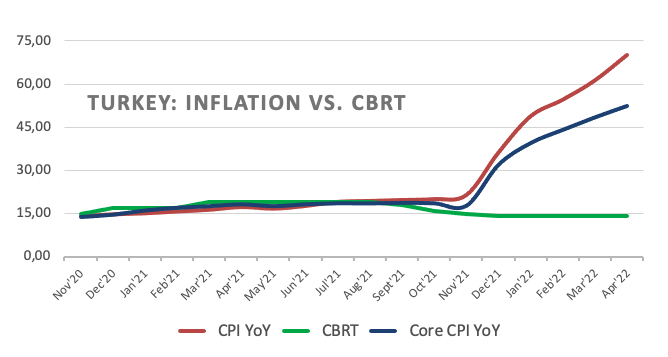
The higher-than-expected inflation figures in the country were mainly in response to the transportation sector (including energy prices) as well as food prices.
Still around inflation, President Erdogan said last week that inflation should start to lose traction in May, while finmin Nebati suggested on Monday that the ongoing elevated inflation was short-lived… (wait… what?).
Maybe the CBRT is waiting for inflation to hit triple digits before taking some much-needed action…
What to look for around TRY
The lira keeps the range bound theme unchanged vs. the greenback, always in the area below the 15.00 neighbourhood for the time being. So far, price action in the Turkish currency is expected to gyrate around the performance of energy prices, the broad risk appetite trends, the Fed’s rate path and the developments from the war in Ukraine. Extra risks facing TRY also come from the domestic backyard, as inflation gives no signs of abating, real interest rates remain entrenched in negative figures and the political pressure to keep the CBRT biased towards low interest rates remain omnipresent.
Key events in Turkey this week: Inflation Rate, Producer Prices, Manufacturing PMI (Thursday).
Eminent issues on the back boiler: FX intervention by the CBRT. Progress (or lack of it) of the government’s new scheme oriented to support the lira via protected time deposits. Constant government pressure on the CBRT vs. bank’s credibility/independence. Bouts of geopolitical concerns. Structural reforms. Upcoming Presidential/Parliamentary elections.
USD/TRY key levels
So far, the pair is gaining 0.89% at 14.8575 and faces the next hurdle at 14.9889 (2022 high March 11) seconded by 18.2582 (all-time high December 20) and then 19.00 (round level). On the other hand, a drop below 14.6836 (monthly low May 4) would expose 14.5458 (monthly low April 12) and finally 14.5136 (weekly low March 29).
Yesterday’s FOMC decision largely delivered on expectations – a 50bps hike and a little more detail on the start to the Fed’s balance sheet reduction plans. The USD wobbled following the FOMC decision and economists at Scotiabank think the outlook for the USD is more neutral now as a consequence of the Fed’s messaging.
USD rally to stall after FOMC
“With swaps already reflecting expectations that the Fed Funds target rate will nearly reach 3% in early 2023, there is little chance of short-term rates rising that much more – at least for the next few months until the Fed has a better chance of assessing whether rates need to be more restrictive. In effect, the Fed’s tightening plans now look to be fully priced by markets.”
“We don’t expect the USD to weaken sharply; it is likely to remain well supported on dips, given where domestic yields are. Higher domestic rates also make the USD an expensive short from a speculative point of view. Rather, we think the USD trend is likely to transition into a broad, choppy, sideways range trade.”
“The DXY’s price action on the week so far supports the notion of a tentative stall in the USD bull trend; a spot close on the week at or very near current levels (103.2) would put a Doji candle on the weekly chart which is a classic stalling signal and could precipitate a corrective drift in the index back to the 99/101 zone in the next few weeks.”
- AUD/USD met with a fresh supply on Thursday and eroded a major part of the overnight gains.
- The prospects for a further tightening by the Fed revived the USD demand and exerted pressure.
- Concerns about the latest COVID-19 outbreak in China further undermined the Australian dollar.
The AUD/USD pair extended its steady intraday descent through the early North American session and fell to a fresh daily low, around the 0.7165-0.7160 region in the last hour.
Having struggled to move back above the 100-day SMA, the AUD/USD pair met with a fresh supply on Thursday and snapped a two-day winning streak to a near two-week high. A combination of supporting factors assisted the US dollar to make a solid comeback and reversed the previous day's post-FOMC slump. This, in turn, was seen as a key factor that exerted downward pressure on the major.
Fed Chair Jerome Powell on Wednesday downplayed the possibility of a more aggressive policy tightening, though stated that policymakers were ready to approve 50 bps rate hikes at upcoming meetings. Moreover, the markets are pricing in a further 200 bps rate hike for the rest of 2022. This was evident from a fresh leg up in the US Treasury bond yields, which helped revive the USD demand.
This, along with concerns about rising COVID-19 cases and strict lockdowns in China, further benefitted the safe-haven buck, which seemed rather unaffected by a rise in the US Initial Jobless Claims. On the other hand, the disappointing release of China's Caixin Services PMI, along with softer Australian trade data, also contributed to driving flows away from the China-proxy aussie.
It would now be interesting to see if the AUD/USD pair is able to attract any buying at lower levels or prolongs the intraday rejection slide from a technically significant moving average. Some follow-through selling would suggest that this week's bounce from a three-month has run its course and set the stage for the resumption of the prior downtrend witnessed over the past one month or so.
Technical levels to watch
The Bank of England (BoE) has hiked by a further 25 basis points, though there are further signs that policymakers believe market rate hike expectations have gone too far. Economists at TD Securities expect reinforced weakness in the British pound.
The outlook is very soft
“The MPC delivered as broadly expected today with a 25bps hike and a promise of an update on active Gilt sales in August. Macro forecasts based on the yield curve were downgraded sharply, with the MPC expecting 10% inflation in 2022 and negative GDP growth in 2023, sending a strong signal to markets that the anticipated rate path is too high.”
“BoE outlook illustrates the fears of rising stagflation risks, raising questions about the terminal rate priced into markets. As a result, we think that GBP is losing its appeal.”
“We note that GBP also suffers from the broader European stagflationary pressures gripping the EUR. While the EUR's stagflation risks are arguably higher, it also has more room to reprice growth and rates higher. We continue to like EUR/GBP higher as a broader forecasting theme, so we will look to use dips as buying opportunities.”
“GBP's one bright spot lies in stretched market positioning and tactical valuations. It's the most oversold G10 currency, and HFFV sits at 1.2787, leaving it ripe for a short-term correction. Yet that is a move we would look to fade.”
- Silver is currently holding above $23.00 and on course for a second day of gains amid dovish central bank vibes.
- The Fed ruled out 75bps rate hikes on Wednesday and the BoE sounded the alarm about a possible UK recession.
- Focus now shifts to Friday’s official US labour market report.
Spot silver (XAG/USD) prices held above the $23.00 per troy ounce level on Thursday after markets interpreted the latest BoE policy announcement as dovish, one day after a less hawkish than feared policy announcement from the Fed. At current levels in the $23.10s, XAG/USD trades with on-the-day gains of more than 0.5%, taking its two-day rally to over 2.0% and recovery since earlier weekly lows at $22.12 to more than 4.5%.
After the Fed lifted interest rates by 50 bps as expected on Wednesday and ruled out hiking interest rates in more aggressive 75 bps intervals at upcoming meetings, a move which analysts said removed some downside risk to precious metals, the BoE warned of a recession in the UK economy in 2023, though still raised interest rates by 25 bps on Thursday. Ahead of the release of the April US labour market report on Friday, dovish central bank vibes will likely keep XAG/USD supported above $23.00.
The precious metal might even be able to rally back to test its 200-Day Moving Average in the $23.75 area. But it remains premature to bet on a more substantial rebound back to, say, April’s highs in the $26.00s. While the BoE doesn’t seem likely to tighten monetary policy settings much more amid growing concerns about UK economic growth later in the year, as well as worries about the bank’s ability to meet its long-term inflation objectives, Fed policy risks remain tilted in favour of a further hawkish shift.
Despite ruling out 75 bps rate hikes on Wednesday, Fed Chair Jerome Powell was keen to reiterate that the Fed is prioritising bringing inflation down above all else. If inflation fails to moderate as much as expected (or hoped for) by the Fed in the second half of this year, then risks are tilted towards the Fed signaling interest rates rising significantly above the so-called “neutral” rate.
That could ignite further long-term upside in USD and US yields, which could weigh heavily on silver. Rallies, thus, remain subject to being sold and many XAG/USD bears will continue to target a test of 2022 lows around the $22.00 mark.
S&P 500 has seen a further strong recovery post the FOMC to turn the spotlight on the 4308 recent high. Despite the recent strength, only a close above here would see a base complete to maintain the positive tone, analysts at Credit Suisse report.
Failure to close above 4308 on Friday would see a ‘reversal week’ avoided
“We see a key inflection point at the high of last week at 4308. For a more constructive tone, it is vital to see a quick followthrough to the upside following yesterday’s strength.”
“If a close above 4308 can be achieved on Friday this would not only see a near-term base complete but also a bullish ‘reversal week’, which we would look to then provide the platform for a deeper albeit still corrective rally. We would then see resistance next at the 38.2% retracement of the YTD fall at 4341/51, then price, gap and 63-day average resistance at 4370/94.”
“Failure to close above 4308 at the end of this week would see a ‘reversal week’ avoided. Below support at 4200 though is needed to ease the immediate upside bias and below 4153/49 to turn the broader risk lower again for a fall back to 4115.”
The Federal Reserve decided to hike its policy rate by 50 basis points (bps) as expected. As a result, gold rallied. Nonetheless, economists at TD Securities do not expect the race higher in the the yellow melta to last long.
There are not many participants remaining with appetite to buy gold
“The Fed largely met expectations, catalyzing a buy-everything rally given the pervasively poor sentiment across global markets amid well-telegraphed move. While Chair Powell took 75bp hikes out from consideration, the deck was stacked for this outcome from a positioning lens.”
“Price action is playing out according to our playbook, which also notes that there aren't many participants remaining with appetite to buy gold, with only a few participants short. The consensus trade is to the long side, with some complacent gold length still associated with the war in Ukraine.”
“The few remaining shorts hold a large position size and are likely to take profit as prices rise, fueling the ongoing rally in gold amid the buy-everything trade. However, we suspect that the rally won't last long in the yellow metal, considering that the breadth of traders short remains near its lowest levels on record.”
USD/CAD has failed to break medium-term resistance starting at 1.2900/15. However, economists at Credit Suisse maintain a positive outlook whilst above 1.2684/53.
Rejection of the March high at 1.2900/15 still seen as a correction
“USD/CAD is falling sharply back lower again, with next near-term support now seen at 1.2684/53. We retain our bullish bias whilst above this area, though a move back above 1.2846/53 is needed to relieve the immediate downward pressure and pave way for a renewed test of the March high at 1.2900/15.”
“Above March high at 1.2900/15 would see scope to challenge the 2021 high at 1.2947/67, which we view as a key medium-term barometer for the market.”
“Should 1.2684/53 be broken, this would likely act as a signal that the market is mean-reverting back within the long -term range and would lead us to neutralise our positive bias. With this in mind, support would then be seen at 1.2567, ahead of a more major support at the uptrend from Q2 2021 at 1.2458/26.”
- EUR/GBP caught aggressive bids and surged to a fresh YTD top after the BoE policy decision.
- A split MPC and gloomy economic outlook pointed to a dovish tilt, which weighed on sterling.
- Resurgent USD demand and the Ukraine crisis hold back the euro bulls from placing fresh bets.
- The technical set-up supports prospects for additional gains and a move towards the 0.8600 mark.
The post-BoE selling around sterling pushed the EUR/GBP cross to a fresh YTD high, around mid-0.8500s during the mid-European session.
The UK central bank on Thursday lifted its key interest rate for the fourth time since December, to the highest level in 13-years to curb inflation, which has leapt to a 30-year high. In the accompanying policy statement, the Bank of England noted that some degree of further tightening in monetary may still be appropriate in the coming months.
That said, a split emerged in the Monetary Policy Committee as two members said that the guidance was too strong considering the risks to growth. Moreover, the BoE warned about a sharp slowdown and is now forecasting the UK economy to contract by 0.25% in 2023. This was seen as a dovish shift, which, in turn, weighed heavily on the British pound.
In the post-meeting press conference, BoE Governor Andrew Bailey said that the MPC doesn't agree with people who think that they should raise interest rates a lot more. This, in turn, suggested that the rate hike cycle could be nearing a pause and prompted aggressive short-covering around the EUR/GBP cross, taking along some intermediate trading stops.
The momentum pushed spot prices beyond a downward-sloping trend-line resistance extending from April 2021 and might have already set the stage for further gains. That said, resurgent US dollar demand, along with concerns that the European economy will suffer the most from the Ukraine crisis, weighed on the euro and might cap gains for the EUR/GBP cross.
Nevertheless, the bias seems tilted firmly in favour of bullish traders and any meaningful slide back towards the 0.8500 psychological mark could be seen as a buying opportunity. Some follow-through buying beyond the mid-0.8500s would reaffirm the positive outlook and allow the EUR/GBP cross to reclaim the 0.8600 mark for the first time since October 2021.
Technical levels to watch
- EUR/USD fades the post-Fed advance to 1.0640.
- The resumption of the downtrend looks increasingly likely.
EUR/USD sharply reverses two daily gains in a row and returns to the mid-1.0500s on Thursday.
The underlying bearish view in the pair remains well and sound and another visit to the 2022 low around 1.0470 (April 28) should not be ruled out for the time being. The breach of the latter should put the pair en route to a potential visit to the 2017 low at 1.0340 (April 21).
In the meantime, while below the 3-month line near 1.0960, extra losses in the pair are likely.
EUR/USD daily chart
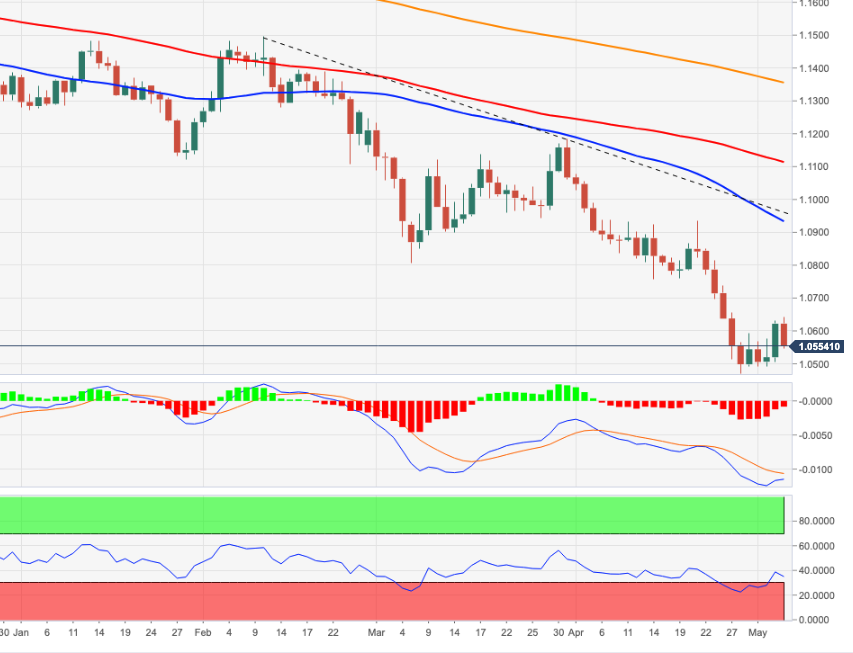
"We are not planning on selling gilts before August," Bank of England Governor Andrew Bailey said on Thursday, adding that, before then, there is a lot of work to be done, reported Reuters. The BoE still needs to look at the market context when considering whether to start gilt sales, he continued.
BoE Deputy Governor Dave Ramsden added that any gilt sales must be consistent with effective gilt market function. Deputy Governor Ben Broadbent, meanwhile, noted that if the UK is hit by a negative shock in the future, the BoE wants its bank rate to be able to respond first, not gilt operations.
- DXY strongly reverses two consecutive daily pullbacks.
- Extra rebound in the dollar targets the 2022 high near 104.00.
DXY quickly leaves behind the recent weakness, including the post-FOMC low near 102.30, and refocuses on the upper end of the recent range.
That said, if the rebound picks up further pace, then the index could challenge the 19-year high just below the 104.00 yardstick (April 28), while the trespass of this level could open the door to 105.63 (December 11 2002 high).
The current bullish stance in the index remains supported by the 8-month line in the 96.85/90 band, while the longer-term outlook for the dollar is seen constructive while above the 200-day SMA at 95.92.
DXY daily chart

- There were 200K initial claims in the most recent week, a little above the expected 182K.
- FX markets seemingly did not react to the latest weekly jobless claims figures.
There were 200,000 initial jobless claims in the US in the week ending on 30 April, according to the latest data released by the Department of Labour on Thursday. That was above expectations for a slight rise from 181,000 in the prior week to 182,000. That brought the four-week average number of initial claims higher to 188,000 from 180,000 a week earlier.
US continued claims fell to 1.384M in the week ending on 23 April, below expectations for a slight decline to 1.4M from 1.403M in the prior week. The insured unemployment rate remained unchanged at 1.0%.
Market Reaction
FX markets seemingly did not react to the latest weekly jobless claims figures.
Unit Labour Costs in the US rose at a QoQ pace of 11.6% in Q1 2022, well above the expected 9.9% rise on the quarter and following a 0.9% QoQ rise in Q4 of last year, data released by the Bureau of Labour Statistics on Thursday showed. The QoQ rate of non-farm productivity growth in Q1 2022 came in at -7.5%, below expectations for a 5.4% drop, coming on the heels of Q4 2021's 6.3% QoQ gain.
Market Reaction
FX markets seemingly did not react to the latest weekly jobless claims figures.
- Gold continues to push higher and recently moved above $1900 as markets digest Wednesday’s Fed policy announcement.
- Fed’s Powell ruled out 75 bps rate hikes for the coming months, removing some downside risk for gold, analysts said.
- Focus now turns to Friday’s US jobs report.
Spot gold (XAU/USD) prices reclaimed the $1900 per troy ounce level on Thursday, hitting highs in the $1903.00s as precious metal bulls remained in control as markets continued to digest Wednesday’s not as hawkish as feared Fed policy announcement. While Powell was consistent in his message that rates will continue to rise rapidly as the Fed “expeditiously” moves policy back to a more neutral level to be in a better position to tackle inflation, the fact that he ruled out a 75 bps move in the meetings ahead has removed some downside risks for gold, analysts said.
At current levels just above the $1900 mark, XAU/USD trades with gains of well over 1.5% versus Wednesday’s pre-Fed announcement levels under $1870. Some analysts argued that the Fed’s refusal to entertain larger than 50 bps rate hikes in the coming months risks putting the bank further behind the curve with regards to tackling inflation, which could potentially be a positive for gold moving forward. But other noted that risks remain elevated that over the summer, should inflation fail to moderate as much as the Fed hopes it will, they could signal interest rates moving substantially above neutral in 2023, which could trigger a tightening in financial conditions (US yields and US dollar higher) and downside in gold.
In the more immediate future, gold traders will be focused on the upcoming release of the April US labour market report at 1330BST on Friday. If the report reveals further evidence of building wage pressures, this only adds to the upside inflation risks for the US economy this year and raises the risk of a substantial further hawkish shift from the Fed over the summer. In this scenario, XAU/USD could quickly hand back recent gains and test weekly lows at $1850. If not, and if the bulls can manage a more significant upside break of $1900, perhaps a test of the 21 and 50-Day Moving Averages in the $1920s-$1930s area is on the cards.
- GBP/USD witnessed aggressive selling on Thursday in reaction to the BoE’s dovish outlook.
- Resurgent USD demand aggravated the bearish pressure and also contributed to the slide.
- Acceptance below the 1.2400 mark would now be seen as a fresh trigger for bearish traders.
The GBP/USD pair weakened further below the 1.2400 mark and touched its lowest level since July 2020 in reaction to the Bank of England's dovish outlook.
As was widely anticipated, the UK central bank lifted its key interest rate for the fourth time in the current tightening cycle to curb inflation. The vote distribution indicated that three MPC members were in favour of raising interest rates by 50 bps. Moreover, the BoE, in the accompanying policy statement, noted that some degree of further tightening in monetary may still be appropriate in the coming months.
That said, two MPC members judged rate guidance as inappropriate considering that risks to growth and inflation are more balanced. Adding to this, the BoE warned about a sharp slowdown and is forecasting the UK economy to contract by 0.25% in 2023. A divided MPC, along with downside growth risks, suggests that the rate hike cycle could be nearing a pause, which, in turn, prompted aggressive selling around the British pound.
In the post-meeting press conference, BoE Governor Andrew Bailey said that the MPC doesn't agree with people who think that they should raise interest rates a lot more. On the other hand, the US dollar made a solid comeback amid expectations that the Fed would hike interest rates by 50 bps at the next four policy meetings. This aggravated the bearish pressure surrounding the GBP/USD pair and contributed to the decline.
The sharp intraday decline took along some trading stops placed near the previous weekly low, around mid-1.2400s touched on Wednesday. The subsequent fall, however, showed some resilience below the 1.2400 round-figure mark. This makes it prudent to wait for sustained weakness below the said handle before positioning for any further depreciating move.
Technical levels to watch
Bank of England Governor Andrew Bailey on Thursday said that the BoE Monetary Policy Committee doesn't agree with people who think that they should raise interest rates a lot more, reported Reuters. UK businesses are really struggling to hire people, he added, noting that they are more concerned about hiring difficulties than they are about a potential future downturn.
"We are worried about second-round inflationary effects," Bailey said, noting that in a competitive labour market, it is those with the least bargaining power who suffer most from inflation. "I don't use the word stagflation as it isn't well defined," Bailey added.
Bank of England Deputy Governor Dave Ramsden said that we are seeing the hit to real incomes start to appear in consumer surveys.
- EUR/JPY remains side-lined around the 137.00 region.
- Price action in the cross keeps pointing to extra consolidation.
EUR/JPY remains stuck within a consolidative pattern around the 137.00 zone so far on Thursday.
Further side-lined trading seems the name of the game for the cross in the short-term horizon. The breakout of this theme should meet the next barrier of note at the 2022 high around 140.00 (April 21) ahead of the June 2015 high at 141.05.
In the meantime, while above the 200-day SMA at 130.83, the outlook for the cross is expected to remain constructive.
EUR/JPY daily chart
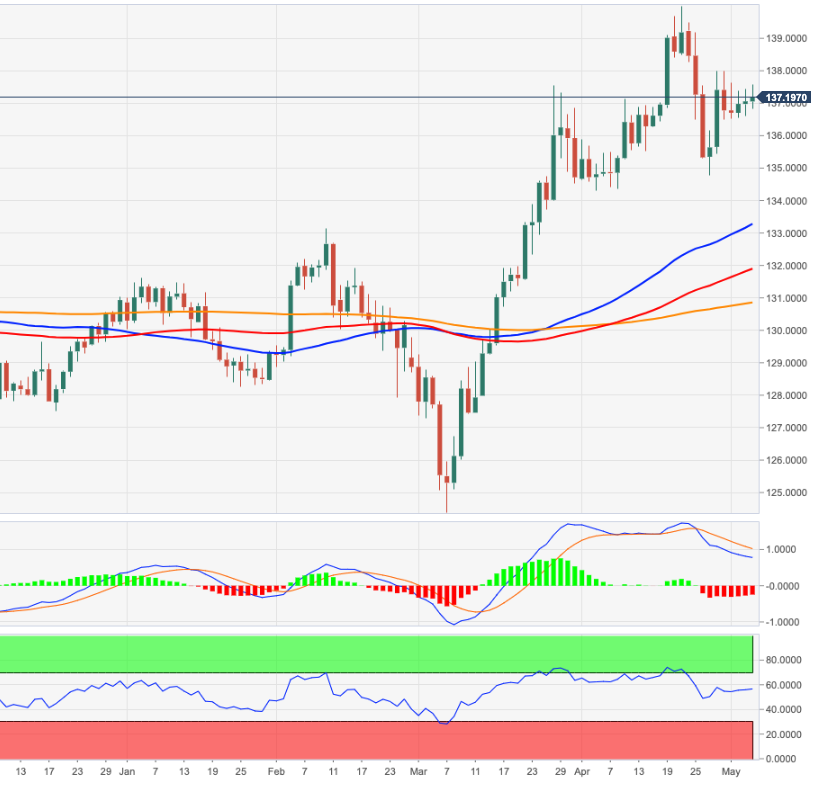
Bank of England Governor Andrew Bailey said in the post-BoE meeting press conference that no decision has yet been made over whether or not to carry out active sales of the bank's UK government bond holdings, report Reuters.
Additional Remarks:
The labour market is very tight.
The question continues of how exactly savings built up during covid will be used.
BoE Deputy Governor Ben Broadbent said that a rise in mortgage costs from rising interest rates is a fraction of the hit from higher energy costs.
The biggest driver downward of UK inflation will be the shock to real incomes, not monetary policy.
In terms of pain, the biggest driver is the real-income shock from energy prices and the change in terms of trade.
- GBP/JPY came under intense selling pressure after the BoE announced its policy decision.
- The BoE raised interest rates for the fourth straight time to the highest level since 2008.
- The split MPC and a dovish outlook turned out to be a key factors that weighed on sterling.
The British pound weakened across the board after the Bank of England announced its policy decision and dragged the GBP/JPY cross to a one-week low, around mid-161.00s in the last hour.
As was expected, the UK central bank raised interest rates for the fourth time since December and the policy statement suggested that some degree of further tightening may still be appropriate in the coming months. That said, two MPC members decided to back away from the guidance that more hikes will be needed.
Adding to this, the BoE warned that the UK economy will slide into recession later this year and the annual GDP is expected to shrink by 0.25%. The split MPC, along with the dovish outlook, suggests that the rate hike cycle could be nearing a pause. This, in turn, was seen as a key factor that weighed on sterling.
On the other hand, a generally positive tone around the equity markets undermined demand for the safe-haven Japanese yen, which was further pressured by a more dovish stance adopted by the Bank of Japan. This, in turn, could help limit losses for the GBP/JPY pair as traders now await the post-meeting BoE press conference.
Technical levels to watch
In his usual post-meeting press conference, Bank of England Governor Andrew Bailey said that global inflationary pressures have intensified since Russia's invasion of Ukraine, reported Reuters.
Additional Remarks:
The Ukraine invasion has led to a material deterioration in the growth outlook globally.
Monetary policy must navigate the narrow path between increased inflation risks and the hit to activity from reduced real incomes.
There are important differences in how shocks are impacting different economies.
UK inflation is well above target in the near term and then subsequently falls below its target.
"I recognize the hardship that the current fall in real incomes will cause for many people in the UK, particularly those on the lowest incomes."
Risks to inflation are skewed to the upside.
European Central Bank Chief Economist Philip Lane said on Thursday that the exact timing of rate hikes is not the most important issue, reported Reuters. The ECB will move rates, not just once, but over time in a sequence, he noted.
His remarks come after he earlier said that the euro area is unlikely to revert to the persistent below-target inflation trend that was so entrenched before the pandemic. "The significant jump in energy prices since the summer of 2021 represents a major macroeconomic shock," he said earlier.
- GBP/USD witnessed some selling after the BoE announced its policy decision.
- The MPC voted unanimously to hike rates for the fourth straight meeting.
- A dovish outlook weighed on the British pound amid resurgent USD demand.
The GBP/USD pair added to its intraday losses and dropped to a fresh daily low, around mid-1.2400s after the Bank of England announced its policy decision.
As was widely expected, the UK central bank raised interest rates by 25 bps for the fourth time since December at the end of its May policy meeting this Thursday. Six BoE MPC members voted in favour of a 25 bps rise, and three voted to raise rates by 50 bps. Adding to this, the accompanying monetary policy statement suggested that some degree of further tightening in monetary may still be appropriate in the coming months.
That said, two MPC members judged rate guidance as inappropriate considering that risks to growth and inflation are more balanced. Moreover, the BoE now sees the UK economy contracting by 0.25% in 2023, which was seen as a dovish tilt and turned out to be a key factor that weighed on the British pound. Apart from this, resurgent US dollar demand exerted additional downward pressure on the GBP/USD pair and contributed to the slide.
With the latest leg down, the GBP/USD pair has now dropped to the lower end of a near one-week-old trading range. Some follow-through selling would mark a fresh bearish breakdown and drag spot prices back towards the YTD low, around the 1.2410 region touched last week.
Technical levels to watch
Economist at UOB Group Lee Sue Ann reviews the latest RBA decision to raise the cash rate by 25 bps at its meeting last Tuesday.
Key Quotes
“The Reserve Bank of Australia (RBA), at its meeting on Tue (3 May), announced an increase in the cash rate target by 25bps to 0.35%. It also increased the interest rate on Exchange Settlement balances from 0% to 0.25%. This is the first rate hike since late 2010, and the move was larger than market expectations for a 15bps increase. The RBA also decided to not reinvest the proceeds of the Bank's government bond holdings as they mature.”
“We were looking for the RBA to move only in Jun, largely due to two key reasons.The first was the concern on how a first rate hike in over a decade would impact the outcome of the Australian general elections on 21 May. The second was that we thought the RBA would prefer to wait for 1Q22 wage data due for release on 18 May. Clearly, the need to address inflation outweighed the two key reasons mentioned above.”
“The earlier and larger-than-expected move by the RBA yesterday implies a more aggressive tightening path than we previously projected. The next RBA meeting is on 7 Jun, and at this juncture, we look for another 25bps increase in the cash rate target to 0.60%. However, we are still of the view that the RBA will remain cautious relative to its global peers as far as monetary policy tightening is concerned. We will be firming up our RBA rate hike trajectory following the wage price data release on 18 May.”
The Bank of England on Thursday raised interest rates by 25 bps to 1.0%. Six of the bank's nine rate-setters supported the 25 bps hike, though three wanted a larger 50 bps move. The rate hike was in line with expectations, but the vote split was more hawkish than expected, with a Reuters poll showing that eight had been expected to support a 25 bps hike and one support no hike.
The BoE said that most of its Monetary Policy Committee (MPC) members think that "some degree of further tightening in monetary policy may still be appropriate in the coming months". However, two of its MPC members thought that this rate guidance was inappropriate given risks to growth.
According to the BoE's new Monetary Policy Report (MPR), inflation is seen peaking at an average of slightly above 10% in Q4 2022, an upwards revision from the March forecast for inflation to peak at around 8.0%.
Additional Takeaways:
BoE staff will work on an active bond sale strategy and will report back to the MPC by the August meeting, with the MPC to then decide on whether to start sales at a subsequent meeting.
GDP growth to slow sharply over the next year and a half, due to a sharp rise in global energy and tradable goods prices.
BoE forecasts point to a sharp contraction of almost 1% QoQ in Q4 2022 after energy prices rise again, followed by a small fall in GDP for 2023 and unemployment rising to 5.5% over the next 3 years.
The BoE estimates GDP growth to be +0.9% QoQ in Q1 2022, a little higher than the March estimate of +0.75% QoQ, and sees around zero growth in Q2 2022 due to extra the public holiday and reduced Covid testing.
The BoE forecast shows inflation in three years' time at 1.30%, lower than the February forecast of 1.60%, based on market interest rates.
The BoE said UK inflation is likely to peak later, and fall back later, than in other countries due to the UK's energy price cap.
Market rates imply more BoE tightening than back in February, showing the bank rate at 1.9% in Q4 2022, 2.6% in Q4 2023, 2.2% in Q4 2024, versus 1.2% in Q4 2022, 1.4% in Q4 2023, 1.3% in Q4 2024 back in February.
The BoE forecast shows inflation in one year's time at 6.65%, higher than February's forecast of 5.21%, based on market interest rates and the modal forecast.
The BoE forecast shows inflation in two years' time at 2.14%, similar to February's forecast of 2.15%, based on market interest rates.
The BoE estimates real post-tax household disposable income falling -1.75% YoY in 2022, larger than the decline forecast in February of -1.25%, before then rising +1% in 2023 +2.5% in 2024. The 2022 decline will be the biggest annual drop since 2011.
The BoE estimates wage growth will be +5.75% YoY in Q4 2022, above February's estimate of +3.75%, +4.75% in Q4 2023 and +2.75% in Q4 2024.
The BoE estimates GDP will grow +3.75% in 2022, in line with their February estimate, before declining 0.25% in 2023 and then rising 0.25% again in 2024.
The BoE estimates the unemployment rate will be 3.5% in Q4 2022, below the February forecast of 4.1%, before rising back to 4.25% in Q4 2023 and then to 5.0% in q4 2024.
Market Reaction
GBP initially saw a kneejerk move higher, probably as a result of the hawkish vote split with three MPC members wanting a 50 bps hike, with GBP/USD momentarily surpassing 1.2575. The pair has since reversed sharply lower and is now trading in the 1.2450s, down about 1.3% on the day.
The euro area is unlikely to revert to the persistent below-target inflation trend that was so entrenched before the pandemic, European Central Bank Chief Economist Philip Lane said on Thursday, per Reuters.
Additional takeaways
"The significant jump in energy prices since the summer of 2021 represents a major macroeconomic shock."
"Cyclical factors are likely to be important for the course of monetary policy, in addition to the underlying normalisation process."
"It is important to take the time to observe the impact of shifts in financing conditions on inflation dynamics."
"The timeline to complete this normalisation process is intrinsically uncertain for two basic reasons."
"Most recent signals from surveys and market-based measures also suggest that the right tail of the distribution is expanding, which warrants close monitoring."
"Wage settlements suggest that wage-setters understand that there is a temporary component to the currently high inflation rate."
"There has been a significant shift from an inflation risk discount until mid-2021 to an increasing inflation risk premium in recent months."
"Wage-setters understand that there is a temporary component to the currently high inflation rate."
Market reaction
These comments don't seem to be having a significant impact on the shared currency's performance against its major rivals. As of writing, the EUR/USD pair was down 0.2% on the day at around 1.0600.
Bank of England (BoE) Governor Andrew Bailey will deliver his remarks on the monetary policy decisions at a press conference at 1130 GMT on Thursday, May 5.
Follow our live coverage of the BoE policy announcements and the market reaction.
About Andrew Bailey (via bankofengland.co.uk)
"Andrew Bailey previously held the role of Deputy Governor, Prudential Regulation and CEO of the PRA from 1 April 2013. While retaining his role as Executive Director of the Bank, Andrew joined the Financial Services Authority in April 2011 as Deputy Head of the Prudential Business Unit and Director of UK Banks and Building Societies. In July 2012, Andrew became Managing Director of the Prudential Business Unit, with responsibility for the prudential supervision of banks, investment banks and insurance companies. Andrew was appointed as a voting member of the interim Financial Policy Committee at its June 2012 meeting."
BoE Monetary Policy Decision – Overview
The Bank of England (BoE) is scheduled to announce its monetary policy decision this Thursday at 11:00 GMT. The UK central bank looks poised to raise interest rates for the fourth time since December to the highest level in 13-years to contain inflation, which has risen to a 30-year high. The markets, however, remain divided over the need for a more aggressive policy tightening and a 50 bps rise. Moreover, an uncertain economic outlook in the wake of Russia's invasion of Ukraine and the latest COVID-19 outbreak in China could force policymakers to adopt a more flexible approach.
As Yohay Elam, FXStreet's own Analyst, explains: "Nobody can foretell how the war evolves, nor how supply-chain issues resulting from China's covid lockdown would impact the global economy and price developments. The BOE's inflation "fan chart" will likely be wide open, reflecting these uncertainties and conveying a message of "we do not know."
How could it affect GBP/USD?
Heading into the key central bank event risk, the GBP/USD pair dropped back closer to the 1.2500 mark and eroded a major part of the overnight post-FOMC gains amid resurgent US dollar demand.
Given that the MPC voted 8-1 in favour of the 25 bps rise in March, with one person voting against, any sign of widening dissent to keep the interest rate unchanged would be seen as a dovish tilt. This would further suggest that the rate hike cycle could be nearing a pause and weigh heavily on the British pound, paving the way for the resumption of the pair's downtrend witnessed over the past three weeks or so. According to Yohay: "it would take elevated inflation estimates and a unanimous vote to raise rates now to trigger an increase in the pound."
Meanwhile, Editor at FXStreet, offered a brief technical outlook for the GBP/USD pair: “The Relative Strength Index (RSI) indicator on the four-hour chart retreated to 50 in the early European session on Thursday, confirming that the pair has already lost its recovery momentum.”
Eren also outlined important technical levels to trade the major: “With a hawkish BOE hike, the pair could target 1.2600 (psychological level, 50-period SMA) and 1.2660 (Fibonacci 38.2% retracement of the latest downtrend). A daily close above the latter could be seen as a bullish development and open the door for additional gains toward 1.2750 (Fibonacci 50% retracement).”
“On the downside, 1.2500 (psychological level) aligns as the first support. A cautious policy tightening outlook could cause the pair to break below that level and fall toward 1.2420 (static level),” Eren added further.
Key Notes
• BOE Preview: A 25 bps rate hike can’t save GBP bulls amid economic gloom
• Bank of England Preview: Bailey set to bring sterling down with dovish hike
• GBP/USD Forecast: Hawkish BOE hike could lift the pound to 1.2660
About the BoE interest rate decision
The BoE Interest Rate Decision is announced by the Bank of England. If the BoE is hawkish about the inflationary outlook of the economy and raises the interest rates it is positive, or bullish, for the GBP. Likewise, if the BoE has a dovish view on the UK economy and keeps the ongoing interest rate, or cuts the interest rate it is seen as negative, or bearish.
USD/CNH needs to keep the trade above 6.6450 to maintain the constructive outlook unchanged for the time being, commented FX Strategists at UOB Group Lee Sue Ann and Quek Ser Leang.
Key Quotes
24-hour view: “We expected USD to ‘drift lower’ yesterday but we were of the view that ‘any weakness is not expected to break the strong support at 6.6200’. However, USD cracked 6.6200 and plummeted to 6.6111 before rebounding. The rapid drop appears to be running ahead of itself and USD is unlikely to weaken much further. For today, USD is more likely to trade between 6.6100 and 6.6450.”
Next 1-3 weeks: “We highlighted yesterday (04 May, spot at 6.6400) that while upward momentum has been dented, it is premature to expect the bullish phase to come an end. We added, ‘only a breach of 6.6000 would indicate that a short-term top is in place’ and USD ‘may trade below 6.6979 for a few days first’. USD subsequently dropped to 6.6111 during NY session before rebounding. There is no change in our view even though upward momentum has deteriorated further. From here, USD has to move and stay above 6.6450 within these 1 to 2 days or the risk of a break of 6.6000 would increase quickly.”
- EUR/USD faces decent resistance near 10640.
- Germany Construction PMI retreated to 46.0 in April.
- German 10Y bund yields flirt once again with 1.0%.
The upside momentum in EUR/USD seems to have run out of legs around multi-day highs near 1.0640 on Thursday.
EUR/USD meets resistance near 1.0640
After two consecutive daily advances, including fresh tops around 1.0640, EUR/USD now comes under some selling pressure and challenges once again the 1.0600 neighbourhood.
The corrective move in the pair comes pari passu with the recovery in the German 10y bund yields to the boundaries of the key 1.0% area along with the modest rebound in US yields along the curve.
In the euro docket, earlier results saw German Factory Orders contract at a monthly 4.7% in March, while the Construction PMI eased to 46.0 in April (from 50.9). Across the ocean, weekly Claims will be the only release of note.
What to look for around EUR
EUR/USD jumped to the 1.0640 region following the FOMC’s hangover, where it appears to have run into some resistance. The outlook for the pair still remains tilted towards the bearish side, always in response to dollar dynamics, geopolitical concerns and the Fed-ECB divergence. Occasional pockets of strength in the single currency, in the meantime, should appear reinforced by speculation the ECB could raise rates at some point around June/July, while higher German yields, elevated inflation and a decent pace of the economic recovery in the region are also supportive of an improvement in the mood around the euro.
Key events in the euro area this week: Germany Factory Orders, Construction PMI (Thursday) – Germany Industrial Production (Friday).
Eminent issues on the back boiler: Asymmetric economic recovery post-pandemic in the euro area. Speculation of ECB tightening/tapering later in the year. Impact on the region’s economic growth prospects of the war in Ukraine.
EUR/USD levels to watch
So far, spot is down 0.24% at 1.0592 and a breach of 1.0470 (2022 low April 28) would target 1.0453 (low January 11 2017) en route to 1.0340 (2017 low January 3 2017). On the upside, the next hurdle emerges at 1.0641 (weekly high May 5) followed by 1.0936 (weekly high April 21) and finally 1.1000 (round level).
- EUR/GBP climbed to over a one-week high, albeit struggled to capitalize on the move.
- Traders now seem to wait for the BoE decision before placing fresh directional bets.
- Sustained breakthrough a descending trend-line is needed to confirm a bullish bias.
The EUR/GBP cross caught fresh bids on Thursday and climbed to over a one-week high, around the 0.8460 region, though bulls struggled to capitalize on the move beyond the very important 200-day SMA. The cross was last seen trading around the 0.8440 area as traders now await the Bank of England policy decision before placing fresh directional bets.
From a technical perspective, any subsequent move up is likely to confront resistance near a descending trend-line extending from April 2021. The said barrier is pegged near the 0.8500 psychological mark and should act as a pivotal point, which if cleared decisively would be seen as a fresh trigger for bulls and pave the way for additional gains.
The EUR/GBP cross could then accelerate the momentum towards testing the next relevant resistance near the 0.8550 region. Some follow-through buying has the potential to lift spot prices further and allow bulls to aim back to reclaim the 0.8600 round figure for the first time since September 2021.
On the flip side, the 0.8400 mark now seems to have emerged as immediate strong support. Any subsequent decline might continue to attract some buying near the weekly low, around the 0.8365 region. A convincing break below the latter would prompt some technical selling and drag the EUR/GBP cross further towards the 0.8300 mark en-route mid-0.8200s.
EUR/GBP daily chart
-637873401267007760.png)
Key levels to watch
In opinion of FX Strategists at UOB Group Lee Sue Ann and Quek Ser Leang, further downside in USD/JPY could see the 128.30 area retested in the near term.
Key Quotes
24-hour view: “We expected USD to ‘trade between 129.60 and 130.35’ yesterday. USD rose to 130.37 during NY session before plunging sharply to a low of 128.61. The rapid decline appears to be overdone and USD is unlikely to weaken further. For today, USD is more likely to consolidate and trade between 128.60 and 129.80.”
Next 1-3 weeks: “Yesterday (04 May, spot at 130.10), we highlighted that upward momentum is beginning to wane and USD is likely to consolidate between 129.00 and 131.25. We did not anticipate the subsequent sharp sell-off to 128.61. The decline is likely part of a pullback that could extend to 128.30, possibly 127.50. Overall, only a breach of 130.15 (‘strong resistance’ level) would indicate that the current downward pressure has eased.”
- USD/CAD witnessed an intraday turnaround from over a one-week low amid resurgent USD demand.
- The prospects for a further tightening by the Fed, rising US bond yields acted as a tailwind for the buck.
- EU's proposed embargo on Russian crude underpinned the loonie and capped the upside for the pair.
The USD/CAD pair staged a goodish rebound from over a one-week low and climbed back above mid-1.2700s during the first half of the European session.
A combination of supporting factors assisted the USD/CAD pair to attract some buying near the 1.2710 area on Thursday and stall this week's sharp retracement slide from the YTD peak. Crude oil struggled to preserve its intraday gains to a near three-week high and was last seen trading with modest losses. This, in turn, undermined the commodity-linked loonie and acted as a tailwind for the major amid a goodish pickup in the US dollar demand.
Fed Chair Jerome Powell downplayed the possibility of a more aggressive tightening path, though stated that policymakers were ready to approve 50 bps rate hikes at upcoming meetings. Moreover, the markets are pricing in a further 200 bps rate hike for the rest of 2022, which was evident from a fresh leg up in the US Treasury bond yields. This, along with concerns about rising COVID-19 cases and strict lockdowns in China benefitted the safe-haven buck.
The USD/CAD pair allied over 50 pips from the daily swing low, though lacked follow-through buying. The European Union's proposal to phase out the Russian supply of crude oil within six months and refined products by the end of the year acted as a tailwind for the black liquid. This, in turn, held back traders from placing aggressive bearish bets around the Canadian dollar and kept a lid on any further gains for the USD/CAD pair, at least for now.
Market participants now look forward to the US economic docket, featuring the release of the usual Weekly Initial Jobless Claims data. This, along with the US bond yields and the broader market risk sentiment, will influence the buck. Traders will further take cues from oil price dynamics to grab some short-term opportunities around the USD/CAD pair. The focus, however, will remain on Friday's release of the monthly jobs report from the US and Canada.
Technical levels to watch
GBP/USD has lost its traction ahead of the Bank of England's (BoE) policy announcements. A hawkish BoE hike could lift the pound to 1.2660, FXSTreet’s Eren Sengezer reports.
Vote split and Governor Bailey's comments to drive the pair's action
“The BoE is widely expected to hike its policy rate by 25 basis points. It wouldn't be a surprise if John Cunliffe, the dissenter in March, were to vote to keep the rates unchanged. If more members do the same, the GBP could come under heavy bearish pressure. On the other hand, in case some members vote for a bigger-than-25 bps rate hike, that would be bullish for GBP/USD and trigger a fresh leg higher in the pair.”
“If Governor Andrew Bailey suggests that they will wait and see how the economy evolves after four straight rate hikes before deciding on the next policy step, that could be seen as a dovish development and cause GBP/USD to continue to push lower.”
“With a hawkish BoE hike, the pair could target 1.26 (psychological level, 50-period SMA) and 1.2660 (Fibonacci 38.2% retracement of the latest downtrend). A daily close above the latter could be seen as a bullish development and open the door for additional gains toward 1.2750 (Fibonacci 50% retracement).”
“On the downside, 1.25 (psychological level) aligns as the first support. A cautious policy tightening outlook could cause the pair to break below that level and fall toward 1.2420 (static level).”
See – BoE Preview: Forecasts from 11 major banks, another dovish hike on the cards
- USD/JPY regained positive traction on Thursday and recovered a major part of the overnight slide.
- A positive risk tone, the Fed-BoJ policy divergence weighed on the JPY and extended some support.
- The prospects for a further tightening by the Fed and rising US bond yields revived the USD demand.
- The fundamental backdrop favour bullish traders and support prospects for additional intraday gains.
The USD/JPY pair built on its steady intraday ascent and climbed to a fresh daily high, around the 129.75 region during the early European session.
The pair attracted fresh buying on Thursday and has now rallied over 100 pips from the daily low, near the 128.75 zone. The uptick allowed spot prices to reverse a part of the previous day's post-FOMC slide to the weekly low and was sponsored by a combination of factors. A generally positive tone around the European equity markets undermined the safe-haven Japanese yen. This, along with a big divergence in the monetary policy stance adopted by the Fed and the Bank of Japan, extended support to the USD/JPY pair amid resurgent US dollar demand.
Fed Chair Jerome Powell on Wednesday downplayed the possibility of a more aggressive tightening path, though stated that policymakers were ready to approve 50 bps rate hikes at upcoming meetings. Moreover, the markets are still pricing in a further 200 bps rate hike for the rest of 2022
- 50 bps at each of the next four FOMC policy meetings. This was evident from a fresh leg up in the US Treasury bond yields, which assisted the USD to rebound from the one-week low touched earlier this Thursday and provided a goodish lift to the USD/JPY pair.
In contrast, the Bank of Japan has vowed to keep its existing ultra-loose policy settings and conduct unlimited bond purchase operations to defend its “near-zero” target for 10-year yields. This further contributed to driving flows away from the JPY and acted as a tailwind for the USD/JPY pair. The fundamental backdrop favours bullish traders and suggests that the recent corrective pullback from a two-decade high has run its course. Hence, a subsequent strength, back above the 130.00 psychological mark, remains a distinct possibility.
Market participants now look forward to the US economic docket, featuring the release of the usual Weekly Initial Jobless Claims later during the early North American session. This, along with the US bond yields, will influence the USD price dynamics and provide some impetus to the USD/JPY pair. Traders will further take cues from the broader market risk sentiment to grab some short-term opportunities.
Technical levels to watch
EUR/USD has been under relentless selling pressure over the past month. As economists at MUFG Bank note, downside risks from energy supply concerns remain in focus. Thus, the pair could inch lower toward parity.
Downside risks to growth for European economies posed by energy supply restrictions
“The negative potential fallout from the Ukraine conflict continues to weigh heavily on the euro. A more disruptive than expected outcome for European gas supplies would increase the likelihood of EUR/USD falling closer to and below parity in the coming months.”
“Downside risks to growth in Europe should ensure that the room for EUR/USD to continue correcting higher should prove limited for now.”
US Dollar Index’s run at 104.00 failed. In the view of economists at Westpac, sell-the-fact on Federal Reserve’s 50bps hike is not likely to be a trend change as Fed officials hit the wires and NFP and CPI reinforce the need for further 50bp moves.
104 still likely to give way multi-day/week
“The scale of the reversal, from 103.60 to around 102.50, is probably more indicative of very lopsided positioning than any change in the likely path of the Fed funds rate into 2023.”
“The Eurozone is struggling with a more acute stagflationary situation, while China is battling a Covid outbreak with strict lockdowns, knocking EM growth expectations lower. Yield spreads continue to suggest further upside on DXY in coming weeks, though perhaps in H2 signs of slowdown could cool USD .”
“Payrolls is a wildcard as ever but shouldn’t alter the basic picture of a robust labour market, a point Fed officials will emphasize in coming days in the usual flurry of post-meeting media appearances.”
“Look for bargain hunters in the mid-low 102s, with 104 still likely to give way multi-day/week.”
GBP/USD gained more than 100 pips on Wednesday but lost its traction ahead of the Bank of England (BoE) announcements on Thursday. Furthermore, political risks from local and regional elections and the conundrum of UK’s inflation and cost of living crunch will be clearer post 5th May and will likely weigh on GBP, economists at Westpac report.
Cable needs a convincing rebound above 1.2750 to avoid a flush through 1.2400/50
“Critical in 5th May’s BoE MPC meeting will be how they outline their forward guidance and how the latest Monetary Policy Review forecasts portray the increasing politically sensitive cost-of-living crisis. Markets are pricing in another 25bps hike within a steady path higher over the next year of a further 150bps of hikes. Guidance towards a lower path could trigger a further slide in GBP.”
“UK’s cost-of-living crunch and weakening activity are equally important in UK’s local and regional elections, held on 5th May. The risk for Johnson and his Govt. is that an election rout could reignite both the potential of replacing Johnson as PM and regional tensions (in both N. Ireland and Scotland). Rising political uncertainty would add yet further downside pressure on GBP.”
“GBP needs a convincing rebound (above 1.2750) to avoid a flush through 1.2400-50 support towards 1.21.”
See – BoE Preview: Forecasts from 11 major banks, another dovish hike on the cards
According to strategists at Westpac, the economic and political costs of eliminating dependency on Russian energy are likely to weigh on EU growth and the euro into the second half of 2022. Thus, EUR/USD could test 2017 lows at 1.0340/50.
Eliminating reliance on Russian energy would reduce EU growth by 3% in 2023
“According to IMF, eliminating reliance on Russian energy would reduce EU growth by 3% in 2023. This growth strain will continue to weigh on EUR.”
“An agreement on reducing oil imports is expected this week, but risks are that an aggressive embargo could cause Russia to restrict gas exports in retaliation and so heighten EU’s energy crisis.”
“Unless EUR can swiftly regain levels above 1.07 it will remain at risk of further sharp declines to retest 1.0340/50 (2017 lows) if not the 1.0200-50 area.”
- GBP/USD struggled to capitalize on the overnight post-FOMC rally and met with a fresh supply on Thursday.
- The prospects for a further tightening by the Fed revived the USD demand and exerted downward pressure.
- The downside seems cushioned as the market focus now shifts to the latest Bank of England policy decision.
The GBP/USD pair extended its steady intraday descent through the early European session and dropped to a fresh daily low, around the 1.2515 region in the last hour.
The pair came under some renewed selling pressure on Thursday and reversed a major part of the previous day's post-FOMC strong move up to the 1.2635-1.2640 region, or over a one-week high. It is worth recalling that the Fed announced the largest rate hike since 2000 and the start of quantitative tightening (QT). The US central bank, however, downplayed the possibility of super-size hikes and prompted aggressive US dollar long-unwinding and provide a goodish lift to the GBP/USD pair.
That said, the markets are still pricing in a further 200 bps rate hike for the rest of 2022, which was reinforced by a fresh leg up in the US Treasury bond yields. This, along with concerns about rising COVID-19 cases and strict lockdowns in China, assisted the safe-haven greenback to make a solid comeback and exerted downward pressure on the GBP/USD pair. The downside, however, seems limited as investors might refrain from placing aggressive bets ahead of the Bank of England meeting.
The UK central bank looks poised to raise interest rates for the fourth time since December to the highest level in 13-years to contain inflation, which has leapt to a 30-year high. The overnight index swaps markets predict that the BoE will hike six more times in 2022, which might have already set the stage for a disappointment. Given that the MPC voted 8-1 in favour of the 25 bps rise in March, any sign of widening dissents to keep the interest rate unchanged would be seen as a dovish tilt.
This would further suggest that the rate hike cycle could be nearing a pause and weigh heavily on the British pound, paving the way for the resumption of a three-week-old downtrend. Heading into the key event risk, the release of the final UK Services PMI might do little to impress traders or provide any meaningful impetus to the GBP/USD pair. Even the US Weekly Initial Jobless Claims, due later during the early North American session, is likely to be overshadowed by the post-BoE volatility.
Technical levels to watch
The dollar is weaker across the board after the FOMC meeting. In the view of economists at ING, soft landing seems wishful thinking. Subsequently, the dollar is set to remain bid on dips.
Sustained USD decline would require confidence that the Fed can deliver an orderly tightening cycle
“A sustained decline in the dollar would require confidence that the Fed can deliver an orderly tightening cycle, taking the steam out of the US economy and delivering a soft landing. It seems far too early to make that call given the lingering fears of inflation and the risks that the Fed cycle is re-priced even higher were, say, the Dot Plots in the June FOMC release to project the policy rate well over 3% in 2023.”
“The broad sell-off in the dollar looks more a function of a technical correction to overbought conditions. DXY could well find support in the 102.00/30 area as we await tomorrow's US April Nonfarm Payroll release. Another strong rise in average earnings tomorrow warns that the Fed has its work cut out in trying to keep inflation under control.”
Kiwi’s month-old downward correction could extend to 0.6375 on strong USD. Nonetheless, NZD/USD should see a rebound above 0.70 in the second half of the year, economists at Westpac report.
NZD/USD to rise in H2 on strong commodities
“NZD/USD’s downward correction in April may extend further if the USD remains supported by the Fed’s tightening cycle. The next technical target is 0.6375.
“NZ-US yield spreads are unlikely to be supportive until later this year, with RBNZ pricing far more overshooting than is Fed pricing.”
“Multi-month, we retain a bullish outlook, targeting 0.70 during H2. Fed pricing may start to stabilise in the latter part of this year, and NZ commodities are expected to become a major driver of the NZD.”
EUR/USD participated in the dollar sell-off and reached its highest level in a week at 1.0642. Economists at ING think the rally is set to stall at the 1.0650 zone.
Hard to make the case for a meaningful EUR/USD rally
“We think there is a chance that the rally stalls ahead of the 1.0650 area.”
“It seems too early to position for the type of orderly Fed policy normalisation which would create benign conditions for the global risk environment. Instead, challenges both in Europe and China create many headwinds for the pro-cyclical euro.”
“The balance of risks suggests it is hard to make the case for a meaningful EUR/USD rally.”
- DXY bounces off earlier lows in the 102.30 region.
- US yields attempt a recovery following the post-Fed drop.
- Initial Claims next of note in the US docket.
The US Dollar Index (DXY), which gauges the greenback vs. a basket of its main competitors, manages to leave behind Wednesday’s pullback and advances modestly on Thursday.
US Dollar Index remains capped by 104.00
The index reverses two consecutive daily pullbacks and retargets the 103.00 region after bottoming out near 102.30 during the Asian trading hours, as market participants continue to digest the latest FOMC event.
It is worth recalling that the Federal Reserve raised the Fed Funds Target Range (FFTR) by 50 bps as widely anticipated at its event on Wednesday. However, the Committee sounded less hawkish than expected, and this view was later reinforced by Chief Powell after he said a 75 bps rate hike was not in the Committee’s mind for the time being.
The daily uptick in the greenback appears reinforced by the so far tepid rebound in US yields after the recent weakness, particularly in the short end and the belly of the curve.
In the US data space, the only release of note will be the usual Initial Claims seconded in relevance by Challenger Job Cuts for the month of April.
What to look for around USD
The dollar looks to regain ground lost following the Fed-led decline in the wake of the FOMC gathering on Wednesday. The Fed’s more aggressive rate path continues to be the main driver behind the robust bullish stance in the dollar, which also appears reinforced by the current elevated inflation narrative and the solid health of the labour market. Collaborating with the latter appear bouts of geopolitical tensions as well as the move higher in US yields.
Key events in the US this week: Initial Claims (Thursday) – Nonfarm Payrolls, Unemployment Rate, Consumer Credit Change (Friday).
Eminent issues on the back boiler: Escalating geopolitical effervescence vs. Russia and China. Fed’s rate path this year. US-China trade conflict. Future of Biden’s Build Back Better plan.
US Dollar Index relevant levels
Now, the index is gaining 0.30% at 102.81 and the breakout of 103.92 (2022 high April 28) would open the door to 104.00 (round level) and finally 105.63 (high December 11 2002). On the other hand, the next support emerges at 102.31 (low May 5) seconded by 99.81 (weekly low April 21) and then 99.57 (weekly low April 14).
- EUR/JPY trims intraday gains during three-day uptrend, sidelined of late.
- Germany’s Factory Orders slumped the most in five months in March.
- Post-Fed optimism recedes on EU, China headlines, ECB’s Lane eyed.
EUR/JPY remains sidelined around 137.25-30 during the third positive daily performance on Thursday.
The cross-currency pair initially cheered the market’s post-Fed cautious optimism to print gains before German Factory Orders probed bulls. Also challenging the pair’s upside are the recent headlines concerning the European Union’s (EU) sanctions on Russia, China’s covid conditions and the Sino-American tussles.
Germany’s seasonally adjusted (s.a.) Factory Orders for March shrank 4.7% versus expectations of a 1.1% contraction and 0.8% prior decline. The reading dropped the most since late 2021.
Elsewhere, French Energy Minister Barbara Pompili mentioned that she is confident they will reach an EU consensus on a Russian oil import embargo by the end of this week. On Wednesday, the EU announced the sixth round of sanctions on Moscow while also presenting a proposal to ban total energy imports from Russia within the next six months.
Also challenging the sentiment, as well as EUR/JPY is the news that the US Securities and Exchange Commission (SEC) added over 80 Chinese firms to the list of companies facing probable delisting from the US exchanges. Furthermore, covid fears from China and pre-NFP caution are extra catalysts that challenge the pair’s upside momentum.
It should be noted that the market sentiment improved after the Fed matched wide market forecasts by providing 50 basis points (bps) of a rate hike and clues for the Quantitative Tightening (QT) the previous day. The reason could also be linked to Fed Chair Jerome Powell’s rejection of a rate hike worth 75 basis points (bps) in upcoming meetings.
Moving on, comments from ECB Policymaker Philip Lane and risk catalysts can entertain EUR/JPY traders ahead of Japan’s return to markets after a week-long holiday on Friday.
Technical analysis
The 21-DMA puts a floor under the short-term EUR/JPY prices around 136.88, suggesting further advances amid firmer RSI and MACD signals. The recovery moves, however, need validation from March’s peak of 137.53.
Norges Bank will announce monetary policy today. Norges Bank should stick to its plans, therefore, the impact on the Norwegian krone should be contained, economists at ING report.
EUR/NOK to head towards 9.40-9.50 by year-end
“Consensus expectations are for no changes in the deposit rate. We expect a short statement announcing that rates will likely be raised again at the June meeting. We are inclined to think it will delay any adjustments in the policy message till June. The impact on the krone should be contained and if anything could be slightly negative as some hawkish expectations are defied.”
“From a longer-term perspective, NOK seems to have suffered too much from its high beta to global risk sentiment recently and still has to reconnect with a highly supportive commodity environment and rate advantage. We continue to expect a gradual depreciation in EUR/NOK and target 9.40-9.50 by year-end.”
See – Norges Bank Preview: Forecasts from seven major banks, on hold this time, another rate hike in June
Here is what you need to know on Thursday, May 5:
The dollar faced heavy selling pressure during FOMC Chairman Jerome Powell's press conference late Wednesday and the US Dollar Index recorded its largest one-day loss since early March, falling nearly 1%. The greenback consolidates its losses early Thursday as the market focus shifts to the Bank of England's (BOE) policy announcements and Governor Andrew Bailey's press conference. Later in the session, the US economic docket will feature the weekly Initial Jobless Claims and the Unit Labor Costs data for the first quarter.
BOE Preview: A 25 bps rate hike can’t save GBP bulls amid economic gloom.
Although the Fed decided to hike its policy rate by 50 basis points (bps) as expected, it adopted a less aggressive approach to the balance sheet reduction than expected. The Fed said that it will begin trimming the balance sheet on June 1, starting with a $47.5 billion cap on monthly runoff and rising to $95 billion monthly after three months.
Fed hikes 0.5%, equities soar dollar falls as larger increase in June ruled out.
When asked about the possibility of the Fed opting for 75 bps rate hikes, Powell said that they were not "actively considering" them and added that 50 bps hikes will remain on the table for the next couple of meetings. The 10-year US Treasury bond yield declined more than 1% on Wednesday and Wall Street's main indexes rose nearly 3%. Nevertheless, US stock index futures trade in negative territory early Thursday, pointing to a cautious market mood.
EUR/USD rose sharply in the second half of the day on Wednesday and reached its highest level in a week at 1.0642. The pair stays relatively quiet around 1.0600 early Thursday.
GBP/USD gained more than 100 pips on Wednesday but lost its traction ahead of the BOE announcements on Thursday. The pair was last seen losing 0.7% on the day at 1.2540. The BOE is expected to hike its policy rate by 25 basis points to 1% but the bank might turn more patient with regard to future tightening steps given the loss of momentum in economic growth.
Bank of England Preview: Bailey set to bring sterling down with dovish hike.
USD/JPY dropped to a fresh weekly low of 128.65 late Wednesday but managed to stage a rebound toward mid-129.00s in the European morning.
Gold capitalized on falling US Treasury bond yields and gathered bullish momentum on Wednesday. XAU/USD is already up 1% on Thursday and was last seen testing $1,900.
Risk flows helped Bitcoin find demand late Wednesday and BTC/USD rose more than 5%. Nevertheless, the pair continues to trade below the key $40,000 level early Thursday. Ethereum advanced to its highest level in a week on Wednesday and was last seen trading within a touching distance of $3,000.
- Gold gained traction for the third straight day and climbed to a fresh weekly high on Thursday.
- A less hawkish Fed extended support to the metal amid the latest COVID-19 outbreak in China.
- The prospects for a further tightening by the Fed revived the USD demand and capped gains.
Gold built on this week's goodish rebound from the $1,850 area, or its lowest level since mid-February and scaled higher for the third successive day on Thursday. The momentum pushed spot prices to a fresh weekly high during the early European session, though bulls struggled to capitalize on the move further beyond the $1,900 round-figure mark.
The Fed on Wednesday announced the largest rate hike since 2000 and the start of quantitative tightening (QT), though downplayed the possibility of super-size hikes. In the post-meeting press conference, Powell eased market fears about a more aggressive tightening path and said that the Fed was not actively considering a 75 bps rate hike. This, in turn, was seen as a key factor that offered some support to the non-yielding yellow metal. Apart from this, concerns about the potential economic fallout from rising COVID-19 cases and strict lockdowns in China benefitted the safe-haven gold.
That said, the markets are still pricing in a further 200 bps rate hike for the rest of 2022, which was evident from a fresh leg up in the US Treasury bond yields. This, in turn, helped revive the US dollar demand and acted as a headwind for the dollar-denominated commodity. This makes it prudent to wait for strong follow-through buying before confirming that gold has bottomed out near the $1,850 region and positioning for any further near-term appreciating move.
Market participants now look forward to the US economic docket, featuring the release of Weekly Initial Jobless Claims later during the early North American session. This, along with the US bond yields, will influence the USD price dynamics and provide some impetus to gold. Traders will further take cues from the broader market risk sentiment to grab some short-term opportunities.
Technical levels to watch
Economists at Société Générale do not expect disorderly yuan depreciation. They forecast USD/CNY at 6.80 by the third quarter of 2022.
CNY could recover in the immediate near-term
“2022 is a politically important year, with the Communist Party congress set to take place in 4Q, which means that the authorities will try to prevent disorderly price action in FX and rates. Therefore, we do not expect substantial depreciation from here.”
“We think that the CNY could recover in the immediate near term, but we see more depreciation amid persistent USD strength over the next six months.”
“We revise up our forecasts for USD/CNY to 6.6 in 2Q, 6.8 in 3Q and 6.6 in 4Q from 6.45, 6.5 and 6.5 respectively.”
- EUR/USD turns south again on USD uptick, German data miss.
- EUR bears fight back control amid a bearish technical structure.
- The pair needs to recapture 1.0650 convincingly to affirm a turnaroun.
EUR/USD is tacking 1.0600, in a renewed selling wave seen across the fx board, as the US dollar attempts a bounce after the massive sell-off triggered by a less hawkish Fed stance.
The Fed vapored out any hopes for a 75 bps June rate hike smashing the dollar alongside the Treasury yields, allowing EUR/USD to stage a sold recovery through the 1.0600 barrier.
The latest cautious remarks from the ECB policymaker Fabio Panetta combined with disappointing German Factory Orders data collaborate with the latest leg down in the pair. The EU embargo on the Russian oil also keeps EUR bulls on the edge.
The focus now shifts towards the BOE interest rate decision for any EUR/GBP cross-driven impact on the shared currency. Meanwhile, Friday’s US NFP release will be the next event risk for the major.
As observed on the daily chart, EUR/USD’s immediate upside remains capped just below the April 27 high of 1.0654.
Scaling the latter is critical to unleashing the additional recovery towards the bearish 21-Daily Moving Average (DMA) at 1.0725.
Ahead of that, however, the 1.0700 round figure will get challenged.
EUR/USD: Daily chart
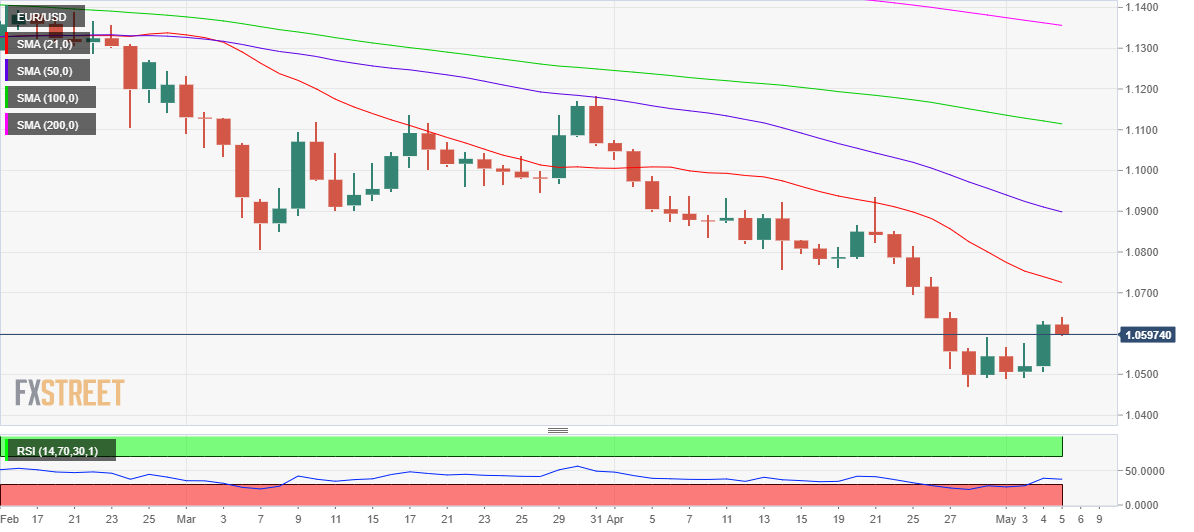
The recovery, however, appears short-lived, as the 14-day Relative Strength Index (RSI) still lurks below the midline, currently pointing south.
The immediate comfort for EUR bulls is aligned at the May 3 high near 1.0588, below which the 1.0550 psychological will be put at risk once again.
Sellers will then gear up for a fresh drop towards the 1.0500 key figure.
EUR/USD: Additional levels to consider
Preliminary readings from CME Group for natural gas futures markets noted open interest rose for the second session in a row on Wednesday, this time by around 11.6K contracts. On the other hand, volume shrank by around 92.3K contracts following two daily builds in a row.
Natural Gas now targets the August 2008 high at $9.60
The rally in prices of natural gas remained unabated for yet another session on Wednesday, this time briefly testing the area above the $8.00 mark per MMBtu, although closing below it. The advance was accompanied by rising open interest and allows for the continuation of the uptrend to, initially, the August 2008 peak at $9.60.

AUD/CAD has straddled a 6.8% price corridor since the start of the year. Advancing beyond Kijun resistance at 0.9283 should encourage a positive MACD signal turn underpinning the cross, Benjamin Wong, Strategist at DBS Bank reports.
Going long on base building
“The first resistance obstacle at 0.9168 has been cleared together with the 100-day moving average (DMA)/200-DMA resistance axis around 0.9207. The Kijun resistance at 0.9283 is next on the table. The standard deviation indicator at midline which allows more upside to unravel once the MACD (moving average convergence divergence) signal cuts to affirm.”
“AUD/CAD has edged higher from a recent 0.8909 low to top at 0.9516 but its retracement stood well at a 76.4% Fibonacci that provided a recent 0.9049 low. This has provided the buffer grounds for the current rally developing; base building is here.”
The Czech National Bank (CNB) is expected to raise policy rates by 50bps to 5.50%. In the view of economists at Commerzbank, the CNB is not adopting an entirely hawkish stance but markets are convinced that the central bank will turn decisively hawkish if required, supporting the koruna.
CNB to hike rate by 50b
“For now, it appears likely that the same 5-2 voting pattern, which we observed on 31 March, will repeat today – in favour of the same 50bp rate hike.”
“CNB's current stance does not fall into a particularly hawkish category, in our view – but, the Czech koruna is well supported because the FX market remains convinced that CNB will turn starkly hawkish and abandon signals of ending its tightening cycle, if and when required.”
- USD/CHF stays mildly bid around weekly low, reverses pullback from two-year high.
- 50-SMA, three-week-long ascending trend line restricts short-term downside.
- Further upside eyes 20-SMA, weekly resistance line ahead of 2020 peak.
USD/CHF reverses the previous day’s pullback from a two-year high as buyers attack 0.9750 heading into Thursday’s European session.
In doing so, the Swiss currency (CHF) pair portrays a recovery from a convergence of an upward sloping trend line from April 12 and 50-SMA, around 0.9700.
Given the firmer RSI, the USD/CHF pair’s recent rebound is likely approaching the 20-SMA level surrounding 0.9770. However, an ascending trend line connecting multiple tops marked since April 28, around 0.9825, will challenge the bull’s dominance.
In a case where USD/CHF rises past 0.9825, the year 2020 high of 0.9900 will be in focus.
Alternatively, a clear downside break of the 0.9700 support confluence won’t hesitate to refresh the weekly low under 0.9670.
Following that, late April’s swing high around 0.9590 and the 0.9500 round figure will be on USD/CHF bear’s radar.
USD/CHF: Four-hour chart
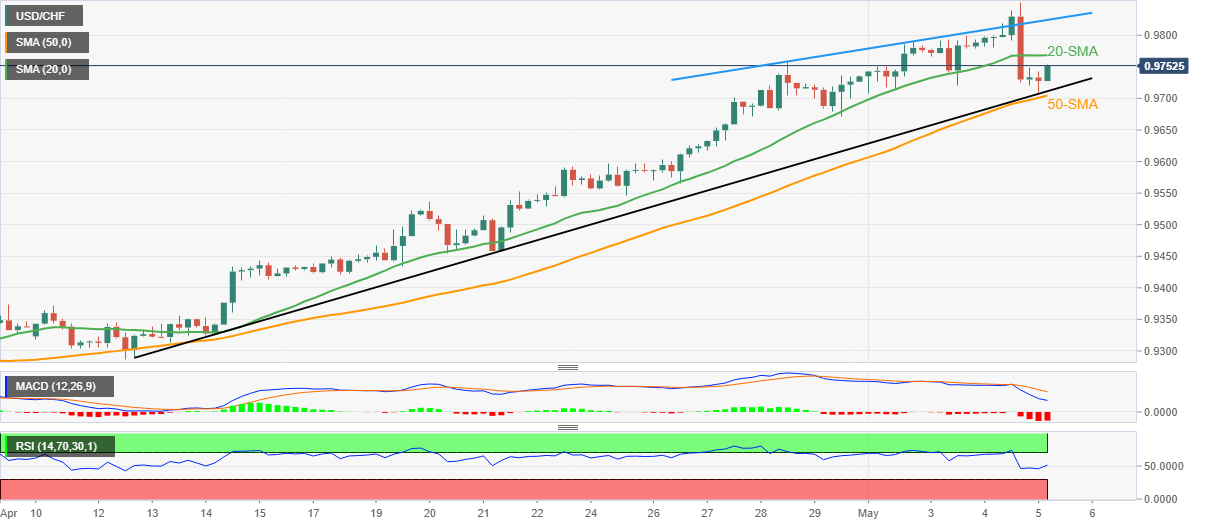
Trend: Further upside expected
The Polish central bank is expected to raise policy rates by 100bps to combat the high inflation pressures experienced for more than a year. This outcome is already priced-in, therefore, the zloty is set to shrug off the decision, economists at Commerzbank report.
NBP to hike by 100bp
“Poland’s 12.3% inflation rate still warrants a large rate step, although all CEE central banks now have to contend with added real economic risk from the Russia-Ukraine conflict – this might complicate the decision for some MPC members. But from what we could make out from the individual commentaries, most MPC members are emphasising the inflation risk over GDP risk.
“A 100bp rate hike today appears very likely. This is priced-in and should prove neutral for the zloty.”
Is it possible that the Bank of England (BoE) might speed things up and hike its key rate by 50bp? Economists at Commerzbank expect the “Old Lady” to adopt a cautious stance, weighing on the pound.
BoE might dampen the rate hike expectations for the next meetings
“The BoE is concerned about the effects the high inflation rates might have on consumer behaviour. At its last meeting, the vote in favour of a rate hike was not unanimous. One member voted in favour of keeping rates on hold. If one believes their recent comments, a 50bp rate hike today seems not terribly likely.”
“The market is expecting a further 25bp for each of the rate meetings over the course of the year. Our economists expect the BoE to take a break every so often too. If this emerges after today's meeting rate hike expectations on the markets might get corrected slightly to the downside, which would put pressure on sterling.”
See – BoE Preview: Forecasts from 11 major banks, another dovish hike on the cards
NZD/USD now faces some range bound trading between 0.6450 and 0.6610 in the next weeks, noted FX Strategists at UOB Group Lee Sue Ann and Quek Ser Leang.
Key Quotes
24-hour view: “We did not anticipate the sharp and swift rally that sent NZD soaring to an overnight high of 0.6556. While NZD could move above the 0.6556 high, any further advance is not expected to challenge the major resistance at 0.6610 (there is another resistance at 0.6575). On the downside, a breach of 0.6490 (minor support is at 0.6515) would indicate that the current upward pressure has eased.”
Next 1-3 weeks: “Yesterday (04 May, spot at 0.6435), we held the view that “the weakness in NZD is still intact but the pace of any further decline is likely to be slower”. We did not anticipate the sudden and sharp surge that sent NZD to a high of 0.6556. The breach of our ‘strong resistance’ level at 0.6500 indicates that the weakness in NZD that started more than a week ago has run its course. The current movement is viewed as the early stages of a consolidation phase and NZD is likely to trade between 0.6450 and 0.6610 for now.”
- German Factory Orders slumped 4.7% MoM in March.
- German Retail Sales arrived at -3.1% YoY in Feb vs. 4.3% previous.
- EUR/USD keeps range around d 1.0615 amid dismal German data.
The German Factory Orders fell sharply in March, suggesting that the manufacturing sector of Europe’s economic powerhouse is seeing a fresh downturn.
Contracts for goods ‘Made in Germany’ declined by 4.7% on the month vs. -1.1% expected and -0.8% last, the latest data published by the Federal Statistics Office showed on Thursday.
On an annualized basis, Germany’s Industrial Orders fell by 3.1% in the reported month vs. 4.3% previous.
FX implications
The shared currency remains unfazed by the disappointing German factory data.
At the time of writing, EUR/USD is down 0.08% on the day, trading at 1.0611.
Considering advanced prints from CME Group for crude oil futures markets, traders scaled back their open interest positions by just 56 contracts on Wednesday, adding to the previous day’s pullback. On the other hand, volume reversed three daily drops in a row and went up by around 26.1K contracts.
WTI trades closer to the April high
WTI prices posted strong gains on Wednesday. However, the uptick was in tandem with a small drop in open interest, which could hint at the idea that further gains could be losing some momentum. In the meantime, crude oil prices continue to target the April high past the $109.00 mark per barrel in the very near term.
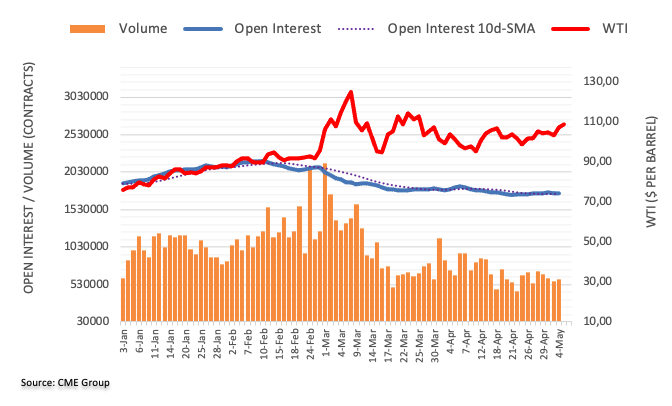
- Platinum stays firmer around two-week top, rises for a third consecutive day.
- Fed matched market forecasts of 50 bps rate hike, QT hints but Powell’s rejection of 75 bps move drowned USD.
- Markets remain cautious optimistic even as headlines from China, EU tests buyers.
- Second-tier US data can entertain traders ahead of Friday’s NFP.
Platinum (XPT/USD) prices grind higher surrounding $1,000, at a two-week top, on firmer market sentiment during early Thursday.
Alike other commodities, the XPT/USD also cheers the post-Fed cautious optimism, as well as the sluggish US dollar while printing a two-week high, not to forget rising for the third consecutive day. The run-up, however, remains capped by the key DMAs and challenges to sentiment, mainly concerning Russia and China.
The US Dollar Index (DXY) licks the post-Fed wounds, up 0.13% intraday around 102.65. Even so, the greenback gauge isn’t out of the woods as it struggles to refresh intraday high while trying to reverse the biggest daily loss in two months.
The DXY dropped the previous day as Fed Chair Jerome Powell ruled out a rate hike worth 75 basis points (bps) in upcoming meetings, which was something the market players were expecting. Even so, the Fed matched wide market forecasts by providing 50 basis points (bps) of a rate hike and clues for the Quantitative Tightening (QT) the previous day.
Talking about the negatives to risk appetite, the US-China tussles as the US Securities and Exchange Commission (SEC) added over 80 Chinese firms to the list of companies facing probable delisting from the US exchanges. On the same line were ongoing covid woes and the European Union’s (EU) sixth round of sanctions on Russia.
Looking forward, XPT/USD prices may keep cheering the USD weakness, as well as cautious optimism in the market ahead of Friday’s US jobs report. Though, today’s second-tier US data and BOE may offer intermediate moves.
Technical analysis
A clear upside break of the two-month-old descending trend line, around $968.00, keeps platinum buyers hopeful. However, the 200-DMA and the 100-DMA, respectively near $1005 and $1015, challenge the short-term upside of the metal.
FX option expiries for May 5 NY cut at 10:00 Eastern Time, via DTCC, can be found below.
- EUR/USD: EUR amounts
- 1.0500 1.6b
- 1.0570-80 810m
- 1.0600 1.8b
- 1.0675 290m
- 1.0750-55 1.0b
- 1.0765 600m
- GBP/USD: GBP amounts
- 1.2550 502m
- 1.2590 320m
- 1.2700 392m
- USD/JPY: USD amounts
- 128.00 410m
- 130.70 395m
- USD/CHF: USD amounts
- 0.9700 230m
- AUD/USD: AUD amounts
- 0.7000 516m
- 0.7030 343m
- 0.7135 393m
- USD/CAD: USD amounts
- 1.2615 280m
- 1.2870 513m
- 1.2890 761m
- 1.3075 1.2b
- 1.3100 2.6b
According to FX Strategists at UOB Group Lee Sue Ann and Quek Ser Leang, GBP/USD is now expected to navigate within the 1.2520/1.2720 range in the next weeks.
Key Quotes
24-hour view: “We expected GBP to ‘trade sideways within a range of 1.2460/1.2555’ yesterday. GBP dropped to 1.2453 during NY session before lifting off and rocketed to a high of 1.2638. While the rapid rise appears to be overdone, GBP could advance to 1.2660 first before easing. The major resistance at 1.2730 is not expected to come under threat. Support is at 1.2595 followed by 1.2560.”
Next 1-3 weeks: “We highlighted yesterday (04 May, spot at 1.2500) that there is still chance, albeit not a high one for GBP drop below last week’s low near 1.2410. However, GBP jumped above our ‘strong resistance’ level at 1.2600 (high of 1.2638). The break of the ‘strong resistance’ level indicates that the downside risk has dissipated. The current movement appears to be the early stages of a consolidation phase. In other words, GBP is likely to trade sideways for now, expected to be within a range of 1.2520/1.2720.”
- AUD/USD juggles in a 0.7227-0.7265 range ahead of the RBA monetary policy statement.
- An outperformance in Trade Balance by the Australian administration has supported the antipodean.
- Fed’s expected aggressiveness has underpinned the risk-on impulse.
The AUD/USD pair is oscillating in a narrow range of 0.7227-0.7265 as aussie bulls lose momentum but the upside is still intact. A sheer upside move has been recorded in the asset after the Federal Reserve (Fed) unveiled its monetary policy on Wednesday.
The announcement of 50 basis points (bps) and sheer balance sheet reduction was on the cards and the Fed stood on its expectations. But what delighted the Fx domain is fading odds of a 75 bps interest rate hike in the remaining year. Fed chair Jerome Powell denied the possibility of a three-fourth a percent rate hike but warns of more 50 bps rate hikes going forward. The safeguard from ultra-aggressive hawkish tone has underpinned the risk-perceived currencies.
Meanwhile, the antipodean geared up strongly after an unexpected rate hike by the Reserve Bank of Australia (RBA) on Tuesday. RBA Governor Philip Lowe elevated its interest rate by 35 basis points (bps) to combat the galloping inflation. Now, investors are focusing on the monetary policy statement by the RBA, which is due on Friday. The will provide the strategic plan of the RBA policymakers behind the unexpected rate hike decision. Apart from that, the positive Trade Balance has also supported aussie. The Australian Bureau of Statistics has reported the monthly Trade Balance at 9314M higher than the forecast of 8500M and the prior print of 7457M.
Gold has regained the $1,900 mark. As FXStreet’s Dhwani Mehta notes, XAU/USD needs to beat the $1,920-$1,925 hurdle to confirm Fed-led bullish reversal.
BoE hawkish stance to aid gold recovery
“Attention now turns towards the Bank of England (BoE) interest rate decision. Should the BoE surprise with a more hawkish stance, then the dollar correction would gather steam, aiding the recovery mode in Gold Price. The dollar bulls will jump back into the game if the BoE disappoints the hawks and triggers a fresh sell-off in GBP/USD. The renewed upside in Gold Price could come to a pause.”
“XAUUSD is on its way to test the immediate upside barrier at $1,907, the 38.2% Fibonacci Retracement (Fibo) level of the recent downtrend from April 18 highs of $1,998 to this week’s low of $1,850. If bulls take out this hurdle, then a fresh advance towards the $1,920-$1,925 confluence area cannot be ruled out.”
“If sellers lurk at the 38.2% Fibo barrier, then Gold Price could see a quick pullback towards the $1,900 level. The next support will be at the 23.6% Fibo level of $1,885, below which the 100-DMA, now at $1,881, will be put to test. Tuesday’s high at $1,878 could challenge the bullish commitments should the retracement pick up steam.”
See – BoE Preview: Forecasts from 11 major banks, another dovish hike on the cards
- EUR/GBP pares intraday gains, retreats from weekly top.
- Successful rebound from 100-DMA, 38.2% Fibonacci retracement joins bullish MACD signals to favor buyers.
- Convergence of descending trend line from September 2021, 61.8% Fibo appears strong resistance.
EUR/GBP bulls keep reins on the Bank of England (BOE) monetary policy decision day, i.e. Thursday. That said, the quote prints 0.55% intraday gains, the most in a week, while heading into the European session.
Also read: BOE Preview: Bailey needs to go beyond a rate hike to boost GBP/USD on Super Thursday
The cross-currency pair’s recovery from the 100-DMA and 38.2% Fibonacci retracement (Fibo) of September 2021 to March 2022 downside, near 0.8375, enables it to post the latest jump. The upside momentum also gains support from MACD and RSI, which in turn suggest the quote’s additional run-up towards April’s peak of 0.8467.
However, a convergence of the 61.8% Fibo and a descending trend line from late 2021, around 0.8485, becomes a tough nut to crack for the EUR/GBP bulls.
Should the quote rises past 0.8485, it can quickly cross March’s peak of 0.8512 by aiming for the late 2021 swing high surrounding 0.8550.
On the contrary, pullback moves remain elusive beyond the 0.8375 support confluence, a break of which will again highlight multiple supports surrounding 0.8300 for the EUR/GBP bears.
Overall, EUR/GBP prices are ready for further upside but need validation from 0.8485.
EUR/GBP: Daily chart
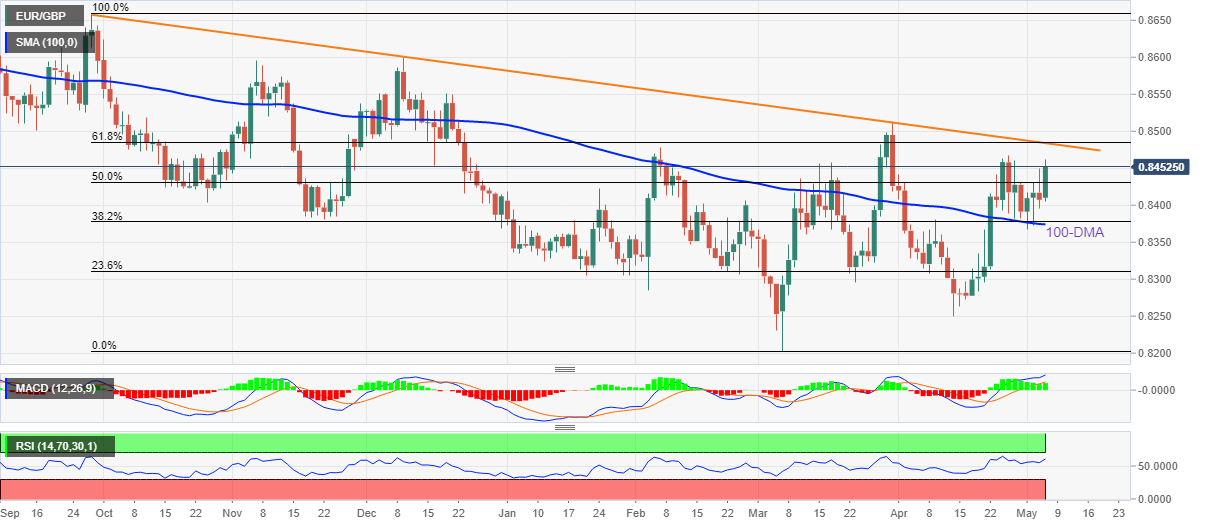
Trend: Limited upside expected
- NZD/USD has turned sideways after a firmer upside move as the US NFP hogged the limelight.
- The Fed is going to reduce its bumper balance sheet vigorously.
- The kiwi administration is enjoying a tight labor market.
The NZD/USD pair has witnessed some long liquidation after failing to sustain above 0.6560. The asset is expected to display back and forth moves in a narrow range of 0.6531-0.6568 after a juggernaut upside move. No one could deny the fact that consistent employment data by Statistics New Zealand on Wednesday failed to entertain the kiwi bulls but the in-line hawkish tone by the Federal Reserve (Fed) in its monetary policy announcement has strengthened the antipodean.
The Fed announced a rate hike by 50 basis points (bps) and a balance sheet reduction by $95 billion worth of assets ($60 billion of Treasuries and $35 billion of mortgage-backed securities (MBS)) monthly. One can understand the need of barricading the soaring inflation by observing the pace dictated by the Fed to reduce its bumper $9 trillion balance sheet. The Fed reduced its balance sheet size by $50 billion worth of assets on monthly basis in the 2017-19 rate hike cycle. This time the pace to cut assets in its balance sheet is almost doubled. The US inflation has been recorded at a four-decade high of 8.5% and it is hurting the real income of the households.
On the kiwi front, Statistics New Zealand reported the jobless rate at 3.2% while the Employment Change to 0.1% on Wednesday. The consistency in maintaining full employment levels determines the tight labor market, which benefits the Reserve Bank of New Zealand (RBNZ) to hike interest rates without much concern.
Going forward, investors will keep the release of the US Nonfarm Payrolls (NFP) on the radar. A preliminary estimate for the US NFP is 394k in comparison with the previous figure of 431k.
CME Group’s flash data for gold futures markets noted open interest increased for the second session in a row on Wednesday, this time by nearly 13K contracts. Volume, instead, dropped for the second straight day, now by more than 7K contracts.
Gold now targets $1920
Prices of the ounce troy of the yellow metal edged higher on Wednesday amidst rising open interest, leaving the door open to the continuation of the rebound in the very near term. That said, gold now targets the recent peak around $1920 (April 29).
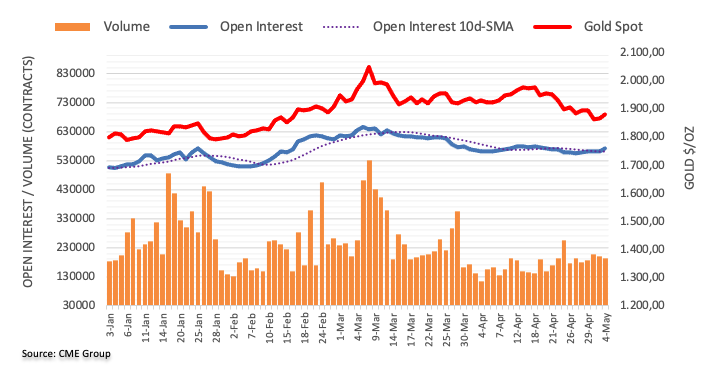
FX Strategists at UOB Group Lee Sue Ann and Quek Ser Leang suggested EUR/USD could now extend the recovery to the 1.0695 level.
Key Quotes
24-hour view: “We did not expect the strong surge in EUR during NY session that sent it to a high of 1.0630. The strong advance has room to extend but in view of the overbought conditions, a sustained rise above 1.0665 is unlikely (minor resistance is at 1.0640). Support is at 1.0590 followed by 1.0570.”
Next 1-3 weeks: “Yesterday (04 May, spot at 1.0520), we highlighted that a breach of 1.0610 would suggest that 1.0470 is a short-term bottom. EUR subsequently blew past 1.0610 as it surged to a high of 1.0630 during NY session. While it is premature to expect a major reversal, the current short-term EUR strength could extend to 1.0695. At this stage, the odds for a break of this level are not high. On the downside, ‘strong support’ is at 1.0520. The 1.0470 level is unlikely to come into the picture, at least for several days, possibly up to a couple of weeks.”
Commenting on a potential July rate hike, European Central Bank (ECB) executive board member Fabio Panetta said Thursday, “it would be incautious to act on rates before seeing Q2 data.”
“The ECB could end negative rates cycle after deciding when to conclude QE in Q3,” Panetta said.
He went on to say that the ECB needs “to fight inflation we also need to strengthen European cooperation.”
Additional comments
Digital euro would be solid, reliable currency, could be issued in four or five years if ecb and European authorities decide to do so.
Supporting Ukraine and working to bring the war to a quick end is also the most effective way to reduce inflation quickly.
Market reaction
EUR/USD has stalled its Fed-inspired recovery rally but holds above 1.0600. The pair is currently trading at 1.0614, unfazed by the above comments, down 0.05% on the day.
- A firmer plunge below the 200-EMA has advocated yen bulls' domination.
- The asset is testing the supply zone placed in a narrow range of 129.32-129.46.
- Momentum oscillator RSI (14) has shifted into a bearish range of 20.00-40.00.
The USD/JPY pair has witnessed a steep fall after the downside break of the consolidation placed in a narrow range of 129.70-130.48 on Wednesday. The Japanese yen took control after the major printed a multi-year high of 131.25 last week.
A usual test of the supply zone placed in a narrow range of 129.32-129.46 is displaying an optimal opportunity to create short buildups for the market participants. The asset has slipped below the 200-period Exponential Moving Average (EMA) at 129.30, which adds to the downside filters.
The Relative Strength Index (RSI) (14) has shifted into a bearish range of 20.00-40.00, which indicates a fresh leg of weakness in the counter.
A bear cross of 20- and 200-period (EMAs) looks certain, which will infuse an adrenaline rush into the yen bulls.
For an ideal short build-up, investors should use the pullback towards the 20-EMA at 129.46 as a selling opportunity. This will drag the asset towards Wednesday’s low and the round level support at 128.46 and 127.00 respectively.
On the flip side, greenback bulls may dominate the asset if it oversteps Monday’s high at 130.48. This may push the asset to reclaim its recent multi-year high at 131.25, followed by the round level resistance at 132.00.
USD/JPY hourly chart
-637873239673881099.png)
- USD/CAD renews weekly low during three-day downtrend.
- EU sanctions on Russia challenge oil supplies, underpinning energy prices.
- Fed’s Powell triggered USD weakness by rejecting 75 bps rate hike expectations.
- Second-tier US data, risk catalysts will direct short-term moves ahead of Friday’s jobs report from the US and Canada.
USD/CAD remains pressured around a one-week low, despite being defensive around 1.2700 ahead of Thursday’s European session. In doing so, the Loonie pair stays on the back foot for the third consecutive day as prices of Canada’s key exports, namely WTI crude oil, refreshed its two-week top while the US dollar struggles to overcome the post-Fed losses.
WTI crude oil seesaws around a two-week high, up 0.60% intraday to $108.15 by the press time. The black gold rose the most in three weeks the previous day and extended the gains amid initial Thursday’s trading as geopolitical headlines from the European Union (EU) hint at the supply crunch.
On the other hand, the US Dollar Index (DXY) licks the post-Fed wounds, up 0.13% intraday around 102.65. Even so, the greenback gauge isn’t out of the woods as it struggles to refresh intraday high while trying to reverse the biggest daily loss in two months.
That said, the DXY dropped the previous day as Fed Chair Jerome Powell ruled out a rate hike worth 75 basis points (bps) in upcoming meetings, which was something the market players were expecting. Even so, the Fed matched wide market forecasts by providing 50 basis points (bps) of a rate hike and clues for the Quantitative Tightening (QT) the previous day.
It should be observed that the market sentiment also dwindles of late and helps the oil prices to remain firm. Among the key risk catalysts that recently gained market attention are the US-China tussles as the US Securities and Exchange Commission (SEC) added over 80 Chinese firms to the list of companies facing probable delisting from the US exchanges. On the same line were ongoing covid woes and the European Union’s (EU) sixth round of sanctions on Russia. Against this backdrop, the S& 500 Futures drop 0.12% intraday, snapping a three-day rebound from a yearly low, despite Wall Street’s rally.
Looking forward, the US Jobless Claims, Nonfarm Productivity and Unit Labor Cost details may entertain USD/CAD traders but major attention will be given to the risk catalysts ahead of the key Friday when the Canadian and the US employment data for April will be out.
Read: USD/CAD Weekly Forecast: Is WTI vulnerable?
Technical analysis
A clear break of the previous support line from April 21 and a bear cross of the 21-DMA over the 100-DMA act as strong incentives for sellers. Also supporting USD/CAD bears are the recently easing MACD bullish signals and steady RSI.
That said, the pair’s further downside towards 21-DMA, around 1.2690 by the press time, becomes imminent. Meanwhile, the corrective pullback may initially aim for the 1.2800 threshold before the mid-March top surrounding 1.2875.
- Gold Price extends the rebound as the US dollar corrects with Treasury yields.
- Fed tempers aggressive rate hike bets, lifts the overall market mood.
- Healthy support levels cap gold’s downside, more recovery gains in the offing.
Gold Price is capitalizing on an overdue correction in the US dollar, as the Fed poured cold water on aggressive tightening bets. Fed Chair Jerome Powell explicitly said Wednesday that the US central bank is not considering a 75 bps rate hike in June, sounding a less hawkish tone than markets had expected. The US Treasury yields also took a beating while the Wall Street indices gallops on a risk-on market profile. The dollar also felt the pain from reduced demand for safe havens, aiding the Gold Price rebound. Looking forward, the US Nonfarm Payrolls will offer fresh insights on the Fed’s forward guidance. In the meantime, the broader market sentiment and China’s covid lockdowns-led growth fears will continue to influence gold trades.
Also read: Gold Price Forecast: XAU/USD needs to beat $1,920-$1,925 hurdle to confirm Fed-led bullish reversal
Gold Price: Key levels to watch
The Technical Confluences Detector shows that Gold Price failed to find acceptance above the powerful barrier at $1,904, where the Fibonacci 23.6% one-week and the previous high four-hour converge.
Fresh buying opportunities above the latter will see a test of the $1,906 level, which is the pivot point one-day R2.
The Fibonacci 61.8% one-week at $1,912 could guard the further upside.
The next critical upside target is seen around $1,920-$1,925. That price area is the confluence of the Fibonacci 38.2% one-month and pivot point one-day
Alternatively, if the recovery momentum fizzles out, then sellers could go back to test the SMA10 one-day and Fibonacci 38.2% one-week around $1,897.
The bulls will await the next support at the pivot point one-day R1 at $1,894, below which the previous day’s high of $1,889 will be back into play.
The Fibonacci 23.6% one-week at $1,887 will be on the sellers’ radars If the pullback gathers steam.
Here is how it looks on the tool
About Technical Confluences Detector
The TCD (Technical Confluences Detector) is a tool to locate and point out those price levels where there is a congestion of indicators, moving averages, Fibonacci levels, Pivot Points, etc. If you are a short-term trader, you will find entry points for counter-trend strategies and hunt a few points at a time. If you are a medium-to-long-term trader, this tool will allow you to know in advance the price levels where a medium-to-long-term trend may stop and rest, where to unwind positions, or where to increase your position size.
- Aggressive plans of the Fed to tack inflation have favored the positive market sentiment.
- Chinese markets have continued their winning streak despite rising Covid-19 cases and oil prices.
- Going forward, US NFP will entertain the global markets.
Markets in the Asian domain are gaining sharply higher as risk-on impulse got triggered after the Federal Reserve (Fed) announced May’s monetary policy on Wednesday. The announcement of a jumbo rate hike and roadmap of balance sheet reduction was already forecasted therefore, the risk-sensitive assets found bids from the responsive buyers and moved firmly higher.
At the press time, Shanghai surges 1.11%, Hang Seng jumps 0.65%, and Nifty50 gained more than 1%. Japan’s markets are still closed on account of Children’s Day. Japan’s bourses were also closed on Wednesday on account of Greenery Day.
Chinese markets are rallying higher on Thursday after remaining closed in the last four trading sessions. The dragon economy has ignored the impact of surging oil prices after Europe indicated an embargo on Russian oil within six months. However, the European Union (EU) has yet not unveiled its suppliers who will address the daily demand of 3.5 million barrels. Also, the resurgence of the Covid-19 in China’s financial hub Shanghai and the capital Beijing has failed to exhaust the momentum of bulls.
Meanwhile, the US dollar index (DXY) has witnessed some exhaustion in its downside momentum. The DXY is oscillating in a narrow range of 102.36-102.67 in the Asian session. It won’t be wrong to state that the DXY has been established below 103.00 firmly. Post the hangover of the Fed’s policy, investors are shifting their focus towards the release of the US Nonfarm Payrolls (NFP), which are due on Friday. The US NFP is seen at 394k against the previous figure of 431k.
- WTI retreats from 12-day top inside rising wedge bearish chart pattern.
- Bearish RSI divergence, multiple hurdles to the north keep sellers hopeful.
- April’s top holds the key to further upside, $102.70 appears a tough nut to crack for bears.
WTI crude oil prices pare intraday gains around $107.00, the highest levels in two weeks, during the final hours of Thursday’s Asian session.
The black gold rose the most in three weeks the previous day and extended the gains amid initial Thursday’s trading as geopolitical headlines from the European Union (EU) hint at the supply crunch.
The run-up, however, failed to cross a fortnight old ascending trend line, forming part of the rising wedge bearish formation. Also teasing WTI sellers is the bearish RSI divergence, a condition where prices make higher-high but the RSI line (14) doesn’t.
That being said, the quote’s further weakness could aim for Monday’s peak surrounding $105.00. However, a convergence of the 100-SMA and lower line of the aforementioned wedge will offer strong support at around $102.70.
Should the commodity prices drop below $102.70, it becomes vulnerable to slump towards April’s low surrounding $92.60.
Alternatively, an upside clearance of the wedge’s resistance line, at $108.15 by the press time, will defy the bearish chart pattern.
Even so, multiple tops marked during April, below $109.15, as well as the $110.00 threshold, will challenge WTI bulls afterward.
WTI: Four-hour chart
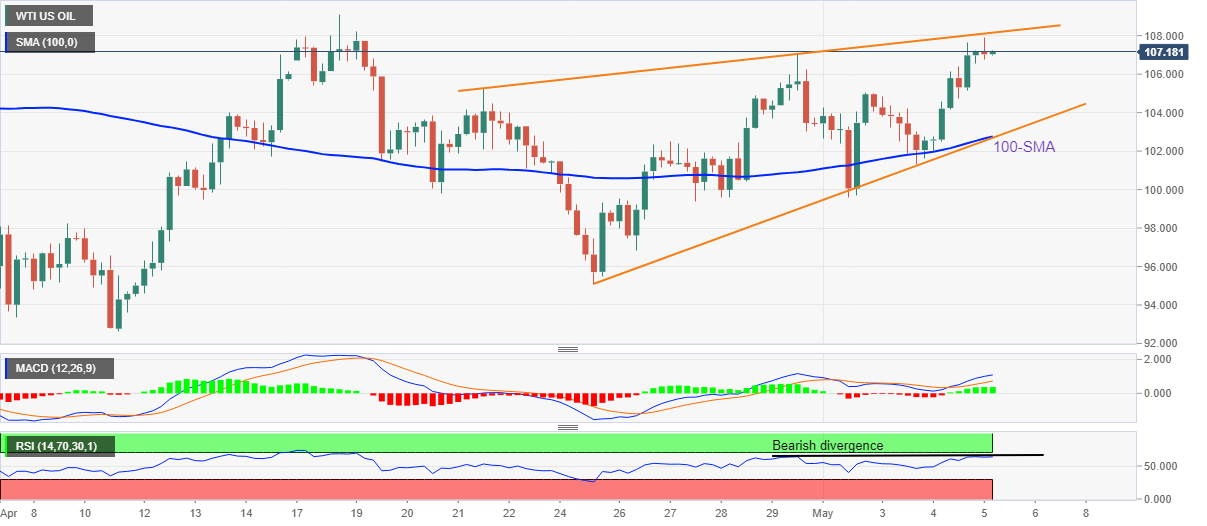
Trend: Pullback expected
- GBP/USD pulls back from weekly top, consolidates the biggest daily gains in 13 months.
- UK PM Johnson renews NI protocol jitters amid Irish elections, pushing EU over compromise.
- USD struggles for clear directions around one-week low after the post-Fed slump.
- BOE is likely to announce 25 bps rate hike but bulls need more to keep control.
GBP/USD takes offers to renew intraday low around 1.2580, extending the pullback from the weekly top while paring the heaviest daily jump since April 2021. Headlines concerning Brexit hardships and cautious sentiment amid the Northern Ireland (NI) election, as well as ahead of the Bank of England (BOE) monetary policy, seem to favor sellers during early Thursday morning in Europe. That said, the post-Fed USD weakness propelled cable the previous.
UK PM Boris Johnson renewed Brexit woes by giving the European Union (EU), “one last chance” to compromise over Northern Ireland (NI) protocol, per The Times. The move could have been a political gimmick as NI elections begin on Thursday.
Also weighing on the GBP/USD prices are headlines challenging the risk appetite, mainly emanating from the European Union (EU) and China. The EU’s sixth round of sanctions on Russia and readiness for more hints at further hardships for Western friends including the UK. Elsewhere, the US Securities and Exchange Commission (SEC) added over 80 Chinese firms to the list of companies facing probable delisting from the US exchanges while the covid conditions also remain grim in the world’s second-largest economy.
Amid these plays, the S& 500 Futures drop 0.10% intraday, snapping a three-day rebound from a yearly low, despite Wall Street’s rally.
Looking forward, the BOE is up for 25 basis points (bps) of a rate hike, as already conveyed in the previous meeting. Though, economic hardships due to the escalating inflation pressure market players to seek something more than what’s promised from the “Old Lady”. Should the British central bank match market forecasts, the GBP/USD may reverse the previous day’s gains while copying the USD’s conditions post-FOMC.
Other than the BOE, the US Jobless Claims, Nonfarm Productivity and Unit Labor Cost will also entertain GBP/USD traders ahead of Friday’s US jobs report.
Also read: BOE Preview: A 25 bps rate hike can’t save GBP bulls amid economic gloom
Technical analysis
GBP/USD rebound remains elusive unless crossing a downward sloping trend line from April 2021, around 1.2850 by the press time. On the contrary, lows marked during January 2019 and the latest bottom, respectively around 1.2430 and 1.2410, challenge the cable pair’s downturn.
- USD/INR has slipped below its eight-day low at 76.20 as DXY weakens.
- The synergy of rate hikes and quantitative easing may control the soaring inflation.
- The RBI has raised its repo rate by 40 bps and CRR by 50 bps overnight.
The USD/INR pair has witnessed heavy selling pressure at open and has continued its two-day losing streak as hawkish Federal Reserve (Fed) policy has cornered the greenback. A similar open-high structure at open is denoting a bearish open-drive session to take place in today’s session.
An aggressive hawkish monetary policy by the Fed has underpinned the positive market sentiment. If someone will consider the announcements, the rate hike by 50 basis points (bps) and the sheer pace for balance sheet reduction was already discounted by the market participants. Therefore, a rebound in the risk-perceived assets was highly likely. To contract liquidity from the economy, the Fed will reduce its whooping balance sheet with $95 billion worth of assets on monthly basis. This may synergy with the rate hike measures to leash the soaring inflation. The policy announcement has weighed tremendous pressure on the US dollar index (DXY). The DXY has tumbled to near 102.50.
On the Indian rupee front, the Reserve Bank of India (RBI) has raised its repo rate for the first time in the last four years. The RBI has elevated the borrowing rates by 40 bps to 4.4%. It is interesting to note that the RBI has stepped up its repo rate with immediate effect after an emergency meeting. While the Cash Reserve Ratio (CRR) is increased by 50 bps. The decision has been taken to ensure that inflation should remain n the target range. Higher crude and commodity prices are hurting the real income of households to curtail the roaring inflation, quantitative need to be tightened.
- AUD/USD consolidates the biggest daily run-up since November 2011, sidelined of late.
- 100-DMA guards immediate upside, 61.8% Fibonacci retracement offers nearby support.
- MACD teases buyers but 0.7285 appears strong resistance.
AUD/USD remains sidelined around 0.7250, down 0.25% intraday, after positing the heaviest daily jump in over a decade. In doing so, the Aussie pair seesaws inside a 30-pip trading range during early Thursday, following the post-Fed rally.
The quote’s strong run-up the previous day crossed the 61.8% Fibonacci retracement (Fibo.) of January-April advances, backed by the receding bearish bias of the MACD. However, the 100-DMA caps immediate upside moves around 0.7265.
Even if the AUD/USD prices rally beyond 0.7265, a confluence of the 200-DMA and a monthly resistance line, around 0.7285, appear a tough nut to crack for the bulls, a break of which will propel the pair towards the mid-April low near 0.7340.
Meanwhile, pullback moves remain unimportant beyond the aforementioned key Fibo. level surrounding 0.7230.
Following that, March’s bottom of 0.7165 and lows marked during late February, around 0.7090, could test the AUD/USD bears.
Overall, AUD/USD is a strong contestant for the bullish move but needs validation from 0.7285.
AUD/USD: Daily chart
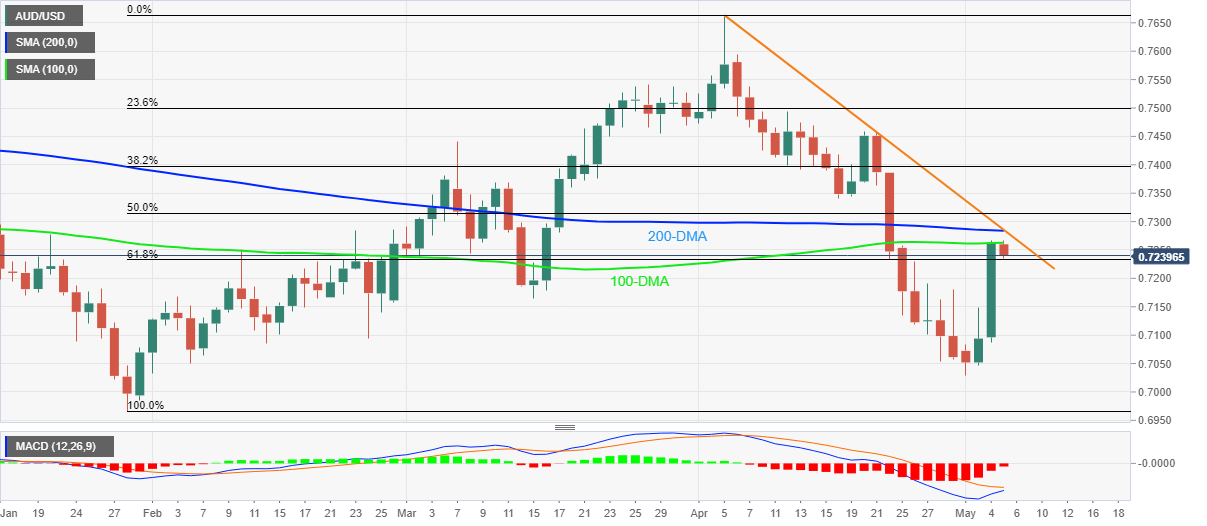
Trend: Sideways
- EUR/USD is trading sideways but may start rallying again amid broader weakness in the greenback.
- The Fed will reduce its balance sheet size at a much faster pace than in 2017-19.
- A European embargo on Russian oil can take place within six months.
The EUR/USD pair is oscillating in a narrow range of 1.0603-1.0642 in the Asian session after a firmer upside move from 1.0534. The asset is collecting more investors and will resume rallying higher to test 1.0650. An aggressive hawkish Fed policy has activated the ‘Buy on Rumor and Sell on News’ indicator, which is driving the risk-perceived currencies.
Fed chair Jerome Powell dictated the roadmap of balance sheet reduction along with a rate hike by 50 basis points (bps). The intention is to squeeze liquidity from the economy at a much faster pace by curtailing the whooping size of the $9 trillion balance sheet. A reduction in the balance sheet will be done by cutting $95 billion worth of assets ($60 billion of Treasuries and $35 billion of mortgage-backed securities (MBS)) monthly. Compared to the pace of the balance sheet reduction program initiated in 2017-2019 in which $50 billion worth of assets were targeted to reduce monthly. It states that the Fed is culling its assets at double the pace of the 2017-19 period.
Considering the multi-decade high inflation, it looks like the collaborative effort of rate hikes and quantitative easing is highly required to curb the inflation mess.
Meanwhile, the shared currency is expected to face the headwinds of oil supply as the European Union (EU) is looking to embargo oil from Russia within six months. Moving to another supplier or group of suppliers for 3.5 million barrels per day (bps) won’t be a cakewalk for the trading bloc. This could trigger the fears of a higher jobless rate further.
Going forward, the action in the asset will be handed over to the US economic data. The US Nonfarm Payrolls (NFP) will release on Friday and are expected to land at 394k against the prior print of 431k.
Chinese traders return to markets after a four-day holiday break, with some encouraging news coming out from the cities’ authorities on the coronavirus front.
According to CCTV, covid cases in Shanghai city fell slightly while new infections in Beijing stabilized.
Shanghai reported 4,651 cases for Wednesday, down from 4,982 on Tuesday. Beijing reported 50 cases on Wednesday, compared with 51 on Tuesday, per Bloomberg.
The slowdown in the covid cases suggests the country’s extreme restrictive measures to contain an outbreak are having an effect.
more to come ....
The People's Bank of China (PBOC) vowed to offer more monetary policy support to ramp up economic growth, dented by the latest coronavirus outbreaks in the country.
The PBOC said Wednesday, "(We shall) waste no time planning incremental policy tools to support steady economic growth, stabilize employment and prices ... to provide a fair monetary and financial environment.”
Last week, China's central bank pledged to maintain orderly growth for the property sector while continuing to monitor and control financial risks.
The policy support is much-needed at a time when the covid lockdowns in the world’s second-largest economy have fuelled a severe contraction in the services and manufacturing sector. China’s Caixin Services PMI contracted to 36.2 in April vs. 42.00 reported in March.
Related reads
- China Caixin Services miss caps AUD advance
- USD/CNH Price Analysis: Extends bounce off weekly low towards 6.6400 on downbeat China data
| Raw materials | Closed | Change, % |
|---|---|---|
| Brent | 110.18 | 3.79 |
| Silver | 22.997 | 1.73 |
| Gold | 1881.74 | 0.73 |
| Palladium | 2247.71 | -0.16 |
- Gold prices renew daily tops during three-day uptrend.
- DXY remains pressured near one-week low on Fed Chair Powell’s rejection of 75 bps rate hike.
- Sino-American crisis, covid fears and geopolitical headlines concerning Russia contribute to the cautious mood but fail to underpin USD strength.
- US NFP will be in focus, BOE, risk catalysts will direct short-term moves.
Gold (XAU/USD) prices remain firm for the third consecutive day while refreshing weekly top around $1,900 during early Thursday. In doing so, the yellow metal takes clues from the softer US dollar, as well as the market’s cautious mood on China’s return.
The US dollar’s weakness could be linked to Fed Chair Jerome Powell’s rejection of a rate hike worth 75 basis points (bps) in upcoming meetings. That said, the Fed matched wide market forecasts by providing 50 basis points (bps) of a rate hike and clues for the Quantitative Tightening (QT) the previous day.
Elsewhere, China’s return to markets allows traders to rethink the post-Fed optimism but the doubts over the US dollar, especially after the Fed moves, seem to direct the safe-haven flow to gold. Among the key risk catalysts that recently gained market attention are the US-China tussles as the US Securities and Exchange Commission (SEC) added over 80 Chinese firms to the list of companies facing probable delisting from the US exchanges. On the same line were ongoing covid woes and the European Union’s (EU) sixth round of sanctions on Russia.
While portraying the mood, the S& 500 Futures drop 0.12% intraday, snapping a three-day rebound from a yearly low, despite Wall Street’s rally.
Although the risk aversion wave and softer US dollar, coupled with the technical breakout, underpin gold price upside, the cautious mood ahead of Friday’s US Nonfarm Payrolls (NFP) may challenge the metal buyers. For the day, US Jobless Claims, Nonfarm Productivity and Unit Labor Cost, as well as the Bank of England (BOE) monetary policy meeting, can entertain the XAU/USD traders.
Also read: Markets breathe sigh of relief
Technical analysis
A clear upside break of a 13-day-old descending trend line and 50-SMA, around $1,890 by the press time, joins upbeat RSI line to direct gold buyer towards the 38.2% Fibonacci retracement (Fibo.) of April 18 to May 03 downside, around $1,908.
Following that, highs marked during late April and 200-SMA, respectively around $1,920 and $1,930, could test the bulls before giving them control.
On the contrary, pullback moves may aim for the $1,890 retest before calling the gold sellers.
Also acting as a downside filter is one-week-old horizontal support near $1,870, a break of which will direct XAU/USD towards the weekly low of $,1850.
Gold: Four-hour chart
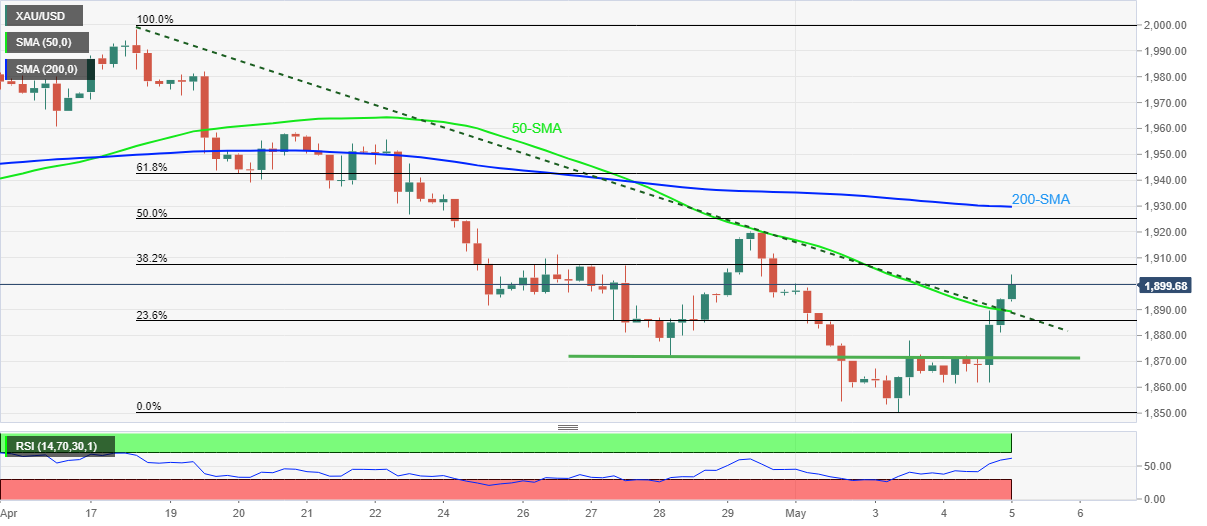
Trend: Further upside expected
- USD/CNH snaps two-day downtrend, picks up bids to poke intraday high.
- China’s Caixin Services PMI dropped to the lowest levels in two years.
- 21-SMA lures immediate upside moves, bears need validation from 6.6090.
USD/CNH takes the bids to refresh intraday high around 6.6325, up 0.23% on a day, after China’s Caixin Services disappointed traders during early Thursday.
That said, the aforementioned private services gauge not only dropped below42.0 previous readouts but also slumped to the 25-month low while flashing a 36.2 figure for April 2022.
Read: China Caixin Services miss caps AUD advance
Softer data helps USD/CNH to extend the early Asian session rebound from one-week-old horizontal support.
Given the firmer RSI support the latest recovery moves from the short-term key support, USD/CNH braces for a 21-SMA level of 6.6583.
However, descending trend line from Tuesday, near 6.6630, will challenge the USD/CNH bulls afterward, a break of which will direct prices towards the weekly resistance line near 6.7000.
Meanwhile, pullback moves remain elusive until staying beyond the April 29 high of 6.6090.
Following that, the 6.6000 threshold may test bears before directing them to the 6.5450 level comprising lows marked on April 24.
USD/CNH: Four-hour chart
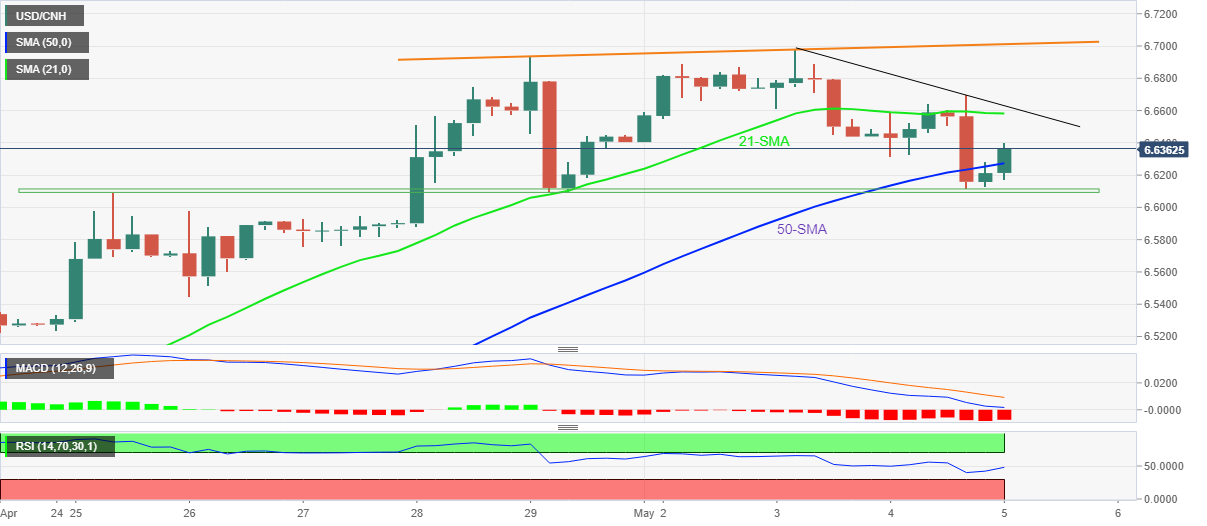
Trend: Further recovery expected
The Chinese Caixin Services PMI as follows:
- China caixin services PMI April: 36.2 (est 40.0; prev 42.0).
- Caixin composite PMI April: 37.2 (prev 43.9).
The data has taken some of the wind out of the Aussie's sails as follows:
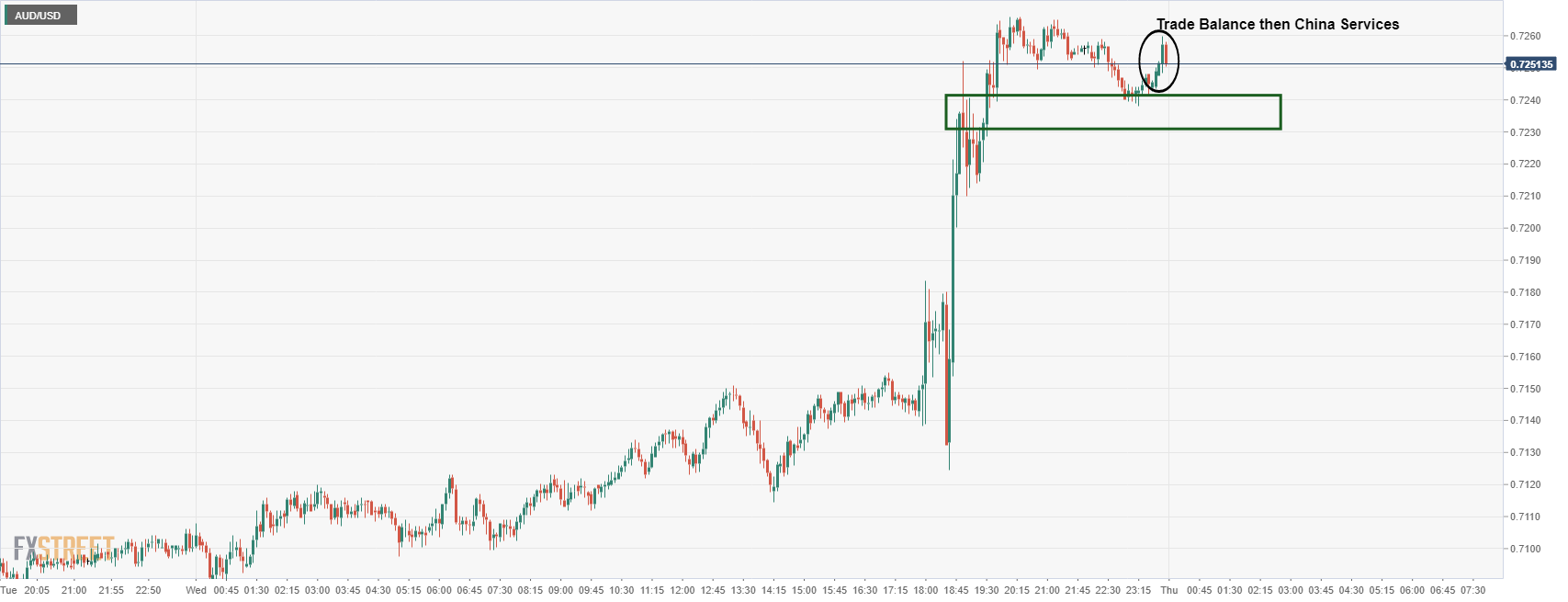
The Aussie is firm following the Federal Reserve and the Aussie Trade Balance, but the COVID situation in China is weighing on risk appetite and capping the Aussie vs. the greenback.
About the Caixin Services PMI
The Caixin Services PMI™, released by Markit Economics, is based on data compiled from monthly replies to questionnaires sent to purchasing executives in over 400 private service sector companies. The panel has been carefully selected to accurately replicate the true structure of the services economy.
- AUD/USD picks up bid after recent data, struggles to extend post-Fed gains.
- Australia Trade Balance improved, Building Permits deteriorated in March.
- Market sentiment dwindles on China’s return, covid, geopolitics and Sino-American tension are the latest challenges.
- Second-tier US data may entertain traders ahead of US NFP, risk catalysts are the key for fresh impulse.
AUD/USD bulls struggles to return, even as the quote pokes intraday high around 0.7265 following the release of Australia’s trade and housing numbers during early Thursday.
Australia’s Trade Balance rose to 9314M versus past 8500M forecast and 7457M prior while Building Permits dropped below -12.5% MoM forecasts to -18.5%, versus 43.5% prior in March. Details suggest that the Imports shrank 5.0% versus 12.0% previous growth but the Exports remained unchanged at 0.0% during the stated period.
Read: Aussie Trade Balance beats expectations, supports AUD
Apart from the data, the US dollar pullback also seems to help the AUD/USD buyers of late. That said, the US Dollar Index (DXY) drops 0.05% to 102.45 as it prints weekly low during a three-day downtrend. The greenback gauge declined the most since in two months the previous day after the US Federal Reserve’s (Fed) 50 basis points (bps) rate hike and clues for the Quantitative Tightening (QT) failed to impress USD bulls. The reason could be linked to Fed Chair Jerome Powell’s rejection of a rate hike worth 75 basis points (bps) in upcoming meetings.
It’s worth observing, however, that China’s return to markets allow traders to rethink over the post-Fed optimism as the US Securities and Exchange Commission (SEC) added over 80 Chinese firms in the list of companies facing probable delisting from the US exchanges. On the same line were ongoing covid woes and the European Union’s (EU) sixth round of sanctions on Russia.
Amid these plays, the S& 500 Futures print mild losses despite Wall Street’s rally whereas Australia’s ASX 200 rise 0.66% to 7,352 by the press time.
Looking forward, US Jobless Claims, Nonfarm Productivity and Unit Labor Cost, as well as the Bank of England (BOE) monetary policy meeting, are the key events that could affect AUD/USD prices. However, major attention will be given to the qualitative factors mentioned above, as well as the pre-NFP anxiety.
Technical analysis
Although a clear upside break of March’s low of 0.7165 keeps AUD/USD buyers hopeful, the 100 and 200 DMAs, respectively around 0.7265 and 0.7285, appear as strong resistances to challenge the latest advances.
Australia's Trade Balance has been released as follows:
For March 2022, the data beat the expected 8500m surplus with a surplus of 9,314mn AUD vs. the prior 7457m surplus. Exports 0% MoM vs. the expected 2.9%, prior 0%.
Imports -5% MoM vs. the expected -4.5%, prior 12%.
AUD/USD is a touch firmer on the release.
-
AUD/USD Price Analysis: Weekly resistance capping the Fed-led rally
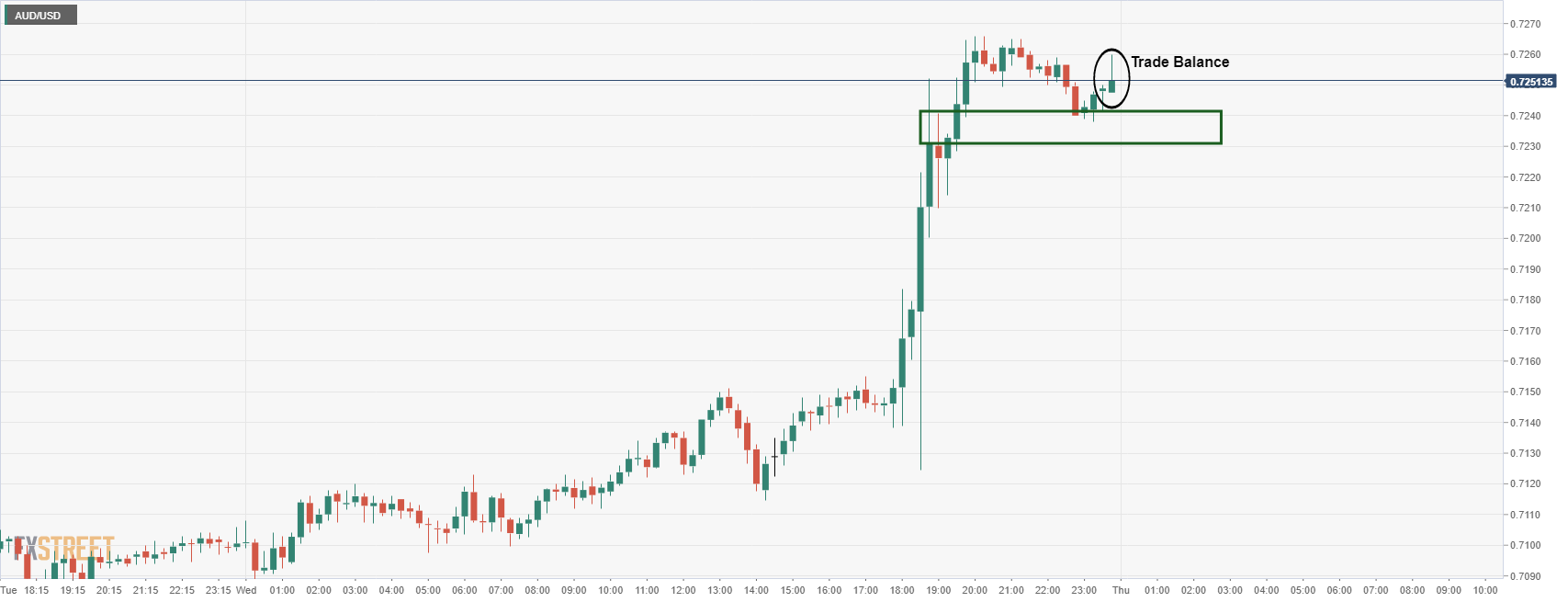
About Aussie Trade Balance
The trade balance released by the Australian Bureau of Statistics is the difference in the value of its imports and exports of Australian goods. Export data can give an important reflection of Australian growth, while imports provide an indication of domestic demand. Trade Balance gives an early indication of the net export performance. If a steady demand in exchange for Australian exports is seen, that would turn into a positive growth in the trade balance, and that should be positive for the AUD.
- Inventory distribution near 19-year high levels has marked a bearish reversal in the counter.
- The 20-and 50-EMAs are scaling lower, which adds to the downside filters.
- Momentum oscillator RSI (14) has shifted into a bearish range of 20.00-40.00.
The US dollar index (DXY) has witnessed a steep fall after failing to sustain above the round level support of 103.00. The DXY plunged sharply after the Federal Reserve (Fed) announced its monetary policy on Wednesday. The asset printed its 19-year high at 103.93 and faced a tad longer consolidation has resulted in a bearish reversal.
The formation of a Symmetrical Triangle chart pattern at near 19-year high levels has turned into an intense sell-off for the asset. The downside break of a symmetrical triangle after a stellar bull run indicates inventory distribution in which institutional investors shift their inventory to retail participants.
The 20- and 50-period Exponential Moving Averages (EMAs) at 103.15 and 103.22 respectively are sloping downwards, which signals more weakness ahead.
Meanwhile, the Relative Strength Index (RSI) (14) has shifted into a bearish range of 20.00-40.00, which indicates a fresh leg of weakness in the counter.
A pullback towards the 20-EMA at 103.15 will be an optimal selling opportunity for investors, which will drag the asset towards Wednesday’s low at 102.46 followed by the round level support of 102.00.
On the flip side, bulls could regain control if the asset oversteps Wednesday’s high at 103.61. Fulfillment of the same will force the asset to reclaim a 19-year high and the round level resistance at 103.94 and 104.00 respectively.
DXY hourly chart
-637873108765560476.png)
In recent trade today, the People’s Bank of China (PBOC) set the yuan (CNY) at 6.5672 vs. the last close of 0.6090.
About the fix
China maintains strict control of the yuan’s rate on the mainland.
The onshore yuan (CNY) differs from the offshore one (CNH) in trading restrictions, this last one is not as tightly controlled.
Each morning, the People’s Bank of China (PBOC) sets a so-called daily midpoint fix, based on the yuan’s previous day closing level and quotations taken from the inter-bank dealer.
- Silver refreshes intraday high during two-day rebound, crosses short-term hurdle.
- RSI rebound from oversold territory adds to the bullish bias targeting 200-DMA.
- Bears need validation from 78.6% Fibonacci retracement to retake control.
Silver (XAG/USD) takes the bids to renew daily high around $23.25 during Thursday’s Asian session.
In doing so, the bright metal pierces the previous support line from late 2021 while extending Wednesday’s rebound from 78.6% Fibonacci retracement of (Fibo.) of an upside from December 2021 to March 2022.
Given the RSI rebound from the nearly oversold territory also favoring the buyers, XAG/USD is up for challenging the 200-DMA level surrounding $23.75. However, 61.8% Fibo. near $23.55, will test the immediate upside momentum.
Should the bullion prices rally beyond $23.75, March’s low around $24.00 will act as the last defense of bears.
On the flip side, pullback moves remain elusive until staying beyond the aforementioned support-turned-resistance line, at $23.05 by the press time.
Following that, the 78.6% Fibonacci retracement level near $22.55 and the monthly low near $22.10 could lure the silver bears.
Silver: Daily chart
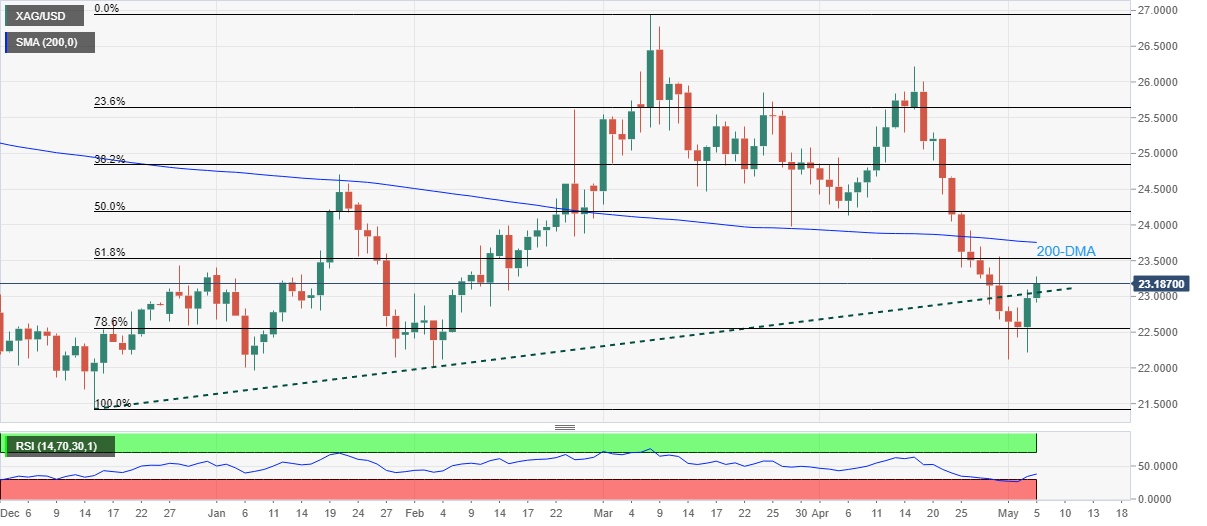
Trend: Further upside expected
- AUD/USD is facing a wall of weekly resistance.
- The bears are moving in and there is a focus on the hourly correction targets.
AUD/USD rallied on Wednesday following the Federal Reserve's less hawkish than an expected rate hike. The pair has shot up to test a key area of resistance on the longer-term charts as illustrated as follows:
AUD/USD weekly chart
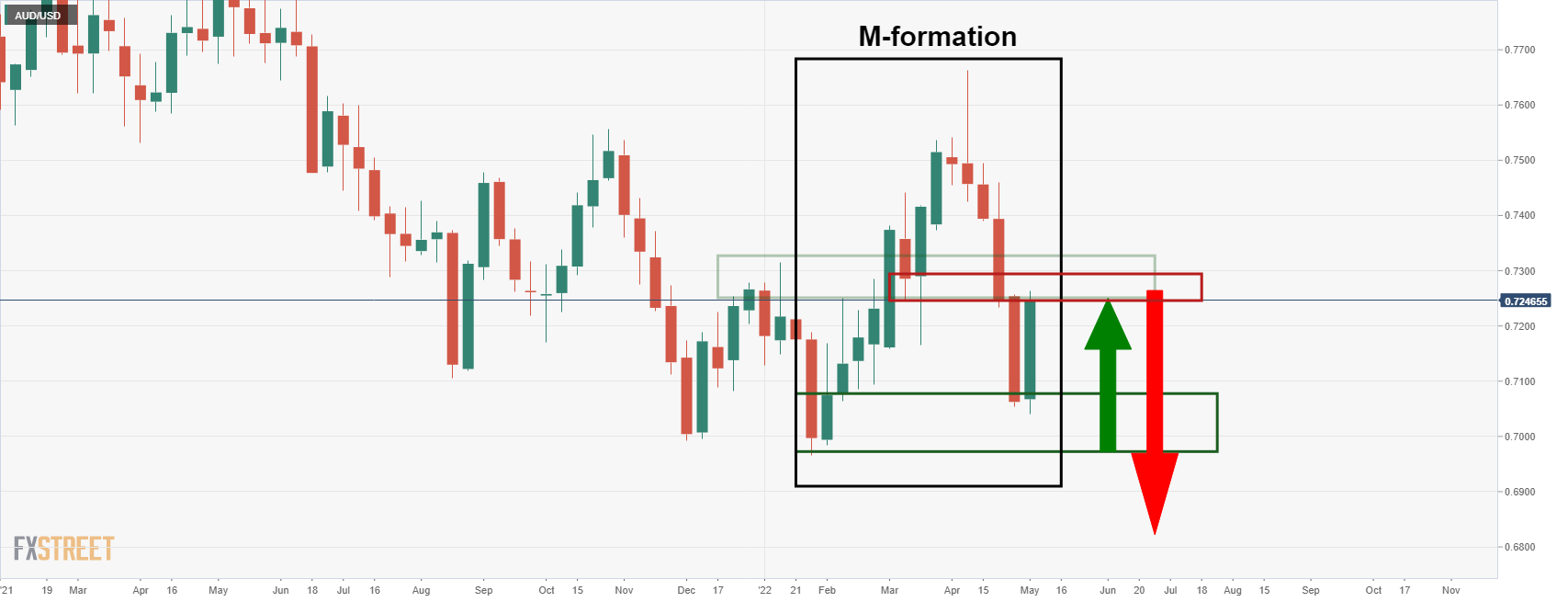
The M-formation is a reversion pattern and it has pulled in the price to test the neckline. At the time of writing, the pair is consolidating and a correction could be on the cards as traders await the end of the week's Nonfarm Payrolls key event.
USD/JPY H1 chart
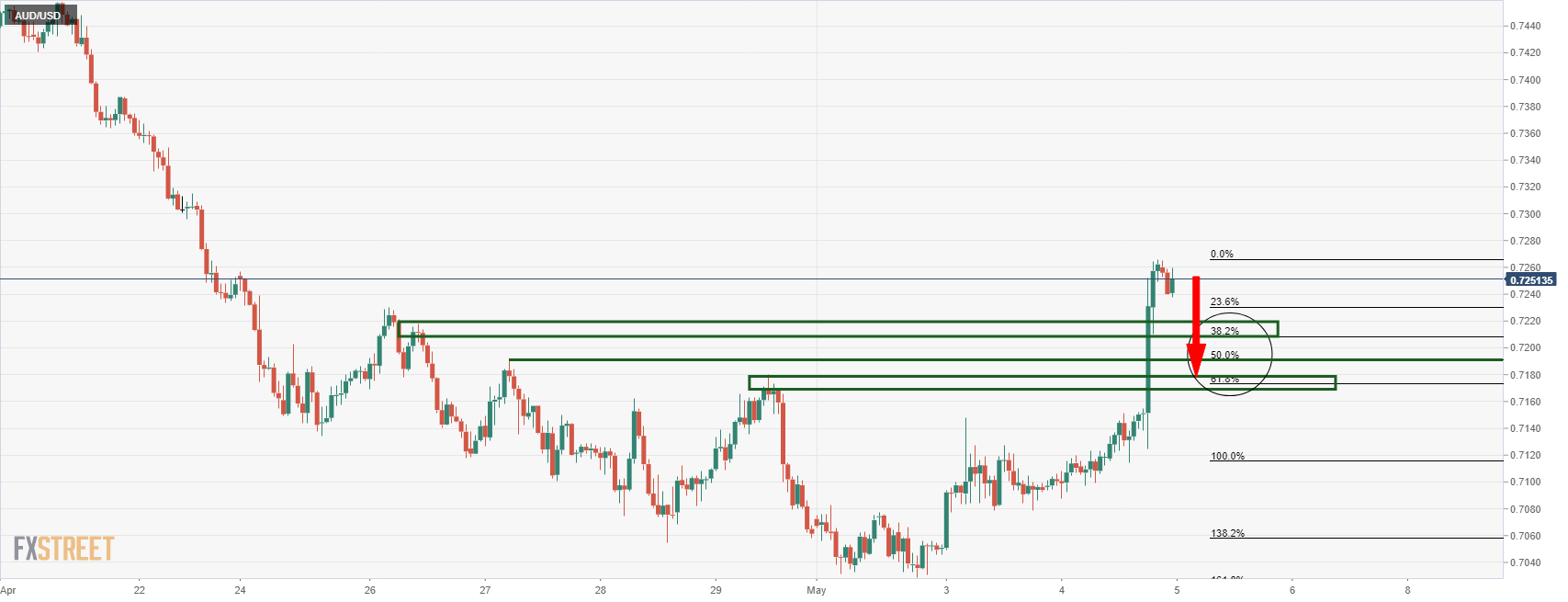
The price is starting to correct and the above structures are confluence between the Fibonacci scales and prior resistance areas on the hourly chart.
- Market sentiment dwindles as traders rethink over post-Fed optimism.
- China’s return, EU sanctions on Russia gain major attention.
- Anxiety ahead of BOE, US NFP also tests buyers after a volatile day.
Global markets remain on tenterhooks during early Thursday, after witnessing a raft of positive vibes after the Fed’s action. The cautious sentiment could be linked to the pre-event anxiety, as well as multiple geopolitical and covid-linked fears that regained attention.
While portraying the mood, S&P 500 Futures fade three-day rebound from yearly lows, down 0.08% to 4,292 by the press time. It’s worth noting, however, that the US Treasury yields remain depressed after a two-day downtrend as holidays in Japan restrict bond moves in Asia.
The European Union’s (EU) sixth round of sanctions on Russia and China’s covid woes seem to challenge the market sentiment as traders from Beijing return to the desk. Also challenging the mood are chatters surrounding Northern Ireland’s (NI) elections and Sino-American tussles.
Wall Street benchmarks rallied on an average of 3.0% after the US Federal Reserve’s (Fed) 50 basis points (bps) of a rate hike and signals of the quantitative tightening (QT) failed to impress bears. The reason could be linked to Fed Chair Jerome Powell’s rejection of a rate hike worth 75 basis points (bps) in upcoming meetings.
Also likely to have underpinned the bullish bias could be softer US data, mainly relating to services activities and private employment for April.
Looking forward, the second-tier US data and the Bank of England (BOE) monetary policy meeting will be important for fresh impulse as firmer economics and tighter monetary policies propel risk-aversion, helping the US dollar and weighing on the equities. Additionally, headlines concerning the aforementioned risk catalysts will also be important for clear directions.
Also read: Forex Today: Dollar plummets as the Fed is unwilling to become much more aggressive
- EUR/GBP has witnessed a pullback to near 0.8420 after intense selling pressure.
- Investors are waiting for the release of the monetary policy by the BOE.
- Euro bulls are underperforming amid weak Retail Sales.
The EUR/GBP pair has attracted some bids around 0.8400 after a significant sell-off from 0.8450. The cross tried hard to sustain above 0.8440 but failing to do so despite multiple attempts, dragged the asset lower to the round level support of 0.8400.
Pound bulls are waiting for the announcement of the monetary policy by the Bank of England (BOE) in the London session. BOE Governor Andrew Bailey is expected to spurt the interest rates by 25 basis points (bps). UK’s Consumer Price Index (CPI) number at 7% signifies a lot of inconveniences for households as higher energy bills and food prices have reduced the real income of the households already. It is worth noting that the BOE raised its policy rates by 50 bps in its last monetary policy meeting. The BOE is adopting a standard hawkish stance this time as a gradual rise would remain a better option to avoid any dramatic impact on the economy.
Meanwhile, the euro bulls are likely to remain uncertain as the European Union has spelled out plans to prohibit Russian oil within six months. Post-Russia’s invasion of Ukraine, the EU is determined to surrender its dependency on Russian oil. It would be interesting to watch out for how the EU will fulfill its bumper demand of 3.5 million barrels daily without Russian oil.
Apart from that underperformance of Euro Retail Sales, released on Wednesday has dented the euro’s demand. The Retail Sales landed at 0.8% lower than the market consensus of 1.4% and the prior print of 5.2%.
- NZD/USD dribbles around intraday high after rising the most since November 2018.
- Descending trend line from April acts as an immediate support-turned-resistance.
- Bullish MACD signals and sustained trading beyond 50-SMA keep buyers hopeful.
NZD/USD bulls jostle with a short-term key hurdle surrounding 0.6550 amid Thursday’s Asian session, following the biggest daily jump in over three years.
However, bullish MACD signals and the Kiwi pair’s ability to stay beyond the 50-SMA hint at the further advances, by crossing the immediate resistance line surrounding 0.6560.
That said, a downward sloping trend line from early April, around 0.6615 by the press time, will challenge the NZD/USD pair’s run-up beyond 0.6560.
Following that, the 100-SMA and the 200-SMA, respectively around 0.6635 and 0.6780, could act as the last defenses for the buyers.
On the contrary, a downside break of the 50-SMA, around 0.6510, will recall the NZD/USD sellers.
In that case, the 0.6465-55 horizontal area will probe the bears before directing them to the monthly low, also the lowest since mid-2020, around 0.6410.
NZD/USD: Four-hour chart
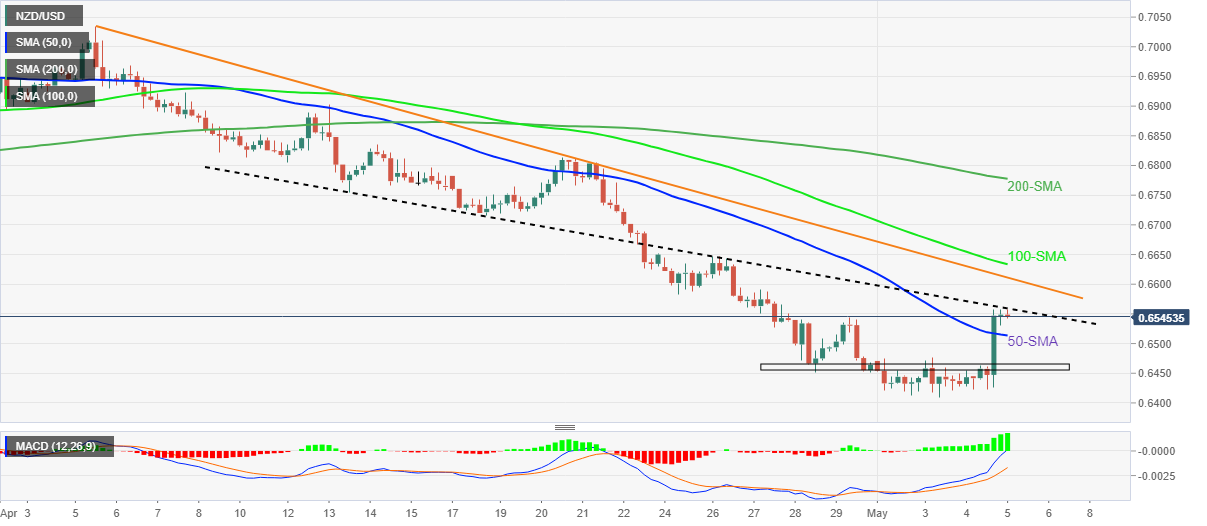
Trend: Further upside expected
| Index | Change, points | Closed | Change, % |
|---|---|---|---|
| Hang Seng | -232.37 | 20869.52 | -1.1 |
| KOSPI | -2.89 | 2677.57 | -0.11 |
| ASX 200 | -11.5 | 7304.7 | -0.16 |
| FTSE 100 | -67.85 | 7493.45 | -0.9 |
| DAX | -68.65 | 13970.82 | -0.49 |
| CAC 40 | -80.5 | 6395.68 | -1.24 |
| Dow Jones | 932.27 | 34061.06 | 2.81 |
| S&P 500 | 124.69 | 4300.17 | 2.99 |
| NASDAQ Composite | 401.1 | 12964.86 | 3.19 |
| Pare | Closed | Change, % |
|---|---|---|
| AUDUSD | 0.7254 | 2.19 |
| EURJPY | 137.178 | 0.14 |
| EURUSD | 1.06227 | 0.94 |
| GBPJPY | 163.134 | 0.32 |
| GBPUSD | 1.26325 | 1.09 |
| NZDUSD | 0.65377 | 1.58 |
| USDCAD | 1.27416 | -0.74 |
| USDCHF | 0.97234 | -0.63 |
| USDJPY | 129.167 | -0.74 |
- USD/JPY is on the verge of a break of daily and hourly support.
- The Fed has dialled back 75bps rate hikes which has weighed on the US dollar.
At 129.18, USD/JPY is higher by 0.1% and has moved between a low of 129.04 and 129.54 so far. However, the bears are moving in at the time of writing to challenge a significant hourly support structure as the US dollar continues to be pressured following the Federal Reserve.
The US dollar and US Treasury yields were under pressure following the Federal Reserve interest rate decision, statement and the Fed chair's presser. The US 2-year Treasury yield fell by some 5% to a low of 2.612%.
After hiking by 50bps today and formally starting quantitative tightening as the Fed seeks to get a grip on inflation, Jerome Powell gave the green light to a series of additional 50bp hikes but said 75bps was not something that was being considered.
The Federal Reserve is now "highly attentive" to inflation risks and amid “robust” job gains "ongoing increases" in the Fed funds rate will be "appropriate".
The Fed is starting quantitative tightening and the following is the press release with the Fed's plans for reducing the size of the balance sheet was released showing $47.5bn per month that will start on June 1st before getting to a "max" of $95bn in September:
The Committee intends to reduce the Federal Reserve's securities holdings over time in a predictable manner primarily by adjusting the amounts reinvested of principal payments received from securities held in the System Open Market Account (SOMA). Beginning on June 1, principal payments from securities held in the SOMA will be reinvested to the extent that they exceed monthly caps.
For Treasury securities, the cap will initially be set at $30 billion per month and after three months will increase to $60 billion per month. The decline in holdings of Treasury securities under this monthly cap will include Treasury coupon securities and, to the extent that coupon maturities are less than the monthly cap, Treasury bills.
For agency debt and agency mortgage-backed securities, the cap will initially be set at $17.5 billion per month and after three months will increase to $35 billion per month.
The downside in the greenback following the announcements as the Fed delivered the expected 50bp hike was exacerbated when Powell took 75bps rate hikes off the table. This is giving risk appetite a boost and the euro is making a case for a significant multi-week correction that could take place between now and the next meeting in June.
DXY technical analysis
As a consequence, the DXY index which is calculated by factoring in the exchange rates of six foreign currencies vs. the greenback is set up for a move that could extend as far as 101.00 in the coming days/weeks:

The M-formation is a bullish reversion pattern where the price would be expected to retest the neckline, prior to a more significant move to the downside and towards the old resistance structure. However, much will depend on this week's Nonfarm Payrolls data.
''The US payrolls likely stayed solid in April, posting a similar net job gain to that of March,'' analysts at TD Securities said. ''That would be consistent with a gradual slowing of job creation following the 600k average in the six months prior to March. We look for wages to have advanced 0.3% MoM.''
USD/JPY technical analysis
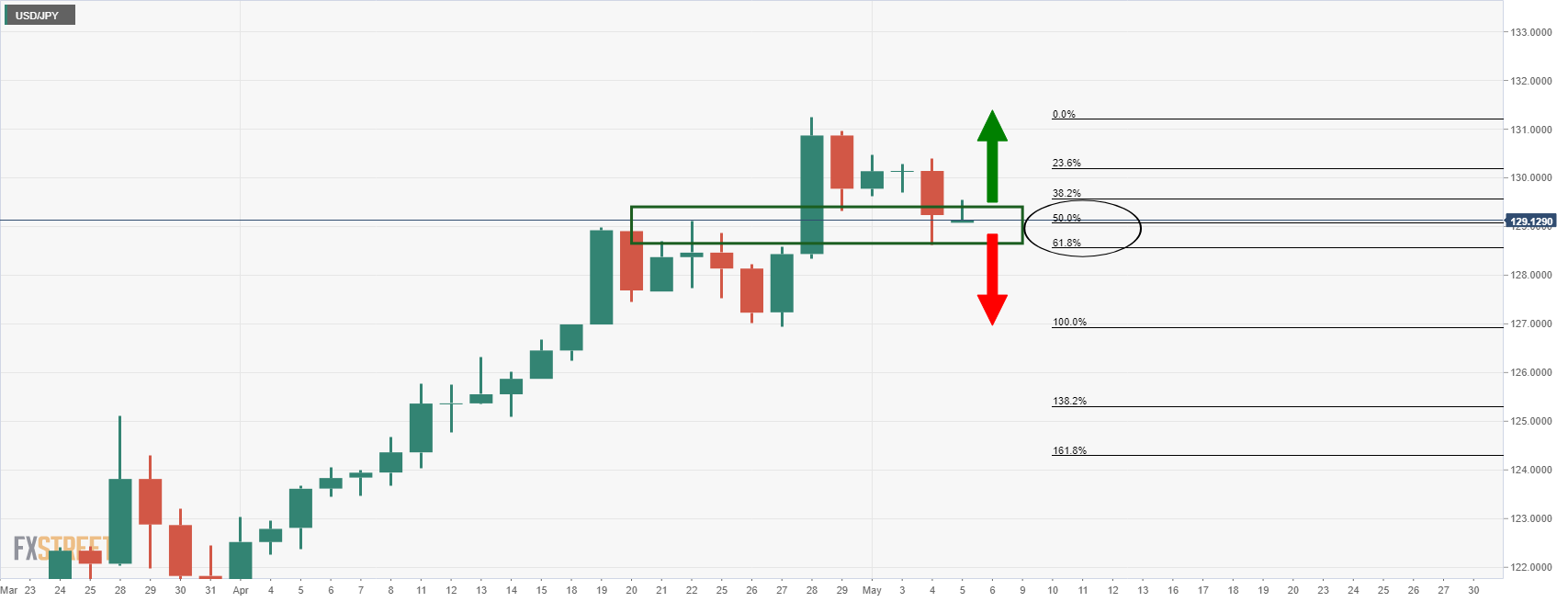
The price is taking on the daily support in a 61.8% ratio correction as illustrated above. However, the hourly support, as below, needs to give if the bears are going to make a break for it. Failures could lead to a bullish continuation in due course.
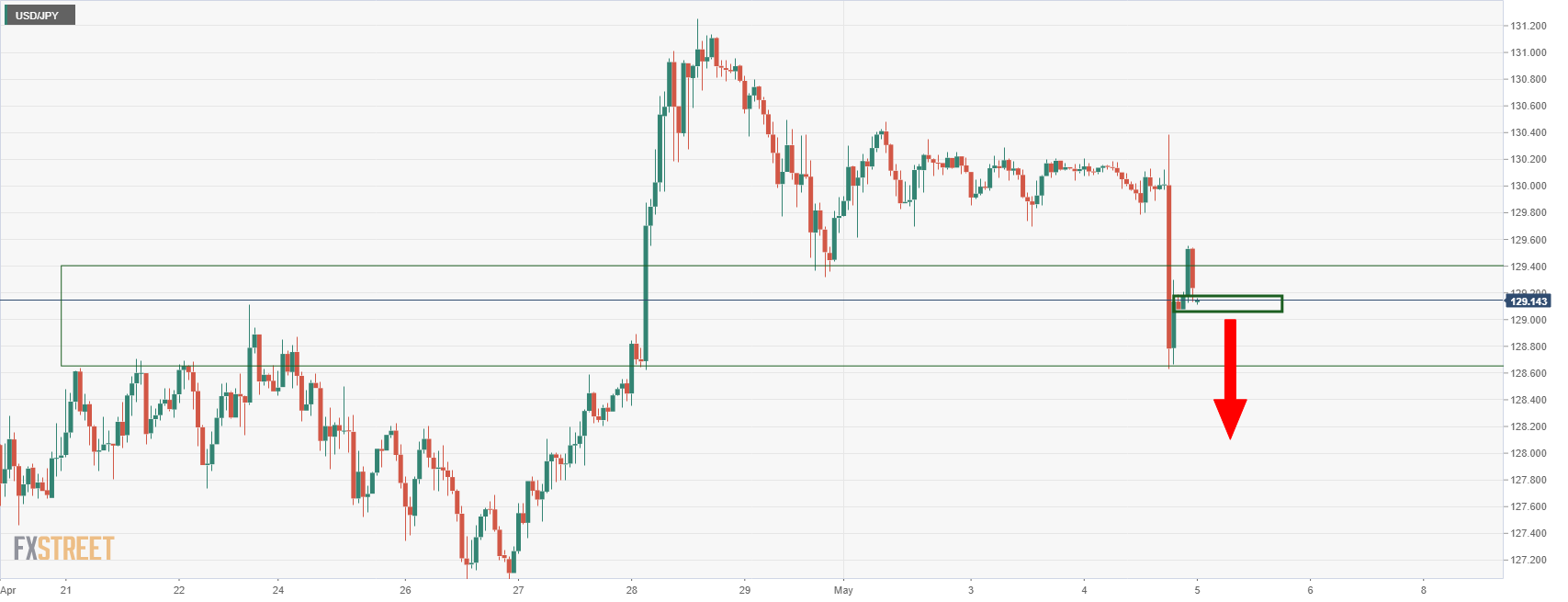
GBP/USD pares the biggest daily gains since April 2021, defending the 1.2600 threshold during Thursday’s Asian session, as cable traders await the Bank of England (BOE) monetary policy decision.
Read: BOE Preview: A 25 bps rate hike can’t save GBP bulls amid economic gloom
In doing so, the quote ignores the bullish bias of the options market, as portrayed by the one-month risk reversal (RR). That said, the gauge of calls to puts prints the week’s biggest daily figure, worth 0.287, while showcasing the positive expectations from the GBP/USD. Not only that but the weekly RR is also up for the heaviest run-up in three with a 0.212 level and keeps the buyers hopeful.
It’s worth noting, however, that the market’s expectations from the BOE are more than what the “Old Lady” has already announced, which in turn could trigger the GBP/USD pair’s pullback in case the British central bank disappoints bulls.
© 2000-2024. All rights reserved.
This site is managed by Teletrade D.J. LLC 2351 LLC 2022 (Euro House, Richmond Hill Road, Kingstown, VC0100, St. Vincent and the Grenadines).
The information on this website is for informational purposes only and does not constitute any investment advice.
The company does not serve or provide services to customers who are residents of the US, Canada, Iran, The Democratic People's Republic of Korea, Yemen and FATF blacklisted countries.
Making transactions on financial markets with marginal financial instruments opens up wide possibilities and allows investors who are willing to take risks to earn high profits, carrying a potentially high risk of losses at the same time. Therefore you should responsibly approach the issue of choosing the appropriate investment strategy, taking the available resources into account, before starting trading.
Use of the information: full or partial use of materials from this website must always be referenced to TeleTrade as the source of information. Use of the materials on the Internet must be accompanied by a hyperlink to teletrade.org. Automatic import of materials and information from this website is prohibited.
Please contact our PR department if you have any questions or need assistance at pr@teletrade.global.
